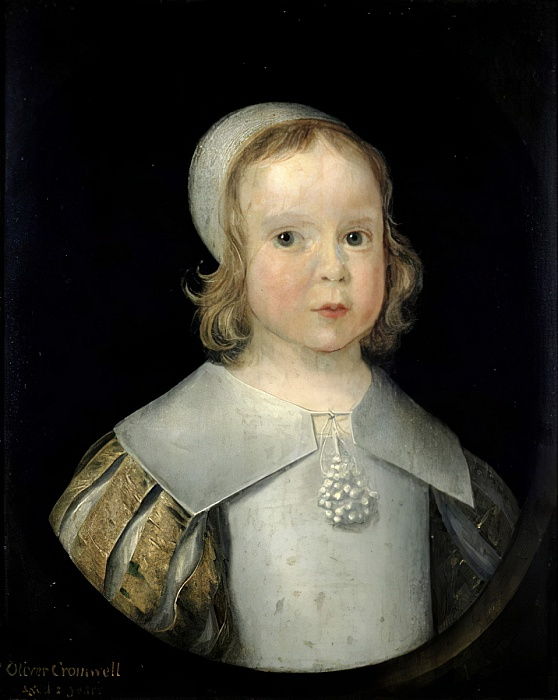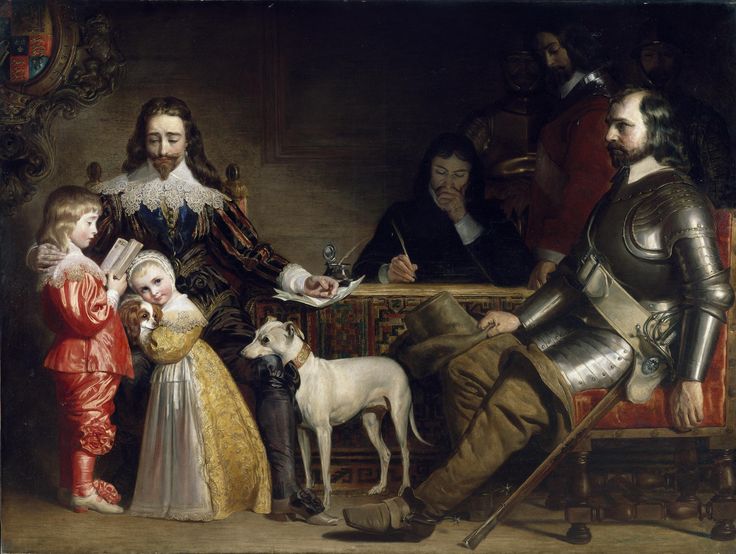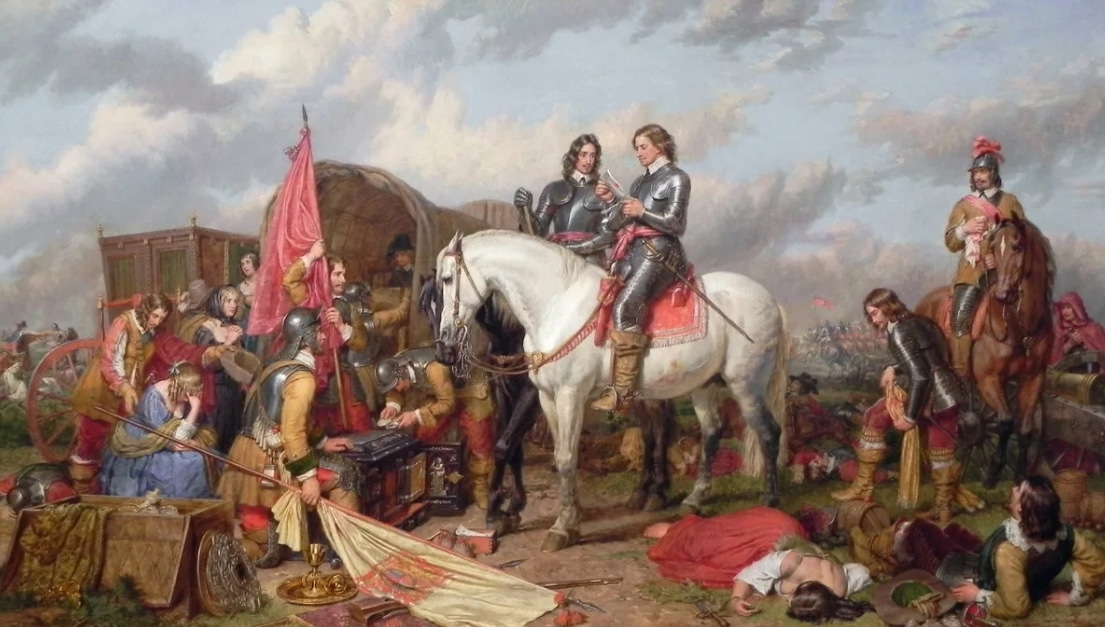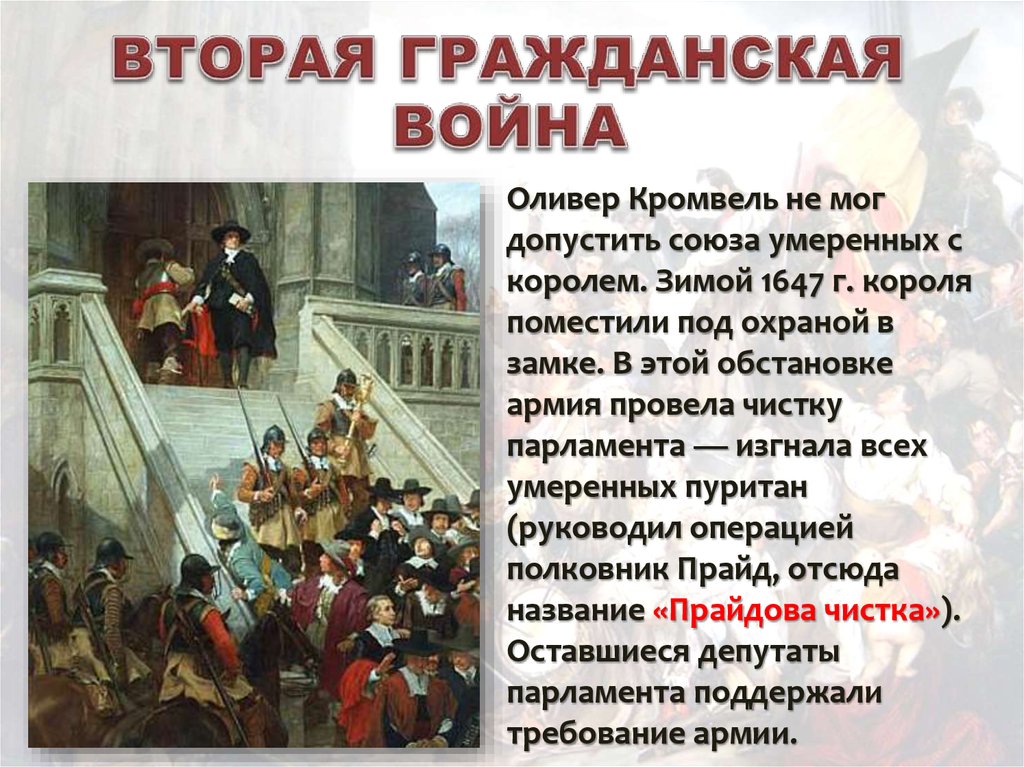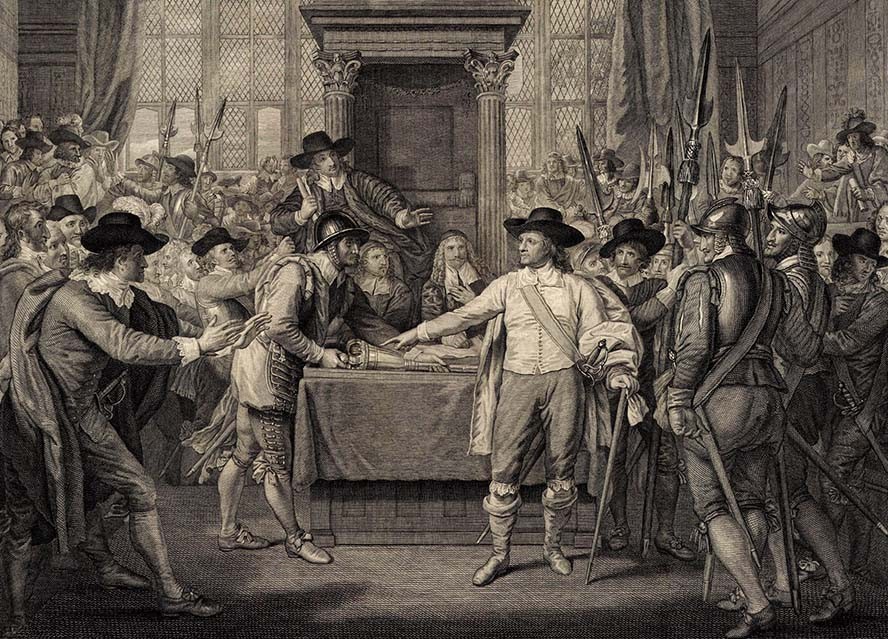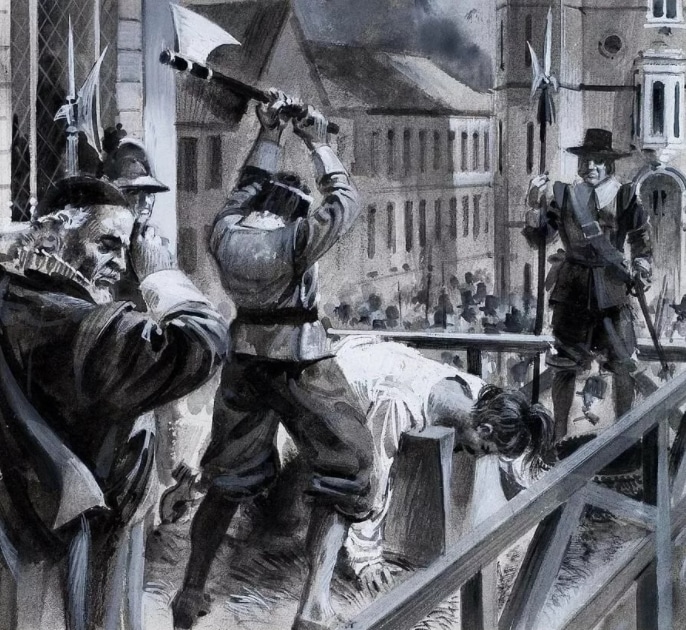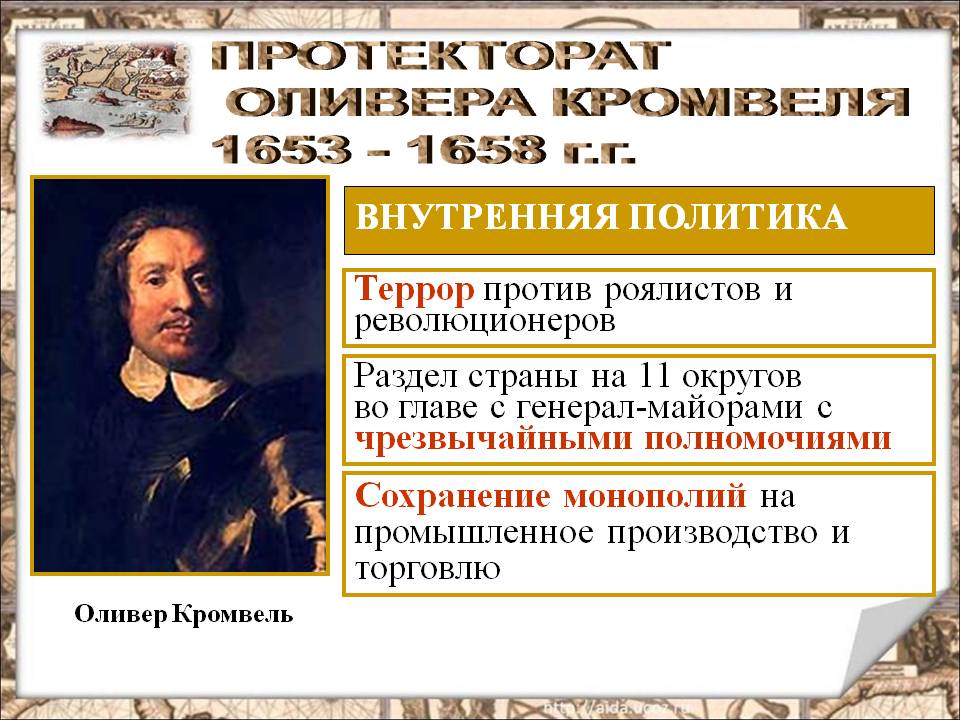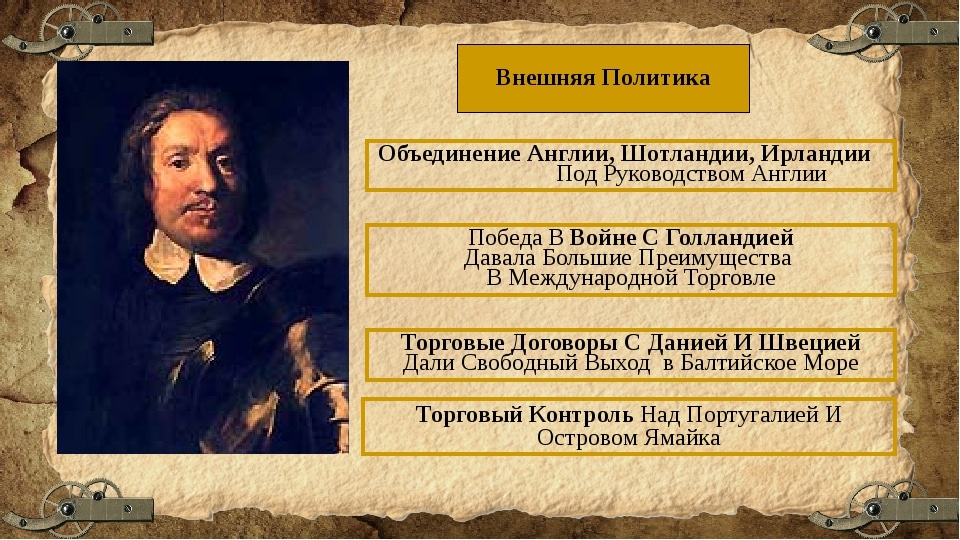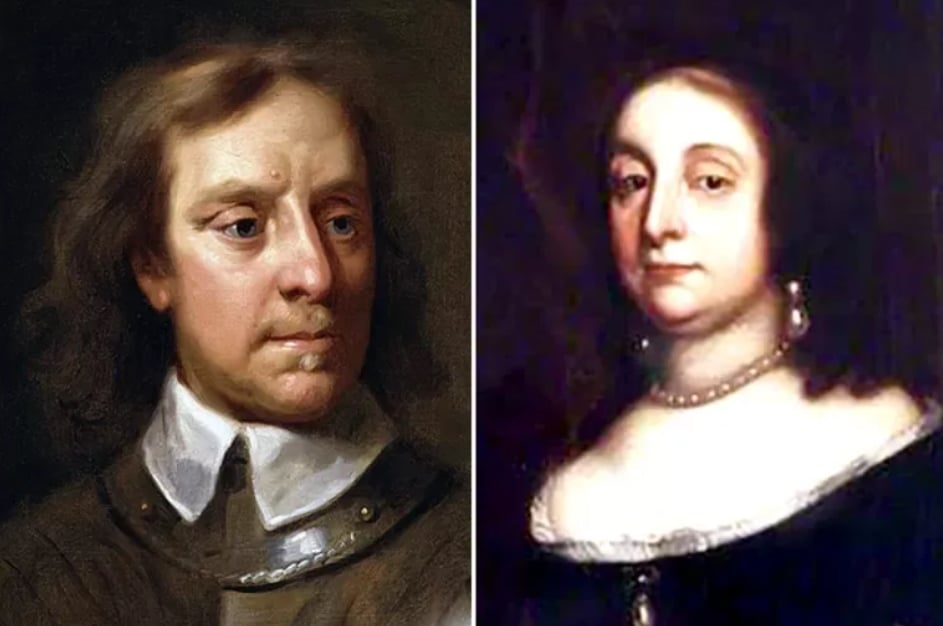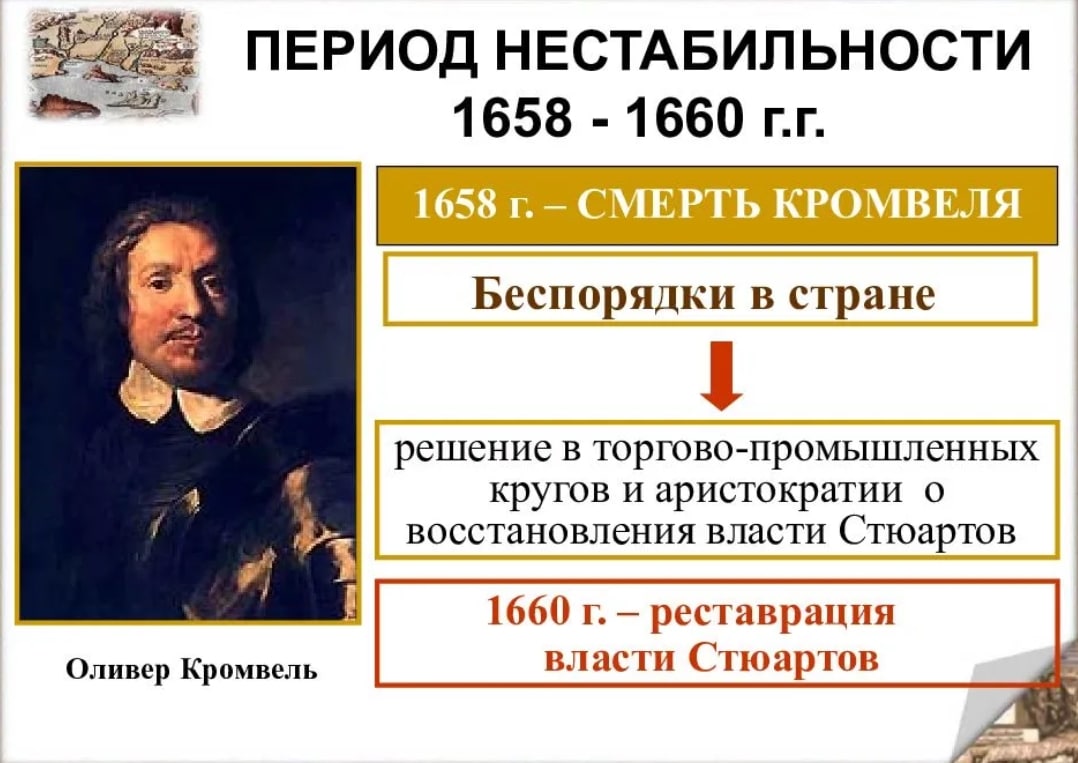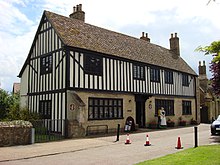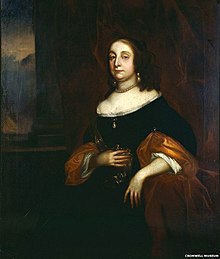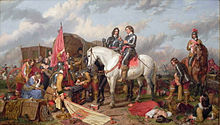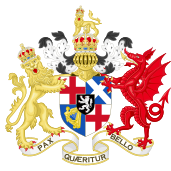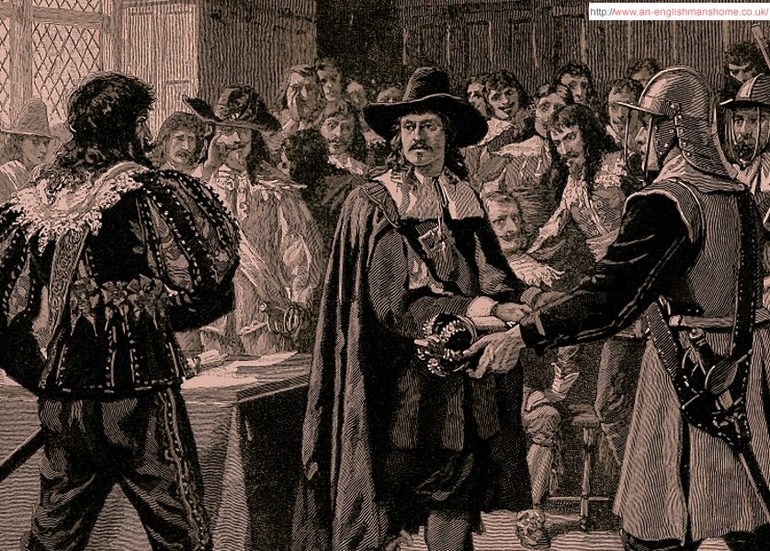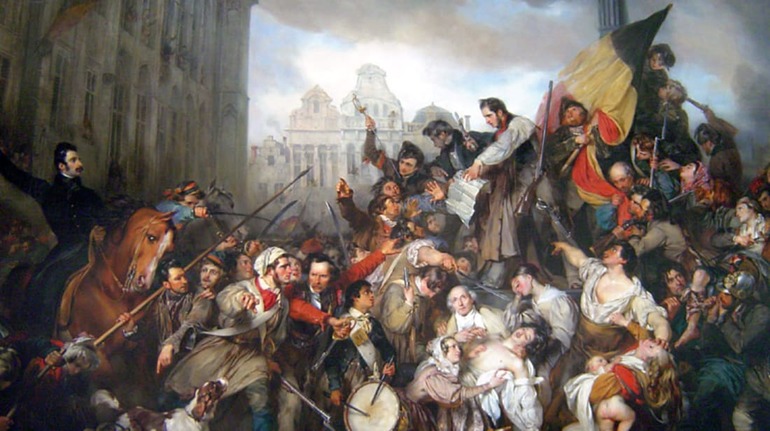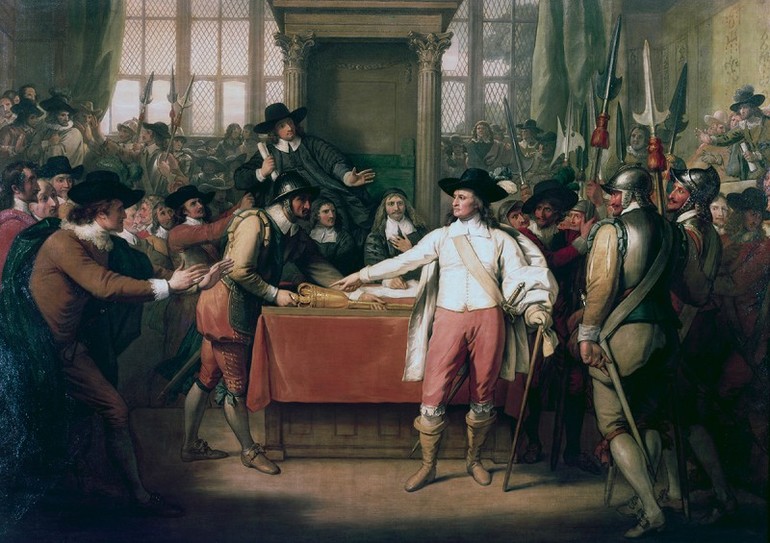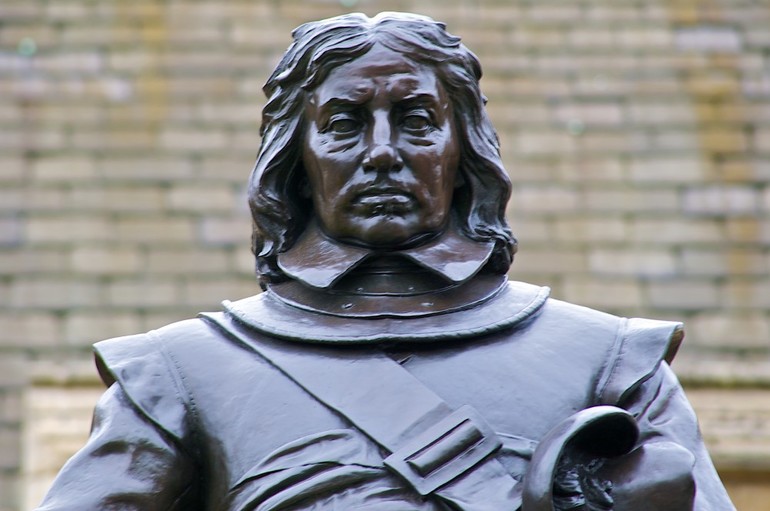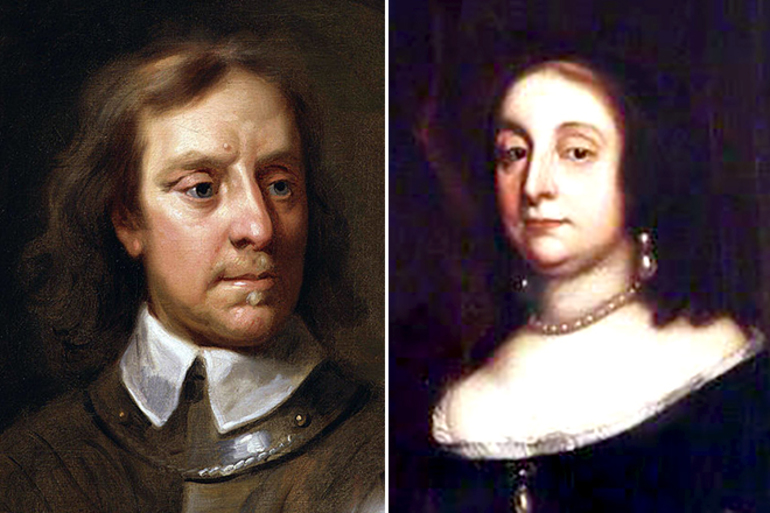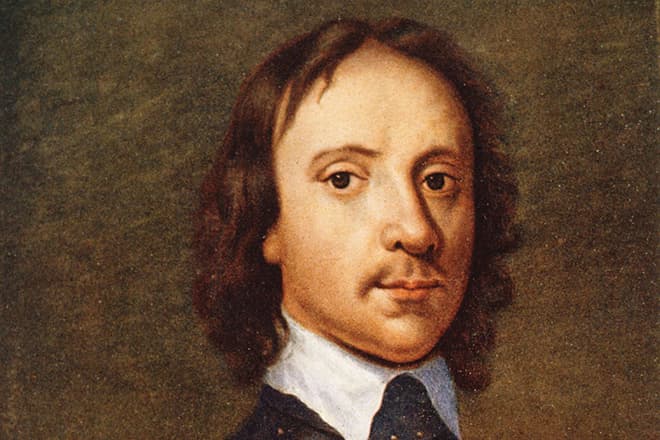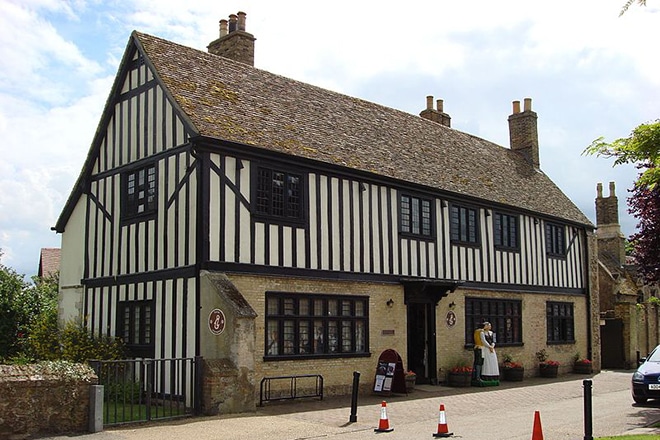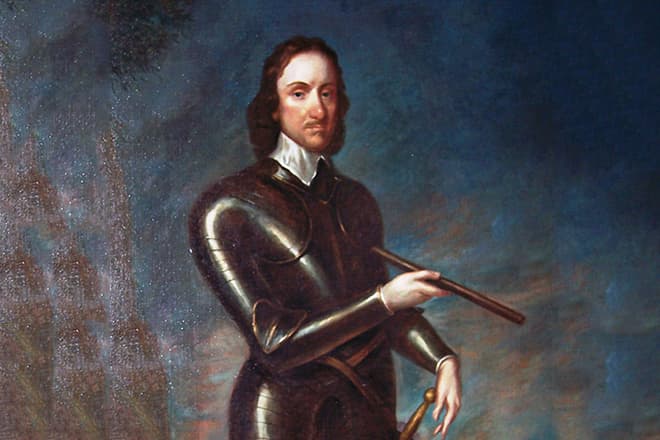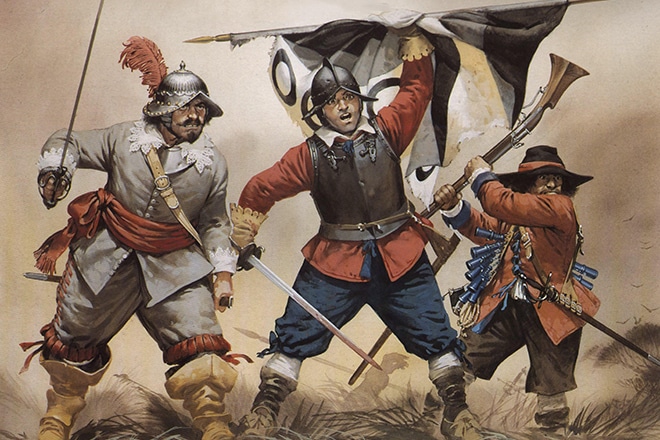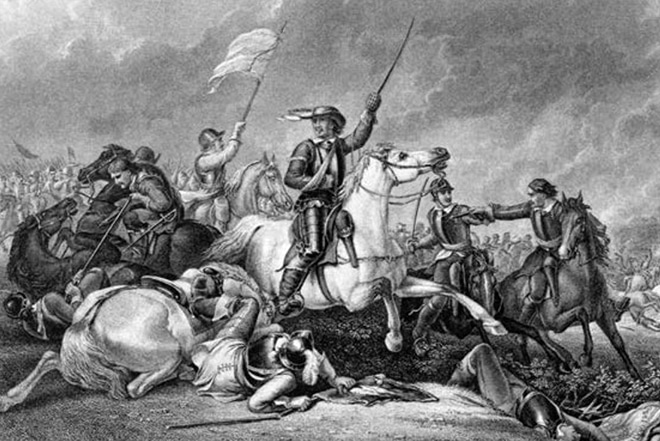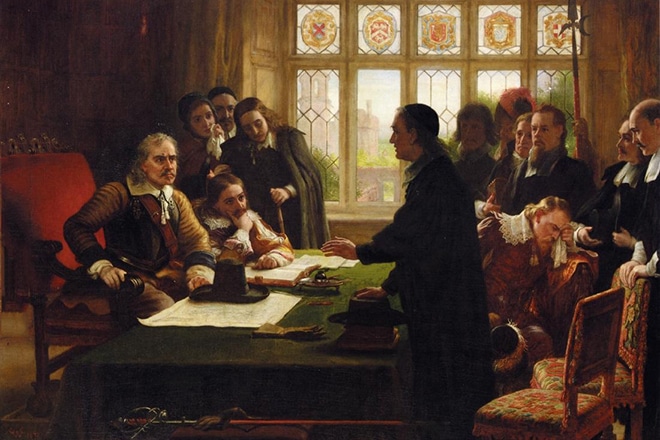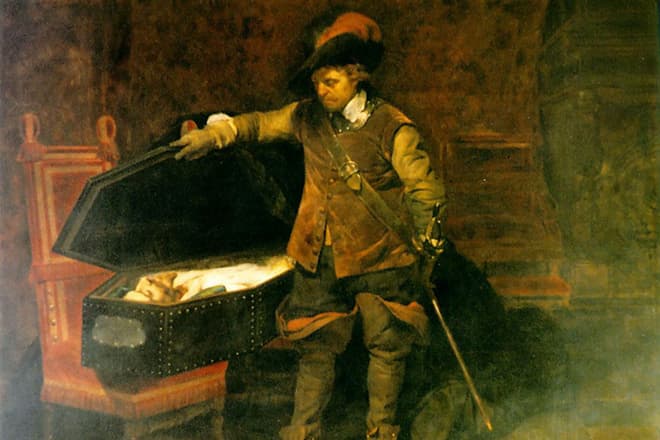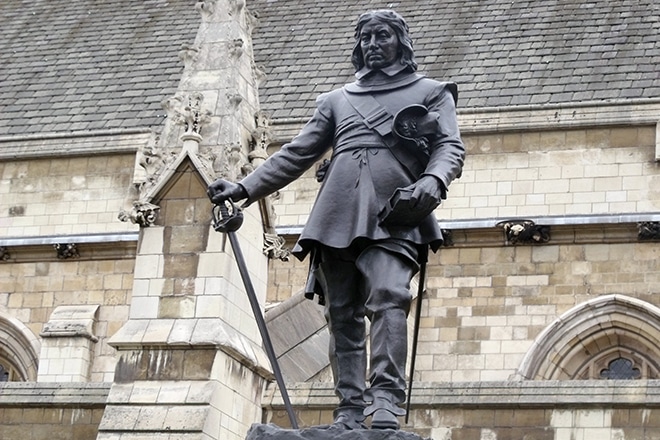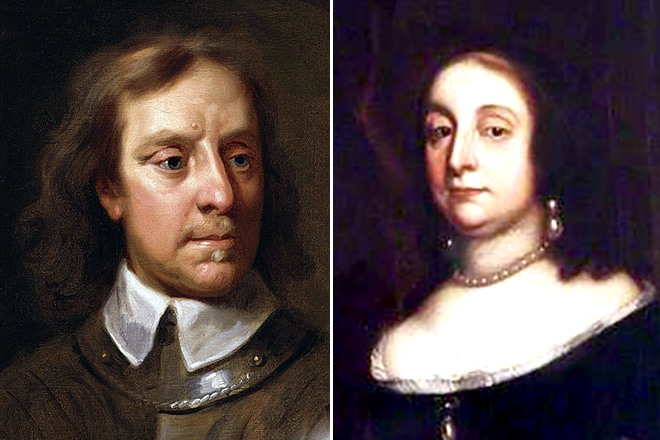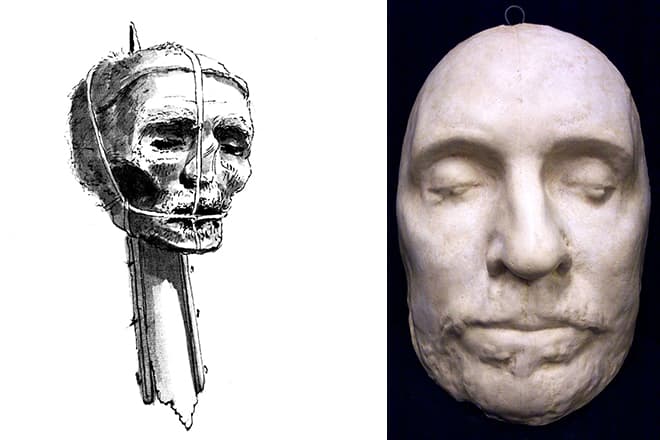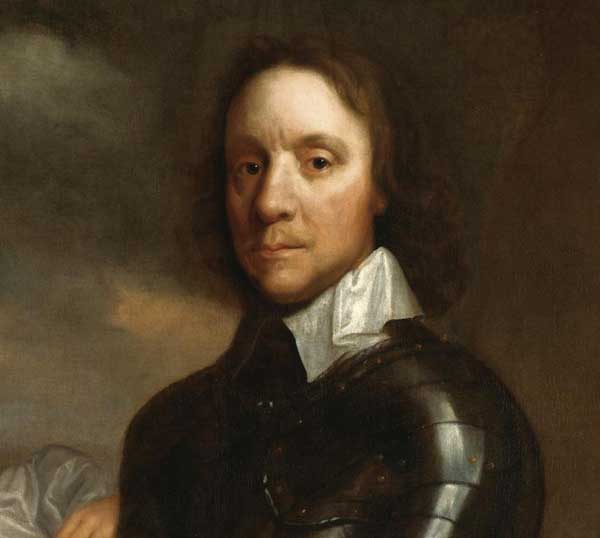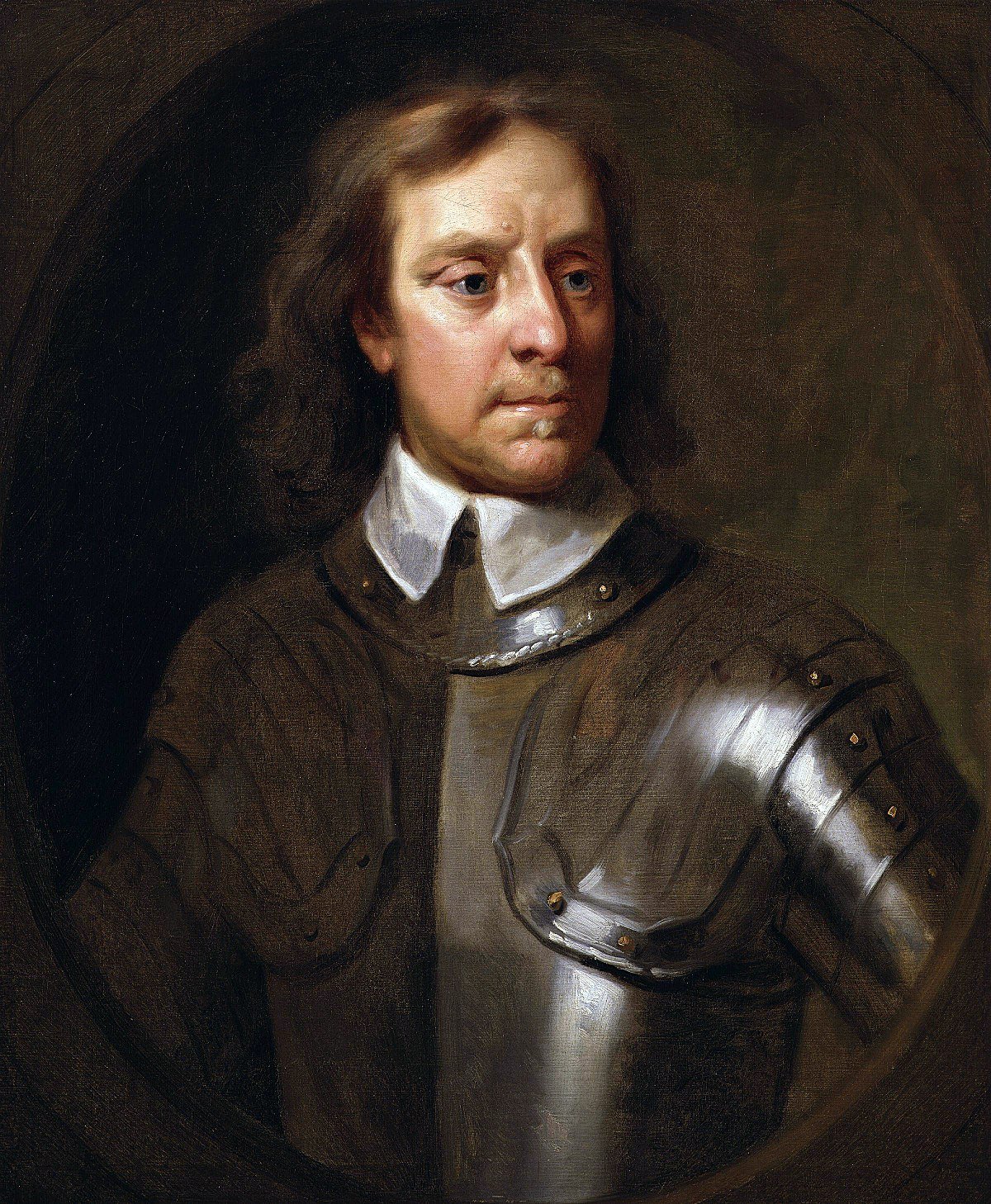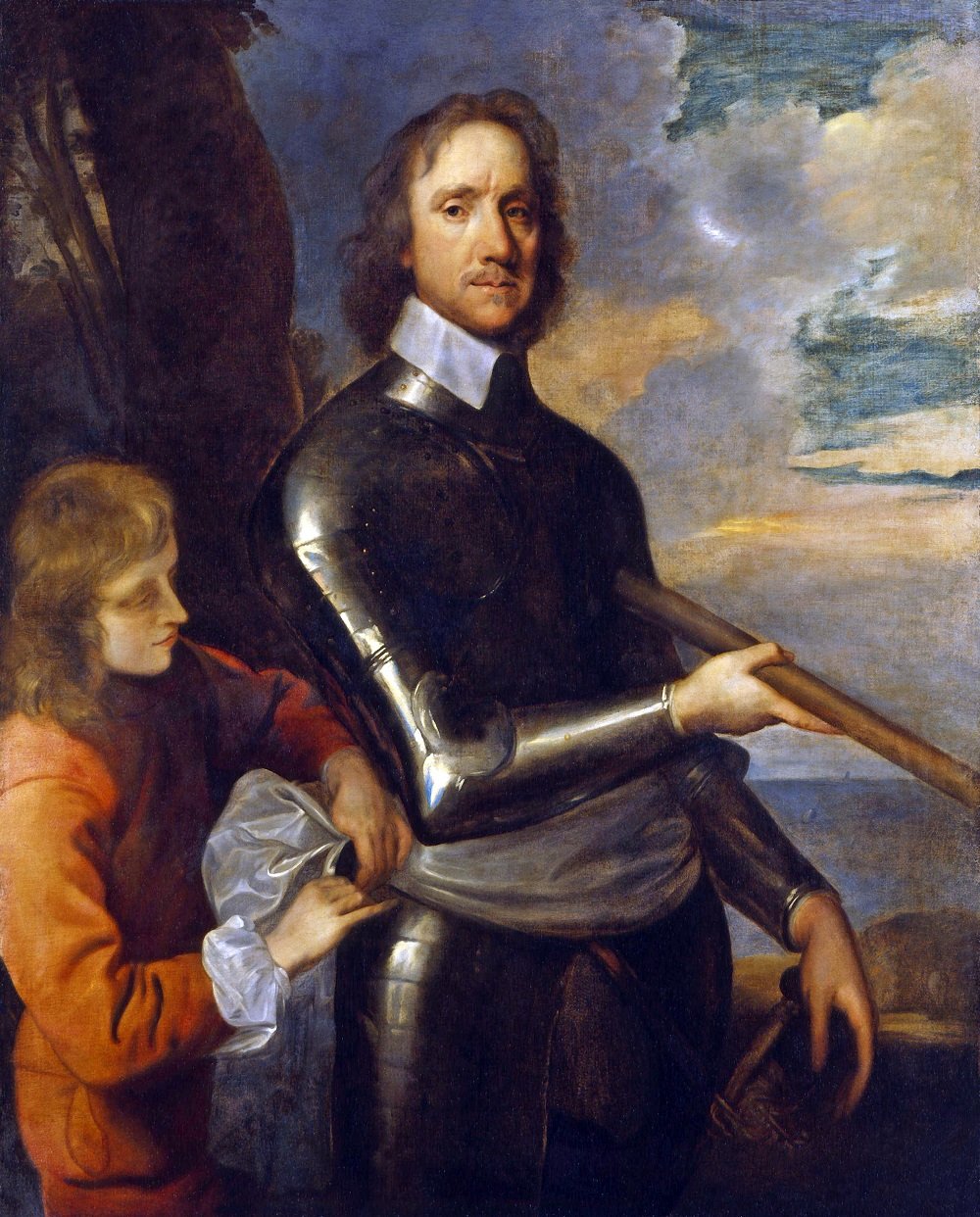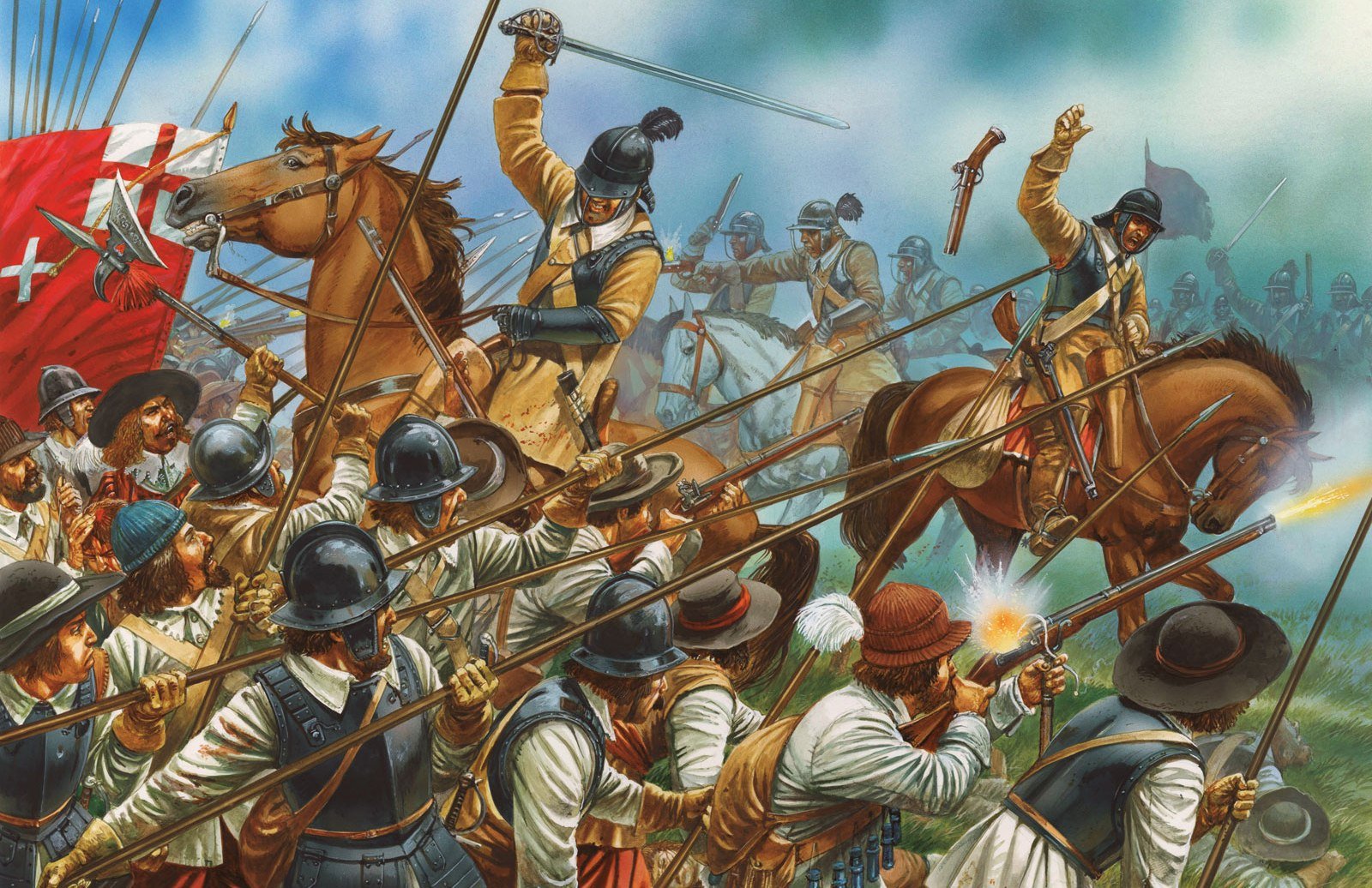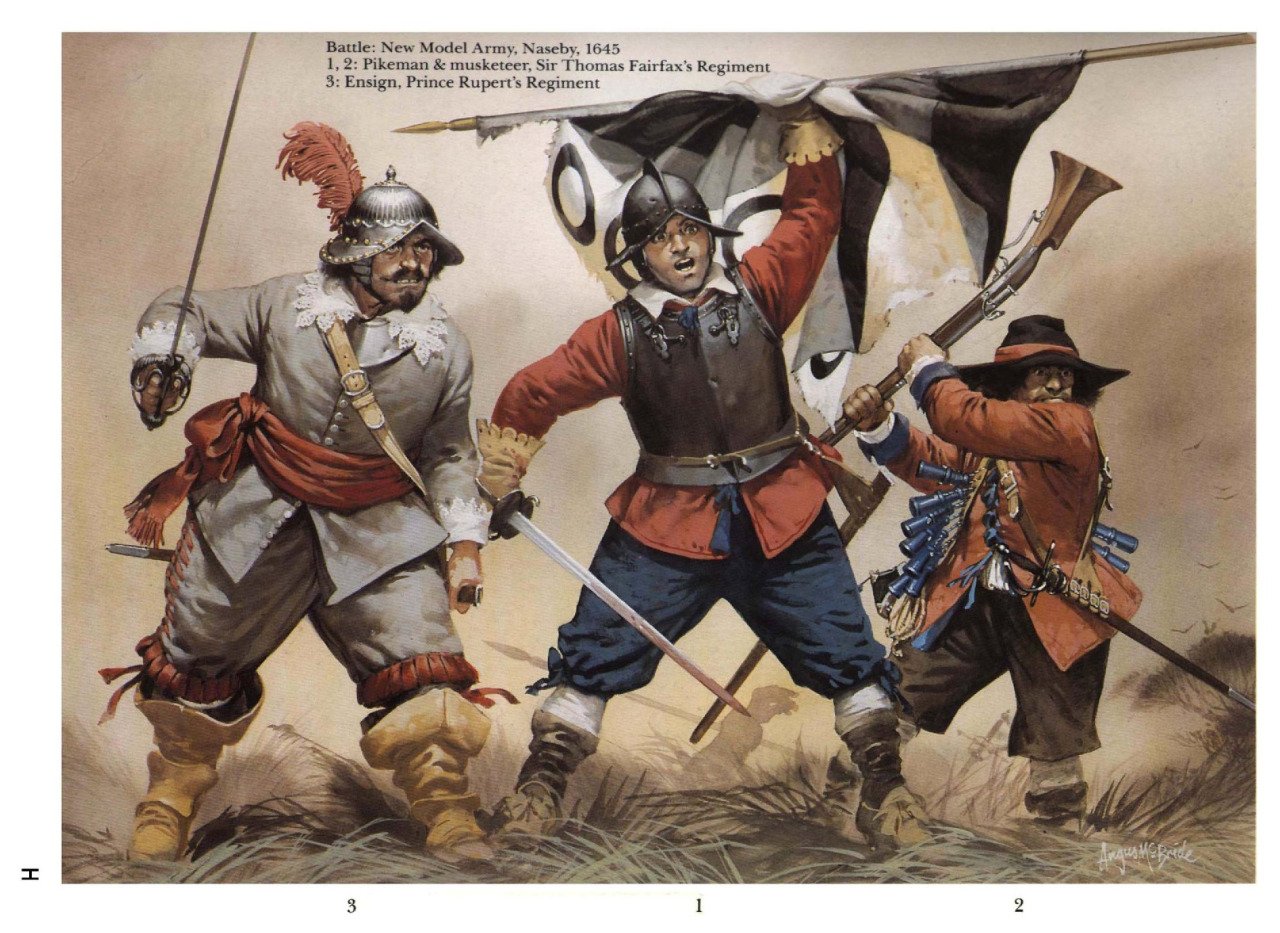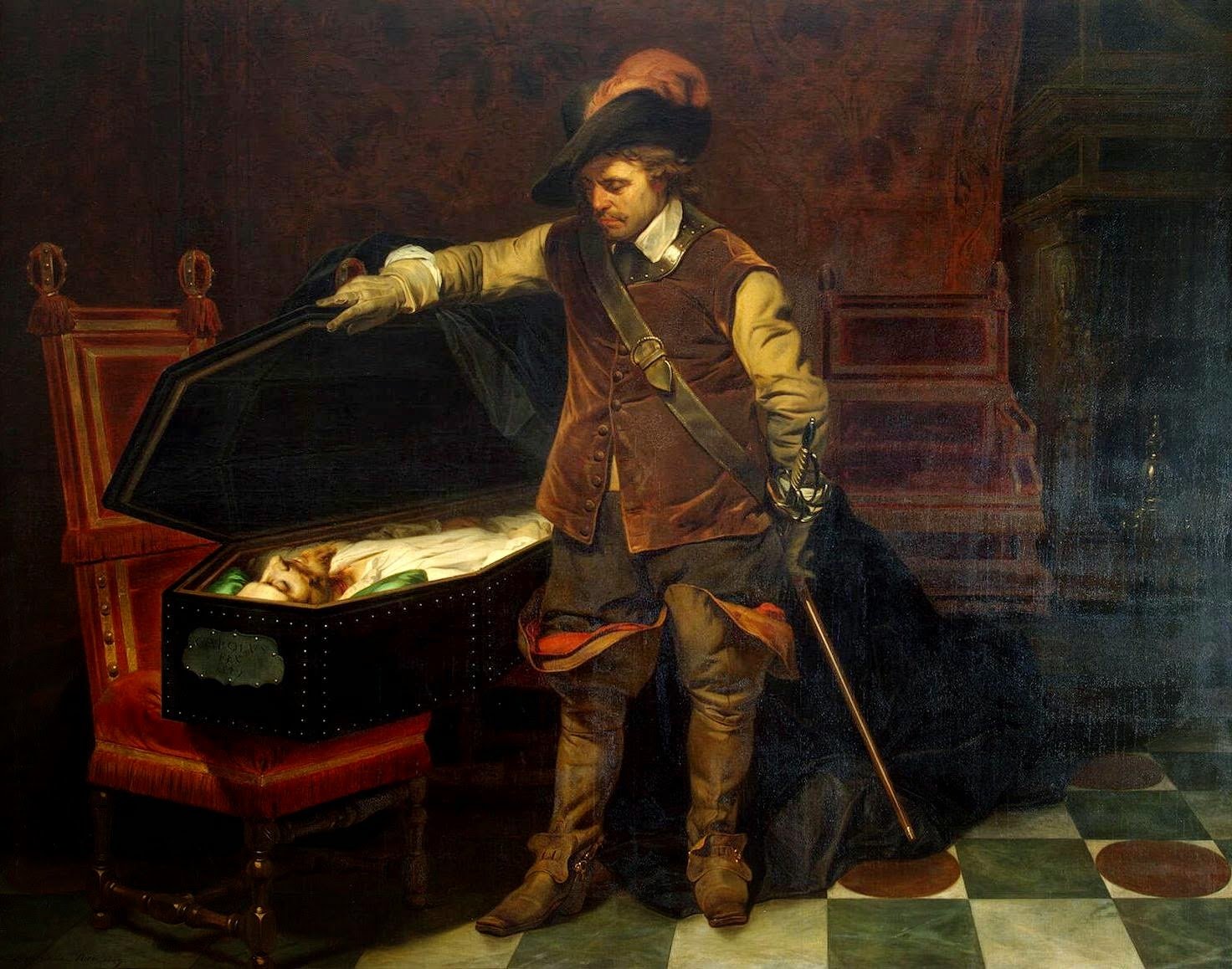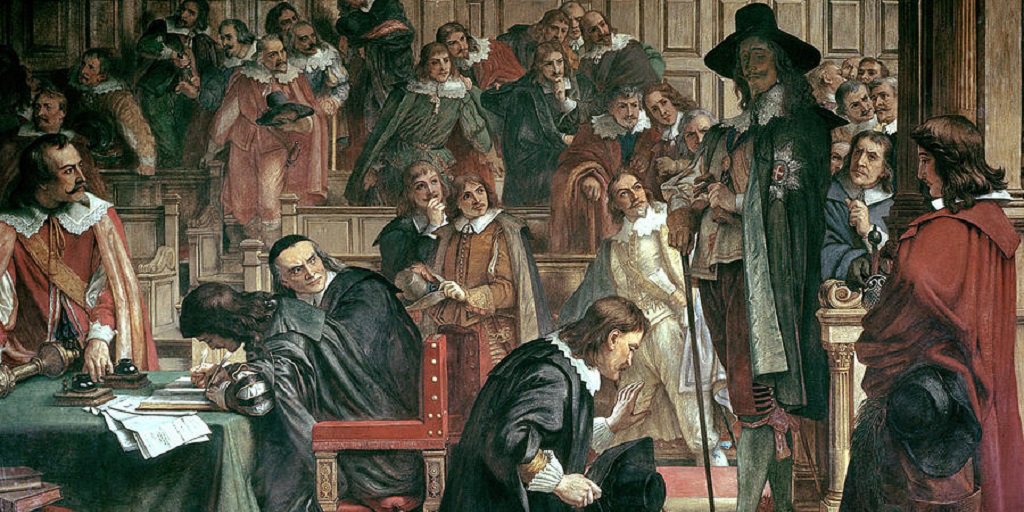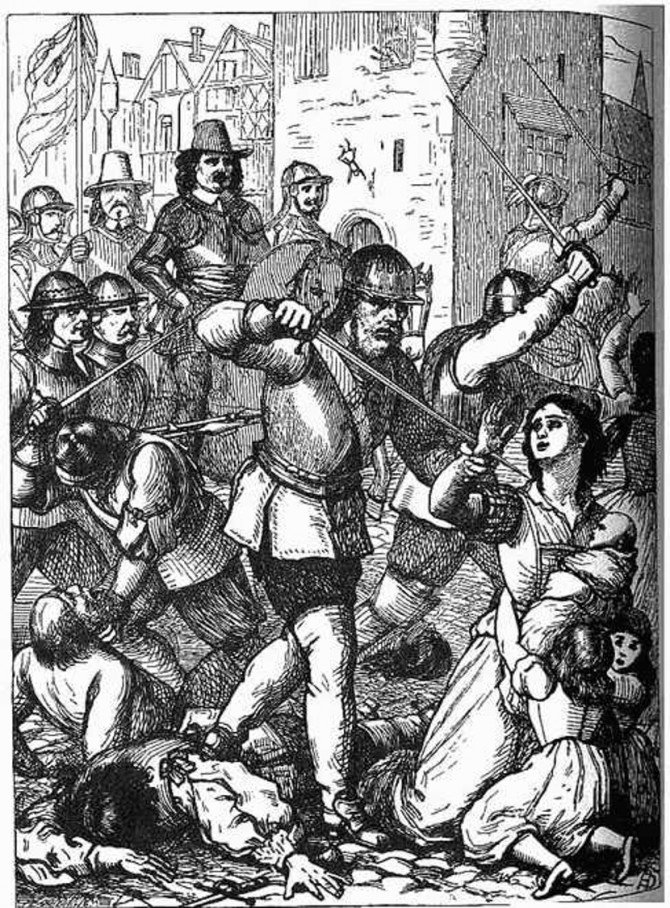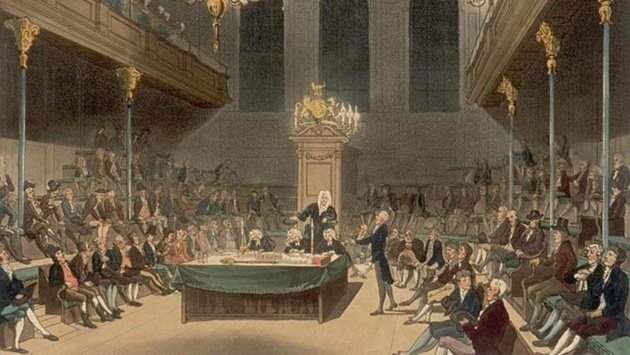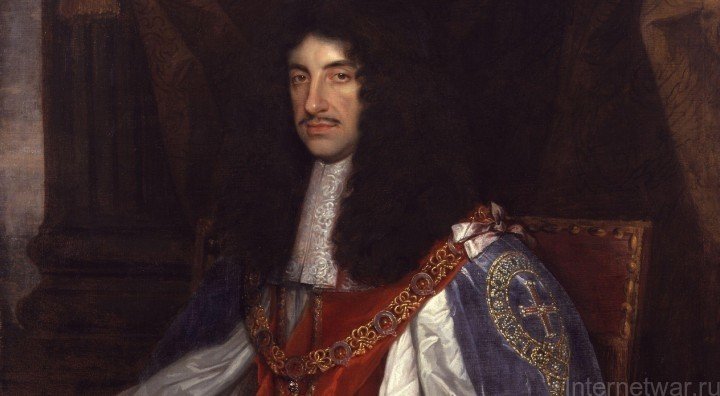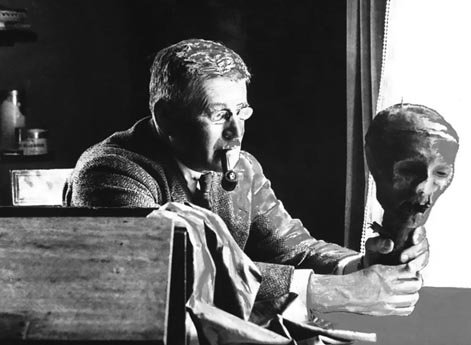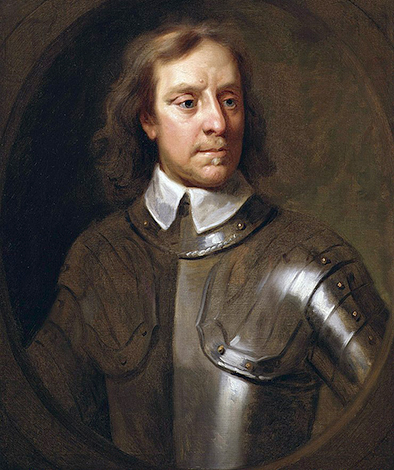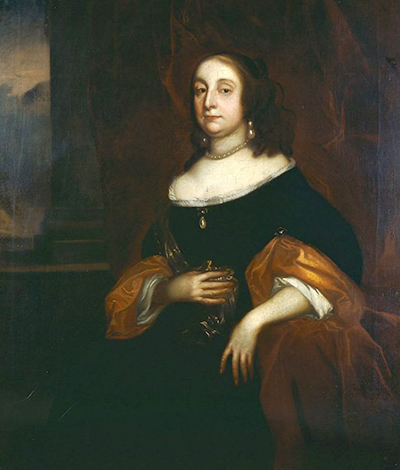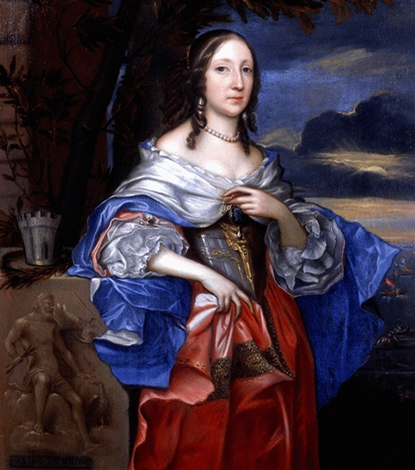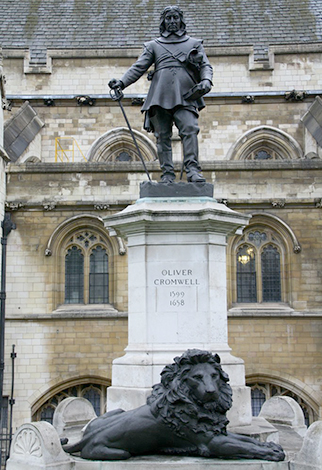Оливер Кромвель — биография
Оливер Кромвель – английский военачальник, политик. Одна из значимых фигур, повлиявших на ход истории Англии в 16-17 веках.
Оливер Кромвель – один из величайших английских военачальников 16-17 веков, государственный деятель. Историки часто называют его вождем индепендентов, возглавившим Английскую революцию. В поздние годы стал больше заниматься политикой, был удостоен почетных должностей лорд-протектора и лорд-генерала Англии, Шотландии и Ирландии.
Детство
Родился Оливер Кромвель в английском Хантингдоне 25 апреля 1599 года. Семья будущего полководца жила довольно скромно – родители Роберт Кромвель и Элизабет Стюарт были из небогатых английских дворян. Отец был продолжателем линии Томаса Кромвеля, сподвижника короля Генриха VIII и его соратника в реализации реформ. Правление этого короля помогло предкам Оливера нажить состояние на конфискации монастырских и церковных владений.
Маленький Кромвель обучался в приходской школе родного Хантингдона. Получив начальное образование, он поступил на юридический факультет в Сидней Сассекс – колледж, входящий в состав Кембриджского университета. В этом учебном заведении царил пуританский дух. Не окончив колледж, Оливер бросил учебу и взял в жены дочь соседа-помещика.
Это был вынужденный шаг, обусловленный смертью отца. Кромвелю-младшему пришлось делать выбор между получением образования и помощью матери-вдове и сестрам. Этот период биографии Оливера связан с ведением домашнего хозяйства: как любой добропорядочный сквайр, он готовил сыры, варил пиво, продавал шерсть и хлеб.
Политическая карьера
В 1628 году Кромвель начал заниматься политикой, избравшись в парламент по округу Хантингдона. Уже в феврале 1629 года молодой политик выступил с трибуны высшего органа законодательной власти. Суть выступления заключалась в защите и поддержке проповедников-пуритан. Однако, совсем скоро королем Карлом I было принято решение о роспуске парламента, и Оливеру пришлось на некоторое время забыть о карьере.
Следующие 11 лет Кромвель жил в своем поместье, ведя привычный образ жизни, занимаясь насущными делами. В 1636 году он принял участие в движении по защите крестьянских общин.
Прошло несколько лет, и Кромвель снова погрузился в политику своей страны, став депутатом от Кембриджского университета. В апреле 1640 года он был избран в Короткий, а в ноябре – в Долгий парламент Англии. В своих выступлениях с трибуны молодой политик горячо отстаивал интересы буржуазии и нового дворянства.
Английская гражданская война
Август 1642 года ознаменовался началом Английской революции. В этой войне король Карл I противостоял парламенту. Кромвель был в лагере парламентской армии — он имел в ней капитанский чин.
Оливер был противником собирать армию по принуждению. Ему хотелось, чтобы в нее вступали солдаты по собственным убеждениям, уверенные в божественном правосудии и необходимости борьбы с монархом. Солдат, для которых идея неотвратимости революции была близка к сердцу, он нашел в Восточной Англии, среди крестьян-йоменов.
Эти люди были из ярых пуритан, твердо выступающих против феодализма. Современниками армия Кромвеля была названа «железнобокой» — за стойкость солдат и исключительную дисциплину в ее рядах.
Полк нового военачальника прошел множество героических боев, за что Кромвель удостаивался все более высоких званий. Титул генерал-лейтенанта был получен им в 1644 году. Особо ярко полководец проявил свое искусство в сражениях при Марстон-Муре в июле 1644 года и у Нейзби в июне 1645 года. Стратегический гений Кромвеля в этих битвах имел решающую роль, без него ход истории мог бы пойти иначе.
Парламент одержал победу, и Англия начала свой путь перехода от абсолютной монархии к конституционной. Монарх более не являлся диктатором, единолично решающим политическую судьбу государства. Историки сходятся во мнении, что именно талант Кромвеля, уверенность в правоте, его организаторские способности и упорство определили ход противостояния парламентской армии королю.
Английская революция закончилась, и Кромвель выдвинул требование о необходимости реорганизации вооруженных сил страны. Он принял активное участие в создании армии нового типа, основой которой стали его «железнобокие» воины. Бесценный опыт полководца, полученный за годы гражданской войны, пригодился для создания мощной армии.
Вторая гражданская война
В период Первой гражданской войны Кромвель был приверженцем сил, олицетворяющих революционную демократию. Однако, после победы парламента над монархом, он счел целесообразным отказаться от радикализма и вести более умеренную политическую линию. Это привело к серьезным разногласиям с левеллерами, недовольными итогами Английской революции и жаждущими продолжения войны.
В 1647 году великий стратег попал под давление сразу трех серьезных политических сил – короля, армии и пресвитерианской части парламента. Ситуацию нужно было как можно скорее решать. Кромвелю ничего не оставалось, как из полководца превратиться в хитрого политика, в руках которого два мощных инструмента – армия и тайный союз с королем.
Вскоре Карл I был взят в плен армией. Кромвелю не оставалось другого выхода, как пытаться провести переговоры с королем, в ходе которых обсуждались условия сохранения монархии. Радикально настроенные левеллеры расценили это, как предательство. Попытки политика объединить противоборствующие стороны не увенчались успехом, и в 1648 году началась Вторая Английская революция.
Во время этой гражданской войны Оливер Кромвель был ярым противником роялистов. Ему пришлось заключить союз с левеллерами, с целью укрепить свою армию. Осенью 1648 года он бился с роялистами в северной части Англии и в Шотландии. Вскоре его бойцы взяли Эдинбург, и мирный договор был победоносно подписан. После завершения сражений, уже будучи в Лондоне, Кромвель приложил все усилия, чтобы очистить палату общин от последователей роялистов.
Казнь короля в 1649 году прошла с согласия Оливера Кромвеля. Монархия была уничтожена, Англия стала республиканским государством.
Власть теперь принадлежала «шелковым» индепендентам, во главе которых стоял Кромвель. Правил политик жестко и бескомпромиссно: на корню подавлял любые попытки бунта, явился организатором кровопролитной военной экспедиции в Ирландию. До конца оставался беспощадным к отрядам сторонников роялистов.
В последние годы жизни
На закате своих лет всемогущий политик и полководец стал более консервативным. В начале карьеры показавший себя защитником народа, теперь он стал негативно относиться к любым проявлениям демократии, требованиям в сфере социальной защиты. Став в 1650 году лорд-генералом Англии, с безграничными полномочиями касаемо вооруженных сил, Кромвель планировал установить личную диктатуру.
В 1653 году была принята новая Конституция, которую еще называли «Орудием управления». Этот главный документ государства подразумевал присвоение ему статуса лорда-протектора Англии, Шотландии и Ирландии. Внутренняя политика страны давалась полководцу с трудом: он тяжело справлялся с острым экономическим кризисом, социальными проблемами. С другой стороны, Кромвель вел успешную внешнюю политику, захватив территории Ямайки, заключив мировое соглашение с Голландией и подписав выгодный для Англии торговый договор со шведами.
До самой смерти Оливера Кромвеля Англия оставалась парламентской республикой, а его правление никогда не подвергалось открытой критике. Однако, множественные ошибки во внутреннем управлении лишь приближали возрождение монархического строя. Преемником лорд-протектора Англии стал Ричард, сын Кромвеля, который вскоре был отстранен от власти.
Личная жизнь
Кромвель связал себя узами брака единожды, женившись в студенческие годы на Элизабет Буршье.
От этого брака появилось восемь детей – четыре сына и четыре дочери.
Болезнь и смерть
Великий полководец умер 3 сентября 1658 года от малярии и брюшного тифа. Похоронили главнокомандующего с почестями и помпезностью, но сразу же после этого в государстве начали происходить беспорядки, произвол и хаос. Ричард, старший сын Кромвеля, будучи преемником отца на столь ответственном посту, не смог совладать с ситуацией.
В 1659 году по призванию депутатов на трон взошел Карл II, сын убитого с согласия Кромвеля монарха. Тело Оливера было эксгумировано на основании обвинения в цареубийстве, и посмертно казнено. Полководец несколько часов провисел на виселице в Тайберне, а после, его голову водрузили на шест близ Вестминстерского дворца.
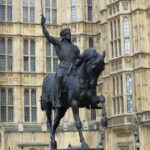
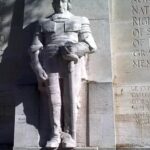
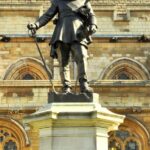
Впоследствии, голова военачальника была похищена, и еще много лет странствовала по частным коллекциям. В марте 1960 года она наконец упокоилась в часовне одного из Кембриджских колледжей.
Интересные факты
- До наших дней дошла легенда о том, что, будучи ребенком, Оливер Кромвель играл с Карлом I, впоследствии монархом. Во время забав ребята повздорили, и маленький Оливер разбил будущему королю нос.
- В 1970 году зрителям представили историческую картину «Кромвель», главную роль в которой сыграл Ричард Харрис. Актер получил положительные отзывы критиков за отличное воплощение главного героя.
- Помимо шести сестер, у Оливера было два брата, которые умерли в младенческом возрасте. С сестрами Кромвель всегда имел теплые, доверительные отношения.
- Историки сходятся во мнении, что легендарный Кромвель не имел военной подготовки. Сведения о его участии в Тридцатилетней войне являются выдумкой.
- Страсть к революционной деятельности Кромвель начал испытывать только в зрелом возрасте. В 41 год, когда на собственные средства он собрал «железнобокую» армию, Оливер почувствовал тягу к выдающимся свершениям в истории государства.
- Роковая дата в судьбе полководца – 3 сентября. В этот день он одержал победу над шотландцами при Денбаре, разгромил отряды Карла I в Вустере. В ту же самую дату начал работать созданный им парламент, после чего этот день был объявлен Днем благодарения. И именно 3 сентября Оливер Кромвель скончался.
- Уинстон Черчилль, находясь на должности военно-морского министра, дважды предпринимал попытки назвать именем Оливера Кромвеля военное судно. Ему воспрепятствовал король Георг VI, опасаясь повторения бунта ирландцев.
Ссылки
- Страница в Википедии
Для нас важна актуальность и достоверность информации. Если вы обнаружили ошибку или неточность, пожалуйста, сообщите нам. Выделите ошибку и нажмите сочетание клавиш Ctrl+Enter.
|
His Highness Oliver Cromwell |
|
|---|---|

Portrait by Samuel Cooper, 1656 |
|
| Lord Protector of the Commonwealth of England, Scotland and Ireland | |
| In office 16 December 1653 – 3 September 1658 |
|
| Preceded by | Council of State |
| Succeeded by | Richard Cromwell |
| Member of Parliament for Cambridge |
|
| In office 30 February 1640 – 20 January 1649 |
|
| Monarch | Charles I |
| Preceded by | Thomas Purchase |
| Member of Parliament for Huntingdon |
|
| In office 31 January 1628 – 2 March 1629 |
|
| Monarch | Charles I |
| Preceded by | Arthur Mainwaring |
| Personal details | |
| Born | 25 April 1599 Huntingdon, Huntingdonshire |
| Died | 3 September 1658 (aged 59) Palace of Whitehall, City of Westminster |
| Resting place | Sidney Sussex College, Cambridge (Head) |
| Nationality | English |
| Spouse |
Elizabeth Bourchier (m. ) |
| Children |
|
| Parents |
|
| Alma mater | Sidney Sussex College, Cambridge |
| Occupation | Soldier and statesman |
| Signature | |
| Nicknames |
|
| Military service | |
| Allegiance | Kingdom of England (pre-1642) Parliamentarian (1642–1651) Commonwealth of England, Scotland and Ireland (1651–1658) |
| Branch/service |
|
| Years of service | pre-1642 (militia service) 1642–1651 (civil war) |
| Rank |
|
| Commands |
|
| Battles/wars |
|
| Royal styles of Oliver Cromwell, Lord Protector of the Commonwealth |
|
|---|---|
 |
|
| Reference style | His Highness |
| Spoken style | Your Highness |
Oliver Cromwell (25 April 1599 – 3 September 1658) was an English politician and military officer who is widely regarded as one of the most important statesmen in English history. He came to prominence during the 1639 to 1651 Wars of the Three Kingdoms, first as a senior commander in the Parliamentarian army and then as a politician. A leading advocate of the execution of Charles I in January 1649, which led to the establishment of the Republican Commonwealth of England, Scotland and Ireland, he ruled as Lord Protector from December 1653 until his death in September 1658. Cromwell nevertheless remains a deeply controversial figure in both Britain and Ireland, due to his use of the military to first acquire, then retain political power, and the brutality of his 1649 Irish campaign.[2]
Educated at Sidney Sussex College, Cambridge, Cromwell was elected MP for Huntingdon in 1628, but the first 40 years of his life were undistinguished and at one point he contemplated emigration to New England. He became a religious Independent in the 1630s and thereafter believed his successes were the result of Divine providence. While he generally supported tolerance for the various Protestant sects of the time, he later opposed those he considered heretical, such as Quakers and Fifth Monarchists.[3] In 1640, Cromwell was returned as MP for Cambridge in the Short and Long Parliaments, and joined the Parliamentarian army when the First English Civil War began in August 1642. He quickly demonstrated his military abilities and in 1645 was appointed commander of the New Model Army cavalry under Sir Thomas Fairfax, playing a key role in defeating the Royalists in the First and Second English Civil Wars.
Following the execution of Charles I and exile of his son, military victories in Ireland and against the Scots from 1649 to 1651 firmly established the Commonwealth and Cromwell’s dominance of the new republican regime. In December 1653, he was named Lord Protector of the Commonwealth,[a] a position he retained until his death in September 1658, when he was succeeded by his son Richard, whose weakness led to a power vacuum. This culminated in the 1660 Stuart Restoration, when Charles II returned to the throne, after which Cromwell’s body was removed from its resting place in Westminster Abbey and displayed at Tyburn. His head was placed on a spike outside the Tower of London, where it remained for 30 years until reburied at Sidney Sussex College, Cambridge.
Cromwell has been variously described as a military dictator by Winston Churchill,[4] and a hero of liberty by John Milton, Thomas Carlyle, and Samuel Rawson Gardiner, while the debate over his historical reputation continues. First proposed in 1856, his statue outside the Houses of Parliament was not erected until 1895, most of the funds being privately supplied by Lord Rosebery, then Prime Minister. In 2004, a group of MPs unsuccessfully proposed a motion to have it melted down.[5]
Early life and education
Cromwell was born in Huntingdon on 25 April 1599[6] to Robert Cromwell and his second wife Elizabeth, daughter of William Steward.[7] The family’s estate derived from Oliver’s great-great-grandfather Morgan ap William, a brewer from Glamorgan who settled at Putney (at that time near London) and married Katherine Cromwell (born 1482), the sister of Thomas Cromwell, who would become the famous chief minister to Henry VIII. The Cromwells acquired great wealth as occasional beneficiaries of Thomas’s administration of the Dissolution of the Monasteries.[8] Morgan ap William was a son of William ap Yevan of Wales. The family line continued through Richard Williams (alias Cromwell), (c. 1500–1544), Henry Williams (alias Cromwell), (c. 1524 – 6 January 1604),[b] then to Oliver’s father Robert Williams, alias Cromwell (c. 1560–1617), who married Elizabeth Steward (c. 1564–1654), probably in 1591. They had ten children, but Oliver, the fifth child, was the only boy to survive infancy.[9]
Cromwell’s paternal grandfather Sir Henry Williams was one of the two wealthiest landowners in Huntingdonshire. Cromwell’s father was of modest means but still a member of the landed gentry. As a younger son with many siblings, Robert inherited only a house at Huntingdon and a small amount of land. This land would have generated an income of up to £300 a year, near the bottom of the range of gentry incomes.[10] In 1654, Cromwell said, «I was by birth a gentleman, living neither in considerable height, nor yet in obscurity.»[11]
Oliver Cromwell was baptised on 29 April 1599 at St John’s Church,[12] and attended Huntingdon Grammar School. He went on to study at Sidney Sussex College, Cambridge, then a recently founded college with a strong Puritan ethos. He left in June 1617 without taking a degree, immediately after his father’s death.[13] Early biographers claim that he then attended Lincoln’s Inn, but the Inn’s archives retain no record of him.[14] Antonia Fraser concludes that it is likely that he did train at one of the London Inns of Court during this time.[15] His grandfather, his father, and two of his uncles had attended Lincoln’s Inn, and Cromwell sent his son Richard there in 1647.[15]
Cromwell probably returned home to Huntingdon after his father’s death. As his mother was widowed, and his seven sisters unmarried, he would have been needed at home to help his family.[16]
Marriage and family
Cromwell married Elizabeth Bourchier (1598–1665) on 22 August 1620 at St Giles-without-Cripplegate, Fore Street, London.[12] Elizabeth’s father, Sir James Bourchier, was a London leather-merchant who owned extensive lands in Essex and had strong connections with Puritan gentry families there. The marriage brought Cromwell into contact with Oliver St John and leading members of London’s merchant community, and behind them the influence of the Earls of Warwick and Holland. A place in this influential network proved crucial to Cromwell’s military and political career. The couple had nine children:[17]
- Robert (1621–1639), died while away at school
- Oliver (1622–1644), died of typhoid fever while serving as a Parliamentarian officer
- Bridget (1624–1662), married (1) Henry Ireton, (2) Charles Fleetwood
- Richard (1626–1712), his father’s successor as Lord Protector,[18] married Dorothy Maijor
- Henry (1628–1674), later Lord Deputy of Ireland (in office: 1657–1659), married Elizabeth Russell (daughter of Sir Francis Russell)
- Elizabeth (1629–1658), married John Claypole
- James (b. & d. 1632), died in infancy
- Mary (1637–1713), married Thomas Belasyse, 1st Earl Fauconberg
- Frances (1638–1720), married (1) Robert Rich (1634–1658), son of Robert Rich, 3rd Earl of Warwick, (2) Sir John Russell, 3rd Baronet
Crisis and recovery
Little evidence exists of Cromwell’s religion in his early years. His 1626 letter to Henry Downhall, an Arminian minister, suggests that he had yet to be influenced by radical Puritanism.[19] But there is evidence that Cromwell underwent a personal crisis during the late 1620s and early 1630s. In 1628 he was elected to Parliament from the Huntingdonshire county town of Huntingdon. Later that year, he sought treatment for a variety of physical and emotional ailments, including valde melancholicus (depression), from the Swiss-born London doctor Théodore de Mayerne. In 1629, Cromwell became involved in a dispute among the gentry of Huntingdon involving a new charter for the town. As a result, he was called before the Privy Council in 1630.[20]
In 1631, likely as a result of the dispute, Cromwell sold most of his properties in Huntingdon and moved to a farmstead in nearby St Ives. This move, a significant step down in society for the Cromwells, also had significant emotional and spiritual impact on Cromwell; an extant 1638 letter from him to his cousin, the wife of Oliver St John, gives an account of his spiritual awakening at this time. In the letter, Cromwell, describing himself as having been the «chief of sinners», describes his calling as among «the congregation of the firstborn».[19] The letter’s language, particularly the inclusion of numerous biblical quotations, shows Cromwell’s belief that he was saved from his previous sins by God’s mercy, and indicates his religiously Independent beliefs, chief among them that the Reformation had not gone far enough, that much of England was still living in sin, and that Catholic beliefs and practices must be fully removed from the church.[19] It appears that in 1634 Cromwell attempted to emigrate to what became the Connecticut Colony in the Americas, but was prevented by the government from leaving.[21]
Along with his brother Henry, Cromwell had kept a smallholding of chickens and sheep, selling eggs and wool to support himself, his lifestyle resembling that of a yeoman farmer. In 1636 Cromwell inherited control of various properties in Ely from his uncle on his mother’s side, and his uncle’s job as tithe-collector for Ely Cathedral. As a result, his income is likely to have risen to around £300–400 per year;[22] by the end of the 1630s Cromwell had returned to the ranks of acknowledged gentry. He had become a committed Puritan and had established important family links to leading families in London and Essex.[23]
Member of Parliament: 1628–29 and 1640–1642
Cromwell became the Member of Parliament for Huntingdon in the Parliament of 1628–1629, as a client of the Montagu family of Hinchingbrooke House. He made little impression: parliamentary records show only one speech (against the Arminian Bishop Richard Neile), which was poorly received.[24] After dissolving this Parliament, Charles I ruled without a Parliament for the next 11 years. When Charles faced the Scottish rebellion in the Bishops’ Wars, lack of funds forced him to call a Parliament again in 1640. Cromwell was returned to this Parliament as member for Cambridge, but it lasted for only three weeks and became known as the Short Parliament. Cromwell moved his family from Ely to London in 1640.[25]
A second Parliament was called later the same year, and became known as the Long Parliament. Cromwell was again returned as member for Cambridge. As with the Parliament of 1628–29, it is likely that he owed his position to the patronage of others, which might explain why in the first week of the Parliament he was in charge of presenting a petition for the release of John Lilburne, who had become a Puritan cause célèbre after his arrest for importing religious tracts from the Netherlands. For the Long Parliament’s first two years, Cromwell was linked to the godly group of aristocrats in the House of Lords and Members of the House of Commons with whom he had established familial and religious links in the 1630s, such as the Earls of Essex, Warwick and Bedford, Oliver St John and Viscount Saye and Sele.[26] At this stage, the group had an agenda of reformation: the executive checked by regular parliaments, and the moderate extension of liberty of conscience. Cromwell appears to have taken a role in some of this group’s political manoeuvres. In May 1641, for example, he put forward the second reading of the Annual Parliaments Bill, and he later took a role in drafting the Root and Branch Bill for the abolition of episcopacy.[27]
Military commander: 1642–1646
English Civil War begins
Failure to resolve the issues before the Long Parliament led to armed conflict between Parliament and Charles I in late 1642, the beginning of the English Civil War. Before he joined Parliament’s forces, Cromwell’s only military experience was in the trained bands, the local county militia. He recruited a cavalry troop in Cambridgeshire after blocking a valuable shipment of silver plate from Cambridge colleges that was meant for the King. Cromwell and his troop then rode to, but arrived too late to take part in, the indecisive Battle of Edgehill on 23 October 1642. The troop was recruited to be a full regiment in the winter of 1642–43, making up part of the Eastern Association under the Earl of Manchester. Cromwell gained experience in successful actions in East Anglia in 1643, notably at the Battle of Gainsborough on 28 July.[28] He was subsequently appointed governor of the Isle of Ely[29] and a colonel in the Eastern Association.[23]
Marston Moor 1644
By the time of the Battle of Marston Moor in July 1644, Cromwell had risen to the rank of lieutenant general of horse in Manchester’s army. His cavalry’s success in breaking the ranks of the Royalist cavalry and then attacking their infantry from the rear at Marston Moor was a major factor in the Parliamentarian victory. Cromwell fought at the head of his troops in the battle and was slightly wounded in the neck, stepping away briefly to receive treatment but returning to help secure the victory.[30] After Cromwell’s nephew was killed at Marston Moor he wrote a famous letter to his brother-in-law. Marston Moor secured the north of England for the Parliamentarians but failed to end Royalist resistance.[31]
The indecisive outcome of the Second Battle of Newbury in October meant that by the end of 1644 the war still showed no sign of ending. Cromwell’s experience at Newbury, where Manchester had let the King’s army slip out of an encircling manoeuvre, led to a serious dispute with Manchester, whom he believed to be less than enthusiastic in his conduct of the war. Manchester later accused Cromwell of recruiting men of «low birth» as officers in the army, to which he replied: «If you choose godly honest men to be captains of horse, honest men will follow them … I would rather have a plain russet-coated captain who knows what he fights for and loves what he knows than that which you call a gentleman and is nothing else».[32] At this time, Cromwell also fell into dispute with Major-General Lawrence Crawford, a Scottish Covenanter attached to Manchester’s army, who objected to Cromwell’s encouragement of unorthodox Independents and Anabaptists.[33] He was also charged with familism by Scottish Presbyterian Samuel Rutherford in response to his letter to the House of Commons in 1645.[34]
New Model Army
Partly in response to the failure to capitalise on their victory at Marston Moor, Parliament passed the Self-Denying Ordinance in early 1645. This forced members of the House of Commons and the Lords, such as Manchester, to choose between civil office and military command. All of them—except Cromwell, whose commission was given continued extensions and was allowed to remain in parliament—chose to renounce their military positions. The Ordinance also decreed that the army be «remodelled» on a national basis, replacing the old county associations; Cromwell contributed significantly to these military reforms. In April 1645 the New Model Army finally took to the field, with Sir Thomas Fairfax in command and Cromwell as Lieutenant-General of cavalry and second-in-command.[23]
Battle of Naseby 1645
At the critical Battle of Naseby in June 1645, the New Model Army smashed the King’s major army. Cromwell led his wing with great success at Naseby, again routing the Royalist cavalry. At the Battle of Langport on 10 July, Cromwell participated in the defeat of the last sizeable Royalist field army. Naseby and Langport effectively ended the King’s hopes of victory, and the subsequent Parliamentarian campaigns involved taking the remaining fortified Royalist positions in the west of England. In October 1645, Cromwell besieged and took the wealthy and formidable Catholic fortress Basing House, later to be accused of killing 100 of its 300-man Royalist garrison after its surrender.[35] He also took part in successful sieges at Bridgwater, Sherborne, Bristol, Devizes, and Winchester, then spent the first half of 1646 mopping up resistance in Devon and Cornwall. Charles I surrendered to the Scots on 5 May 1646, effectively ending the First English Civil War. Cromwell and Fairfax took the Royalists’ formal surrender at Oxford in June.[23]
Cromwell’s military style
Cromwell, in contrast to Fairfax, had no formal training in military tactics, and followed the common practice of ranging his cavalry in three ranks and pressing forward, relying on impact rather than firepower. His strengths were an instinctive ability to lead and train his men, and his moral authority. In a war fought mostly by amateurs, these strengths were significant and most likely contributed to the discipline of his cavalry.[36]
Cromwell introduced close-order cavalry formations, with troopers riding knee to knee; this was an innovation in England at the time and a major factor in his success. He kept his troops close together after skirmishes where they had gained superiority, rather than allowing them to chase opponents off the battlefield. This facilitated further engagements in short order, which allowed greater intensity and quick reaction to battle developments. This style of command was decisive at both Marston Moor and Naseby.[37]
Politics: 1647–1649
In February 1647, Cromwell suffered from an illness that kept him out of political life for over a month. By the time he recovered, the Parliamentarians were split over the issue of the King. A majority in both Houses pushed for a settlement that would pay off the Scottish army, disband much of the New Model Army, and restore Charles I in return for a Presbyterian settlement of the Church. Cromwell rejected the Scottish model of Presbyterianism, which threatened to replace one authoritarian hierarchy with another. The New Model Army, radicalised by Parliament’s failure to pay the wages it was owed, petitioned against these changes, but the Commons declared the petition unlawful. In May 1647 Cromwell was sent to the army’s headquarters in Saffron Walden to negotiate with them, but failed to agree.[38]
In June 1647, a troop of cavalry under Cornet George Joyce seized the King from Parliament’s imprisonment. With the King now present, Cromwell was eager to find out what conditions the King would acquiesce to if his authority was restored. The King appeared to be willing to compromise, so Cromwell employed his son-in-law, Henry Ireton, to draw up proposals for a constitutional settlement. Proposals were drafted multiple times with different changes until finally the «Heads of Proposals» pleased Cromwell in principle and allowed for further negotiations.[39] It was designed to check the powers of the executive, to set up regularly elected parliaments, and to restore a non-compulsory Episcopalian settlement.[40]
Many in the army, such as the Levellers led by John Lilburne, thought this was not enough and demanded full political equality for all men, leading to tense debates in Putney during the autumn of 1647 between Fairfax, Cromwell and Ireton on the one hand, and Levellers like Colonel Rainsborough on the other. The Putney Debates broke up without reaching a resolution.[41][42]
Second Civil War
The failure to conclude a political agreement with the King led eventually to the outbreak of the Second English Civil War in 1648, when the King tried to regain power by force of arms. Cromwell first put down a Royalist uprising in south Wales led by Rowland Laugharne, winning back Chepstow Castle on 25 May and six days later forcing the surrender of Tenby. The castle at Carmarthen was destroyed by burning; the much stronger castle at Pembroke fell only after an eight-week siege. Cromwell dealt leniently with ex-Royalist soldiers, but less so with those who had formerly been members of the parliamentary army, John Poyer eventually being executed in London after the drawing of lots.[43]
Cromwell then marched north to deal with a pro-Royalist Scottish army (the Engagers) who had invaded England. At Preston, in sole command for the first time and with an army of 9,000, he won a decisive victory against an army twice as large.[44]
During 1648, Cromwell’s letters and speeches started to become heavily based on biblical imagery, many of them meditations on the meaning of particular passages. For example, after the battle of Preston, study of Psalms 17 and 105 led him to tell Parliament that «they that are implacable and will not leave troubling the land may be speedily destroyed out of the land». A letter to Oliver St John in September 1648 urged him to read Isaiah 8, in which the kingdom falls and only the godly survive. On four occasions in letters in 1648 he referred to the story of Gideon’s defeat of the Midianites at Ain Harod.[45] These letters suggest that it was Cromwell’s faith, rather than a commitment to radical politics, coupled with Parliament’s decision to engage in negotiations with the King at the Treaty of Newport, that convinced him that God had spoken against both the King and Parliament as lawful authorities. For Cromwell, the army was now God’s chosen instrument.[46] The episode shows Cromwell’s firm belief in Providentialism—that God was actively directing the affairs of the world, through the actions of «chosen people» (whom God had «provided» for such purposes). During the Civil Wars, Cromwell believed that he was one of these people, and he interpreted victories as indications of God’s approval and defeats as signs that God was pointing him in another direction.[47]
King tried and executed
In December 1648, in an episode that became known as Pride’s Purge, a troop of soldiers headed by Colonel Thomas Pride forcibly removed from the Long Parliament all those who were not supporters of the Grandees in the New Model Army and the Independents.[48] Thus weakened, the remaining body of MPs, known as the Rump Parliament, agreed that Charles should be tried for treason. Cromwell was still in the north of England, dealing with Royalist resistance, when these events took place, but then returned to London. On the day after Pride’s Purge, he became a determined supporter of those pushing for the King’s trial and execution, believing that killing Charles was the only way to end the civil wars.[23] Cromwell approved Thomas Brook’s address to the House of Commons, which justified the trial and the King’s execution on the basis of the Book of Numbers, chapter 35 and particularly verse 33 («The land cannot be cleansed of the blood that is shed therein, but by the blood of him that shed it.»).[49]
Charles’s death warrant was signed by 59 of the trying court’s members, including Cromwell (the third to sign it).[50] Though it was not unprecedented, execution of the King, or regicide, was controversial, if for no other reason than the doctrine of the divine right of kings.[51] Thus, even after a trial, it was difficult to get ordinary men to go along with it: «None of the officers charged with supervising the execution wanted to sign the order for the actual beheading, so they brought their dispute to Cromwell…Oliver seized a pen and scribbled out the order, and handed the pen to the second officer, Colonel Hacker who stooped to sign it. The execution could now proceed.»[52] Although Fairfax conspicuously refused to sign,[53] Charles I was executed on 30 January 1649.[23]
Establishment of the Commonwealth: 1649
After the King’s execution, a republic was declared, known as the Commonwealth of England. The «Rump Parliament» exercised both executive and legislative powers, with a smaller Council of State also having some executive functions. Cromwell remained a member of the Rump and was appointed a member of the council. In the early months after Charles’s execution, Cromwell tried but failed to unite the original «Royal Independents» led by St John and Saye and Sele, which had fractured during 1648. Cromwell had been connected to this group since before the outbreak of civil war in 1642 and had been closely associated with them during the 1640s. Only St John was persuaded to retain his seat in Parliament. The Royalists, meanwhile, had regrouped in Ireland, having signed a treaty with the Irish known as Confederate Catholics. In March, the Rump chose Cromwell to command a campaign against them. Preparations for an invasion of Ireland occupied him in the subsequent months. In the latter part of the 1640s, Cromwell came across political dissidence in the New Model Army. The Leveller or Agitator movement was a political movement that emphasised popular sovereignty, extended suffrage, equality before the law, and religious tolerance. These sentiments were expressed in the 1647 manifesto: Agreement of the People. Cromwell and the rest of the «Grandees» disagreed with these sentiments in that they gave too much freedom to the people; they believed that the vote should extend only to the landowners. In the Putney Debates of 1647, the two groups debated these topics in hopes of forming a new constitution for England. Rebellions and mutinies followed the debates, and in 1649, the Bishopsgate mutiny resulted in Leveller Robert Lockyer’s execution by firing squad. The next month, the Banbury mutiny occurred with similar results. Cromwell led the charge in quelling these rebellions. After quelling Leveller mutinies within the English army at Andover and Burford in May, he departed for Ireland from Bristol at the end of July.[54]
Irish campaign: 1649–50
Cromwell led a Parliamentary invasion of Ireland from 1649 to 1650. Parliament’s key opposition was the military threat posed by the alliance of the Irish Confederate Catholics and English royalists (signed in 1649). The Confederate-Royalist alliance was judged to be the biggest single threat facing the Commonwealth. However, the political situation in Ireland in 1649 was extremely fractured: there were also separate forces of Irish Catholics who were opposed to the Royalist alliance, and Protestant Royalist forces that were gradually moving towards Parliament. Cromwell said in a speech to the army Council on 23 March that «I had rather be overthrown by a Cavalierish interest than a Scotch interest; I had rather be overthrown by a Scotch interest than an Irish interest and I think of all this is the most dangerous».[55]
Cromwell’s hostility to the Irish was religious as well as political. He was passionately opposed to the Catholic Church, which he saw as denying the primacy of the Bible in favour of papal and clerical authority, and which he blamed for suspected tyranny and persecution of Protestants in continental Europe.[56] Cromwell’s association of Catholicism with persecution was deepened with the Irish Rebellion of 1641. This rebellion, although intended to be bloodless, was marked by massacres of English and Scottish Protestant settlers by Irish («Gaels») and Old English in Ireland, and Highland Scot Catholics in Ireland. These settlers had settled on land seized from former, native Catholic owners to make way for the non-native Protestants. These factors contributed to the brutality of the Cromwell military campaign in Ireland.[57]
Parliament had planned to re-conquer Ireland since 1641 and had already sent an invasion force there in 1647. Cromwell’s invasion of 1649 was much larger and, with the civil war in England over, could be regularly reinforced and re-supplied. His nine-month military campaign was brief and effective, though it did not end the war in Ireland. Before his invasion, Parliamentarian forces held outposts only in Dublin and Derry. When he departed Ireland, they occupied most of the eastern and northern parts of the country. After he landed at Dublin on 15 August 1649 (itself only recently defended from an Irish and English Royalist attack at the Battle of Rathmines), Cromwell took the fortified port towns of Drogheda and Wexford to secure logistical supply from England. At the Siege of Drogheda in September 1649, his troops killed nearly 3,500 people after the town’s capture—around 2,700 Royalist soldiers and all the men in the town carrying arms, including some civilians, prisoners and Roman Catholic priests.[58] Cromwell wrote afterwards:
I am persuaded that this is a righteous judgment of God upon these barbarous wretches, who have imbrued their hands in so much innocent blood and that it will tend to prevent the effusion of blood for the future, which are satisfactory grounds for such actions, which otherwise cannot but work remorse and regret[59]
At the Siege of Wexford in October, another massacre took place under confused circumstances. While Cromwell was apparently trying to negotiate surrender terms, some of his soldiers broke into the town, killed 2,000 Irish troops and up to 1,500 civilians, and burned much of the town.[60]
After taking Drogheda, Cromwell sent a column north to Ulster to secure the north of the country and went on to besiege Waterford, Kilkenny and Clonmel in Ireland’s south-east. Kilkenny put up a fierce defence but was eventually forced to surrender on terms, as did many other towns like New Ross and Carlow, but Cromwell failed to take Waterford, and at the siege of Clonmel in May 1650 he lost up to 2,000 men in abortive assaults before the town surrendered.[61]
One of Cromwell’s major victories in Ireland was diplomatic rather than military. With the help of Roger Boyle, 1st Earl of Orrery, he persuaded the Protestant Royalist troops in Cork to change sides and fight with the Parliament.[62] At this point, word reached Cromwell that Charles II (son of Charles I) had landed in Scotland from exile in France and been proclaimed King by the Covenanter regime. Cromwell therefore returned to England from Youghal on 26 May 1650 to counter this threat.[63]
The Parliamentarian conquest of Ireland dragged on for almost three years after Cromwell’s departure. The campaigns under Cromwell’s successors Henry Ireton and Edmund Ludlow consisted mostly of long sieges of fortified cities and guerrilla warfare in the countryside, with English troops suffering from attacks by Irish toráidhe (guerilla fighters). The last Catholic-held town, Galway, surrendered in April 1652 and the last Irish Catholic troops capitulated in April 1653 in County Cavan.[61]
In the wake of the Commonwealth’s conquest of the island of Ireland, public practice of Roman Catholicism was banned and Catholic priests were killed when captured.[64] All Catholic-owned land was confiscated under the Act for the Settlement of Ireland of 1652 and given to Scottish and English settlers, Parliament’s financial creditors and Parliamentary soldiers.[65] Remaining Catholic landowners were allocated poorer land in the province of Connacht.[66]
Debate over Cromwell’s effect on Ireland
The extent of Cromwell’s brutality[67][68] in Ireland has been strongly debated. Some historians argue that Cromwell never accepted responsibility for the killing of civilians in Ireland, claiming that he had acted harshly but only against those «in arms».[69] Other historians cite Cromwell’s contemporary reports to London, including that of 27 September 1649, in which he lists the slaying of 3,000 military personnel, followed by the phrase «and many inhabitants».[70] In September 1649, he justified his sacking of Drogheda as revenge for the massacres of Protestant settlers in Ulster in 1641, calling the massacre «the righteous judgement of God on these barbarous wretches, who have imbrued their hands with so much innocent blood».[58] But the rebels had not held Drogheda in 1641; many of its garrison were in fact English royalists. On the other hand, the worst atrocities committed in Ireland, such as mass evictions, killings and deportation of over 50,000 men, women and children as prisoners of war and indentured servants to Bermuda and Barbados, were carried out under the command of other generals after Cromwell had left for England.[71] Some point to his actions on entering Ireland. Cromwell demanded that no supplies be seized from civilian inhabitants and that everything be fairly purchased; «I do hereby warn … all Officers, Soldiers and others under my command not to do any wrong or violence toward Country People or any persons whatsoever, unless they be actually in arms or office with the enemy … as they shall answer to the contrary at their utmost peril.»[72]
The massacres at Drogheda and Wexford were in some ways typical of the day, especially in the context of the recently ended Thirty Years War,[73][74] although there are few comparable incidents during the Civil Wars in England or Scotland, which were fought mainly between Protestant adversaries, albeit of differing denominations. One possible comparison is Cromwell’s Siege of Basing House in 1645—the seat of the prominent Catholic the Marquess of Winchester—which resulted in about 100 of the garrison of 400 being killed after being refused quarter. Contemporaries also reported civilian casualties, six Catholic priests and a woman.[75] The scale of the deaths at Basing House was much smaller.[76] Cromwell himself said of the slaughter at Drogheda in his first letter back to the Council of State: «I believe we put to the sword the whole number of the defendants. I do not think thirty of the whole number escaped with their lives.»[77] Cromwell’s orders—»in the heat of the action, I forbade them to spare any that were in arms in the town»—followed a request for surrender at the start of the siege, which was refused. The military protocol of the day was that a town or garrison that rejected the chance to surrender was not entitled to quarter.[78] The refusal of the garrison at Drogheda to do this, even after the walls had been breached, was to Cromwell justification for the massacre.[79] Where Cromwell negotiated the surrender of fortified towns, as at Carlow, New Ross, and Clonmel, some historians[who?] argue that he respected the terms of surrender and protected the townspeople’s lives and property.[80] At Wexford, he again began negotiations for surrender. The captain of Wexford Castle surrendered during the negotiations and, in the confusion, some of Cromwell’s troops began indiscriminate killing and looting.[81][82][83][84]
Although Cromwell’s time spent on campaign in Ireland was limited and he did not take on executive powers until 1653, he is often the central focus of wider debates about whether, as historians such as Mark Levene and John Morrill suggest, the Commonwealth conducted a deliberate programme of ethnic cleansing in Ireland.[85] Faced with the prospect of an Irish alliance with Charles II, Cromwell carried out a series of massacres to subdue the Irish. Then, once Cromwell had returned to England, the English Commissary, General Henry Ireton, Cromwell’s son-in-law and key adviser, adopted a deliberate policy of crop burning and starvation. Total excess deaths for the entire period of the Wars of the Three Kingdoms in Ireland was estimated by Sir William Petty, the 17th Century economist, to be 600,000 out of a total Irish population of 1,400,000 in 1641.[86][87][88] More recent estimates put the figure closer to 200,000 out of a population of 2 million.[89]
The sieges of Drogheda and Wexford have been prominently mentioned in histories and literature up to the present day. James Joyce, for example, mentioned Drogheda in his novel Ulysses: «What about sanctimonious Cromwell and his ironsides that put the women and children of Drogheda to the sword with the Bible text ‘God is love’ pasted round the mouth of his cannon?» Similarly, Winston Churchill (writing in 1957) described Cromwell’s impact on Anglo-Irish relations:
upon all of these Cromwell’s record was a lasting bane. By an uncompleted process of terror, by an iniquitous land settlement, by the virtual proscription of the Catholic religion, by the bloody deeds already described, he cut new gulfs between the nations and the creeds. ‘Hell or Connaught’ were the terms he thrust upon the native inhabitants, and they for their part, across three hundred years, have used as their keenest expression of hatred ‘The Curse of Cromwell on you.’ … Upon all of us there still lies ‘the curse of Cromwell’.[90]
A key surviving statement of Cromwell’s views on the conquest of Ireland is his Declaration of the lord lieutenant of Ireland for the undeceiving of deluded and seduced people of January 1650.[91] In this he was scathing about Catholicism, saying, «I shall not, where I have the power… suffer the exercise of the Mass.»[92] But he also wrote: «as for the people, what thoughts they have in the matter of religion in their own breasts I cannot reach; but I shall think it my duty, if they walk honestly and peaceably, not to cause them in the least to suffer for the same.»[92] Private soldiers who surrendered their arms «and shall live peaceably and honestly at their several homes, they shall be permitted so to do».[93]
In 1965 the Irish minister for lands stated that his policies were necessary to «undo the work of Cromwell»; circa 1997, Taoiseach Bertie Ahern demanded that a portrait of Cromwell be removed from a room in the Foreign Office before he began a meeting with Robin Cook.[94]
Scottish campaign: 1650–51
Scots proclaim Charles II as King
Cromwell left Ireland in May 1650 and several months later invaded Scotland after the Scots had proclaimed Charles I’s son Charles II as King. Cromwell was much less hostile to Scottish Presbyterians, some of whom had been his allies in the First English Civil War, than he was to Irish Catholics. He described the Scots as a people «fearing His [God’s] name, though deceived».[95] He made a famous appeal to the General Assembly of the Church of Scotland, urging them to see the error of the royal alliance—»I beseech you, in the bowels of Christ, think it possible you may be mistaken.»[96] The Scots’ reply was robust: «would you have us to be sceptics in our religion?» This decision to negotiate with Charles II led Cromwell to believe that war was necessary.[97]
Battle of Dunbar
His appeal rejected, Cromwell’s veteran troops went on to invade Scotland. At first, the campaign went badly, as Cromwell’s men were short of supplies and held up at fortifications manned by Scottish troops under David Leslie. Sickness began to spread in the ranks. Cromwell was on the brink of evacuating his army by sea from Dunbar. However, on 3 September 1650, unexpectedly, Cromwell smashed the main Scottish army at the Battle of Dunbar, killing 4,000 Scottish soldiers, taking another 10,000 prisoner, and then capturing the Scottish capital of Edinburgh.[98] The victory was of such a magnitude that Cromwell called it «A high act of the Lord’s Providence to us [and] one of the most signal mercies God hath done for England and His people».[98]
Battle of Worcester
The following year, Charles II and his Scottish allies made an attempt to invade England and capture London while Cromwell was engaged in Scotland. Cromwell followed them south and caught them at Worcester on 3 September 1651, and his forces destroyed the last major Scottish Royalist army at the Battle of Worcester. Charles II barely escaped capture and fled to exile in France and the Netherlands, where he remained until 1660.[99]
To fight the battle, Cromwell organised an envelopment followed by a multi-pronged coordinated attack on Worcester, his forces attacking from three directions with two rivers partitioning them. He switched his reserves from one side of the river Severn to the other and then back again. The editor of the Great Rebellion article of the Encyclopædia Britannica (eleventh edition) notes that Worcester was a battle of manoeuvre compared to the early Civil War Battle of Turnham Green, which the English parliamentary armies were unable to execute at the start of the war, and he suggests that it was a prototype for the Battle of Sedan (1870).[100]
Conclusion
In the final stages of the Scottish campaign, Cromwell’s men under George Monck sacked Dundee, killing up to 1,000 men and 140 women and children.[101] Scotland was ruled from England during the Commonwealth and was kept under military occupation, with a line of fortifications sealing off the Highlands which had provided manpower for Royalist armies in Scotland. The northwest Highlands was the scene of another pro-Royalist uprising in 1653–55, which was put down with deployment of 6,000 English troops there.[102] Presbyterianism was allowed to be practised as before, but the Kirk (the Scottish church) did not have the backing of the civil courts to impose its rulings, as it had previously.[103]
Cromwell’s conquest left no significant legacy of bitterness in Scotland. The rule of the Commonwealth and Protectorate was largely peaceful, apart from the Highlands. Moreover, there were no wholesale confiscations of land or property. Three out of every four Justices of the Peace in Commonwealth Scotland were Scots and the country was governed jointly by the English military authorities and a Scottish Council of State.[104]
Return to England and dissolution of the Rump Parliament: 1651–1653
Wikisource has original text related to this article:
Cromwell was away on campaign from the middle of 1649 until 1651, and the various factions in Parliament began to fight amongst themselves with the King gone as their «common cause». Cromwell tried to galvanise the Rump into setting dates for new elections, uniting the three kingdoms under one polity, and to put in place a broad-brush, tolerant national church. However, the Rump vacillated in setting election dates, although it put in place a basic liberty of conscience, but it failed to produce an alternative for tithes or to dismantle other aspects of the existing religious settlement. According to the parliamentarian lawyer Bulstrode Whitelocke, Cromwell began to contemplate taking the Crown for himself around this time, though the evidence for this is retrospective and problematic.[105] Ultimately, he demanded that the Rump establish a caretaker government in April 1653 of 40 members drawn from the Rump and the army, and then abdicate; but the Rump returned to debating its own bill for a new government.[106] Cromwell was so angered by this that he cleared the chamber and dissolved the Parliament by force on 20 April 1653, supported by about 40 musketeers. Several accounts exist of this incident; in one, Cromwell is supposed to have said «you are no Parliament, I say you are no Parliament; I will put an end to your sitting».[107] At least two accounts agree that he snatched up the ceremonial mace, symbol of Parliament’s power, and demanded that the «bauble» be taken away.[108] His troops were commanded by Charles Worsley, later one of his Major Generals and one of his most trusted advisors, to whom he entrusted the mace.[109]
Establishment of Barebone’s Parliament: 1653
After the dissolution of the Rump, power passed temporarily to a council that debated what form the constitution should take. They took up the suggestion of Major-General Thomas Harrison for a «sanhedrin» of saints. Although Cromwell did not subscribe to Harrison’s apocalyptic, Fifth Monarchist beliefs—which saw a sanhedrin as the starting point for Christ’s rule on earth—he was attracted by the idea of an assembly made up of men chosen for their religious credentials. In his speech at the opening of the assembly on 4 July 1653, Cromwell thanked God’s providence that he believed had brought England to this point and set out their divine mission: «truly God hath called you to this work by, I think, as wonderful providences as ever passed upon the sons of men in so short a time.»[110] The Nominated Assembly, sometimes known as the Parliament of Saints, or more commonly and denigratingly called Barebone’s Parliament after one of its members, Praise-God Barebone, was tasked with finding a permanent constitutional and religious settlement (Cromwell was invited to be a member but declined). However, the revelation that a considerably larger segment of the membership than had been believed were the radical Fifth Monarchists led to its members voting to dissolve it on 12 December 1653, out of fear of what the radicals might do if they took control of the Assembly.[111]
The Protectorate: 1653–1658
Coat of arms of the Protectorate
Banner of Oliver Cromwell
After the dissolution of Barebone’s Parliament, John Lambert put forward a new constitution known as the Instrument of Government, closely modelled on the Heads of Proposals. It made Cromwell Lord Protector for life to undertake «the chief magistracy and the administration of government». Cromwell was sworn in as Lord Protector on 16 December 1653, with a ceremony in which he wore plain black clothing, rather than any monarchical regalia.[112] However, from this point on Cromwell signed his name ‘Oliver P’, the P being an abbreviation for Protector, which was similar to the style of monarchs who used an R to mean Rex or Regina, and it soon became the norm for others to address him as «Your Highness».[113] As Protector, he had the power to call and dissolve parliaments but was obliged under the Instrument to seek the majority vote of a Council of State. Nevertheless, Cromwell’s power was buttressed by his continuing popularity among the army. As the Lord Protector he was paid £100,000 a year.[114]
Cromwell had two key objectives as Lord Protector. The first was «healing and settling» the nation after the chaos of the civil wars and the regicide, which meant establishing a stable form for the new government to take.[115] Although Cromwell declared to the first Protectorate Parliament that, «Government by one man and a parliament is fundamental,» in practice social priorities took precedence over forms of government. Such forms were, he said, «but … dross and dung in comparison of Christ».[116] The social priorities did not, despite the revolutionary nature of the government, include any meaningful attempt to reform the social order. Cromwell declared, «A nobleman, a gentleman, a yeoman; the distinction of these: that is a good interest of the nation, and a great one!»[117] Small-scale reform such as that carried out on the judicial system were outweighed by attempts to restore order to English politics. Direct taxation was reduced slightly and peace was made with the Dutch, ending the First Anglo-Dutch War.[118]
England’s overseas possessions in this period included Newfoundland,[119] the New England Confederation, the Providence Plantation, the Virginia Colony, the Maryland Colony, and islands in the West Indies. Cromwell soon secured the submission of these and largely left them to their own affairs, intervening only to curb his fellow Puritans who were usurping control over the Maryland Colony at the Battle of the Severn, by his confirming the former Roman Catholic proprietorship and edict of tolerance there. Of all the English dominions, Virginia was the most resentful of Cromwell’s rule, and Cavalier emigration there mushroomed during the Protectorate.[120]
Cromwell famously stressed the quest to restore order in his speech to the first Protectorate parliament at its inaugural meeting on 3 September 1654. He declared that «healing and settling» were the «great end of your meeting».[121] However, the Parliament was quickly dominated by those pushing for more radical, properly republican reforms. After some initial gestures approving appointments previously made by Cromwell, the Parliament began to work on a radical programme of constitutional reform. Rather than opposing Parliament’s bill, Cromwell dissolved them on 22 January 1655. The First Protectorate Parliament had a property franchise of £200 per annum in real or personal property value set as the minimum value in which a male adult was to possess before he was eligible to vote for the representatives from the counties or shires in the House of Commons. The House of Commons representatives from the boroughs were elected by the burgesses or those borough residents who had the right to vote in municipal elections, and by the aldermen and councilors of the boroughs.[122]
Cromwell’s signature before becoming Lord Protector in 1653, and afterwards. ‘Oliver P’, standing for Oliver Protector, similar in style to English monarchs who signed their names as, for example, ‘Elizabeth R’ standing for Elizabeth Regina.
Broad of Oliver Cromwell, dated 1656; on the obverse the Latin inscription OLIVAR D G RP ANG SCO ET HIB &c PRO, translated as «Oliver, by the Grace of God of the Republic of England, Scotland and Ireland etc. Protector».
Cromwell’s second objective was spiritual and moral reform. He aimed to restore liberty of conscience and promote both outward and inward godliness throughout England.[123] During the early months of the Protectorate, a set of «triers» was established to assess the suitability of future parish ministers, and a related set of «ejectors» was set up to dismiss ministers and schoolmasters who were deemed unsuitable for office. The triers and the ejectors were intended to be at the vanguard of Cromwell’s reform of parish worship. This second objective is also the context in which to see the constitutional experiment of the Major Generals that followed the dissolution of the first Protectorate Parliament. After a Royalist uprising in March 1655, led by Sir John Penruddock, Cromwell (influenced by Lambert) divided England into military districts ruled by army major generals who answered only to him. The 15 major generals and deputy major generals—called «godly governors»—were central not only to national security, but Cromwell’s crusade to reform the nation’s morals. The generals not only supervised militia forces and security commissions, but collected taxes and ensured support for the government in the English and Welsh provinces. Commissioners for securing the peace of the Commonwealth were appointed to work with them in every county. While a few of these commissioners were career politicians, most were zealous puritans who welcomed the major-generals with open arms and embraced their work with enthusiasm. However, the major-generals lasted less than a year. Many feared they threatened their reform efforts and authority. Their position was further harmed by a tax proposal by Major General John Desborough to provide financial backing for their work, which the second Protectorate parliament—instated in September 1656—voted down for fear of a permanent military state. Ultimately, however, Cromwell’s failure to support his men, sacrificing them to his opponents, caused their demise. Their activities between November 1655 and September 1656 had, however, reopened the wounds of the 1640s and deepened antipathies to the regime.[124] In late 1654, Cromwell launched the Western Design armada against the Spanish West Indies, and in May 1655 captured Jamaica.[125]
As Lord Protector, Cromwell was aware of the Jewish community’s involvement in the economics of the Netherlands, now England’s leading commercial rival. It was this—allied to Cromwell’s tolerance of the right to private worship of those who fell outside Puritanism—that led to his encouraging Jews to return to England in 1657, over 350 years after their banishment by Edward I, in the hope that they would help speed up the recovery of the country after the disruption of the Civil Wars.[126] There was a longer-term motive for Cromwell’s decision to allow the Jews to return to England, and that was the hope that they would convert to Christianity and therefore hasten the Second Coming of Jesus Christ, ultimately based on Matthew 23:37–39 and Romans 11. At the Whitehall conference of December 1655 he quoted from St. Paul’s Epistle to the Romans 10:12–15 on the need to send Christian preachers to the Jews. The Presbyterian William Prynne, in contrast to the Congregationalist Cromwell, was strongly opposed to the latter’s pro-Jewish policy.[127][128][129]
On 23 March 1657, the Protectorate signed the Treaty of Paris with Louis XIV against Spain. Cromwell pledged to supply France with 6,000 troops and war ships. In accordance with the terms of the treaty, Mardyck and Dunkirk – a base for privateers and commerce raiders attacking English merchant shipping – were ceded to England.[130]
In 1657, Cromwell was offered the crown by Parliament as part of a revised constitutional settlement, presenting him with a dilemma since he had been «instrumental» in abolishing the monarchy. Cromwell agonised for six weeks over the offer. He was attracted by the prospect of stability it held out, but in a speech on 13 April 1657 he made clear that God’s providence had spoken against the office of King: «I would not seek to set up that which Providence hath destroyed and laid in the dust, and I would not build Jericho again».[131] The reference to Jericho harks back to a previous occasion on which Cromwell had wrestled with his conscience when the news reached England of the defeat of an expedition against the Spanish-held island of Hispaniola in the West Indies in 1655—comparing himself to Achan, who had brought the Israelites defeat after bringing plunder back to camp after the capture of Jericho.[132]
Instead, Cromwell was ceremonially re-installed as Lord Protector on 26 June 1657 at Westminster Hall, sitting upon King Edward’s Chair, which was moved specially from Westminster Abbey for the occasion. The event in part echoed a coronation, using many of its symbols and regalia, such as a purple ermine-lined robe, a sword of justice and a sceptre (but not a crown or an orb). But, most notably, the office of Lord Protector was still not to become hereditary, though Cromwell was now able to nominate his own successor.[133] Cromwell’s new rights and powers were laid out in the Humble Petition and Advice, a legislative instrument which replaced the Instrument of Government. Despite failing to restore the Crown, this new constitution did set up many of the vestiges of the ancient constitution including a house of life peers (in place of the House of Lords). In the Humble Petition it was called the Other House as the Commons could not agree on a suitable name. Furthermore, Oliver Cromwell increasingly took on more of the trappings of monarchy. In particular, he created three peerages after the acceptance of the Humble Petition and Advice: Charles Howard was made Viscount Morpeth and Baron Gisland in July 1657 and Edmund Dunch was created Baron Burnell of East Wittenham in April 1658.[134]
Death and posthumous execution
The execution of Cromwell, Bradshaw, and Ireton, depicted in a contemporary print
Cromwell is thought to have suffered from malaria and kidney stone disease. In 1658, he was struck by a sudden bout of malarial fever, and spurned the only known treatment, quinine, because it had been discovered by Catholic Jesuit missionaries.[135] This was followed directly by illness symptomatic of a urinary or kidney complaint. The Venetian ambassador wrote regular dispatches to the Doge of Venice in which he included details of Cromwell’s final illness, and he was suspicious of the rapidity of his death.[136] The decline may have been hastened by the death of his daughter Elizabeth Claypole in August. He died at age 59 at Whitehall on 3 September 1658, the anniversary of his great victories at Dunbar and Worcester.[137] The night of his death, a great storm swept England and all over Europe.[138] The most likely cause of death was sepsis (blood poisoning) following his urinary infection. He was buried with great ceremony, with an elaborate funeral at Westminster Abbey based on that of James I,[139] his daughter Elizabeth also being buried there.[140]
Cromwell was succeeded as Lord Protector by his son Richard. Richard had no power base in Parliament or the Army and was forced to resign in May 1659, ending the Protectorate. There was no clear leadership from the various factions that jostled for power during the reinstated Commonwealth, so George Monck was able to march on London at the head of New Model Army regiments and restore the Long Parliament. Under Monck’s watchful eye, the necessary constitutional adjustments were made so that Charles II could be invited back from exile in 1660 to be King under a restored monarchy.[141]
Cromwell’s body was exhumed from Westminster Abbey on 30 January 1661, the 12th anniversary of the execution of Charles I, and was subjected to a posthumous execution, as were the remains of John Bradshaw and Henry Ireton. (The body of Cromwell’s daughter was allowed to remain buried in the Abbey.) His body was hanged in chains at Tyburn, London, and then thrown into a pit. His head was cut off and displayed on a pole outside Westminster Hall until 1685. Afterwards, it was owned by various people, including a documented sale in 1814 to Josiah Henry Wilkinson,[142][143] and it was publicly exhibited several times before being buried beneath the floor of the antechapel at Sidney Sussex College, Cambridge, in 1960.[140][144] The exact position was not publicly disclosed, but a plaque marks the approximate location.[145]
Many people began to question whether the body mutilated at Tyburn and the head seen on Westminster Hall were Cromwell’s.[146] These doubts arose because it was assumed that Cromwell’s body was reburied in several places between his death in September 1658 and the exhumation of January 1661, in order to protect it from vengeful royalists. The stories suggest that his bodily remains are buried in London, Cambridgeshire, Northamptonshire, or Yorkshire.[147]
The Cromwell vault was later used as a burial place for Charles II’s illegitimate descendants.[148] In Westminster Abbey, the site of Cromwell’s burial was marked during the 19th century by a floor stone in what is now the RAF Chapel reading: «The burial place of Oliver Cromwell 1658–1661».[149]
Political reputation
A contemporaneous satirical view of Cromwell as a usurper of monarchical power
During his lifetime, some tracts painted Cromwell as a hypocrite motivated by power. For example, The Machiavilian Cromwell and The Juglers Discovered are parts of an attack on Cromwell by the Levellers after 1647, and both present him as a Machiavellian figure.[150] John Spittlehouse presented a more positive assessment in A Warning Piece Discharged, comparing him to Moses rescuing the English by taking them safely through the Red Sea of the civil wars.[151] Poet John Milton called Cromwell «our chief of men» in his Sonnet XVI.[152]
Several biographies were published soon after Cromwell’s death. An example is The Perfect Politician, which describes how Cromwell «loved men more than books» and provides a nuanced assessment of him as an energetic campaigner for liberty of conscience who is brought down by pride and ambition.[153] An equally nuanced but less positive assessment was published in 1667 by Edward Hyde, 1st Earl of Clarendon in his History of the Rebellion and Civil Wars in England. Clarendon famously declares that Cromwell «will be looked upon by posterity as a brave bad man».[154] He argues that Cromwell’s rise to power had been helped by his great spirit and energy, but also by his ruthlessness. Clarendon was not one of Cromwell’s confidantes, and his account was written after the Restoration of the monarchy.[154]
During the early 18th century, Cromwell’s image began to be adopted and reshaped by the Whigs as part of a wider project to give their political objectives historical legitimacy. John Toland rewrote Edmund Ludlow’s Memoirs in order to remove the Puritan elements and replace them with a Whiggish brand of republicanism, and it presents the Cromwellian Protectorate as a military tyranny. Through Ludlow, Toland portrayed Cromwell as a despot who crushed the beginnings of democratic rule in the 1640s.[155]
I hope to render the English name as great and formidable as ever the Roman was.[156]
— Cromwell
During the early 19th century, Cromwell began to be portrayed in a positive light by Romantic artists and poets. Thomas Carlyle continued this reassessment in the 1840s, publishing Oliver Cromwell’s Letters and Speeches: With Elucidations, an annotated collection of his letters and speeches in which he described English Puritanism as «the last of all our Heroisms» while taking a negative view of his own era.[157] By the late 19th century, Carlyle’s portrayal of Cromwell had become assimilated into Whig and Liberal historiography, stressing the centrality of puritan morality and earnestness. Oxford civil war historian Samuel Rawson Gardiner concluded that «the man—it is ever so with the noblest—was greater than his work».[158] Gardiner stressed Cromwell’s dynamic and mercurial character, and his role in dismantling absolute monarchy, rather than his religious conviction.[159] Cromwell’s foreign policy also provided an attractive forerunner of Victorian imperial expansion, with Gardiner stressing his «constancy of effort to make England great by land and sea».[160] Calvin Coolidge described Cromwell as a brilliant statesman who «dared to oppose the tyranny of the kings.»[161]
During the first half of the 20th century, Cromwell’s reputation was often influenced by the rise of fascism in Nazi Germany and in Italy. Harvard historian Wilbur Cortez Abbott, for example, devoted much of his career to compiling and editing a multi-volume collection of Cromwell’s letters and speeches, published between 1937 and 1947. Abbott argues that Cromwell was a proto-fascist. However, subsequent historians such as John Morrill have criticised both Abbott’s interpretation of Cromwell and his editorial approach.[162]
Late 20th-century historians re-examined the nature of Cromwell’s faith and of his authoritarian regime. Austin Woolrych explored the issue of «dictatorship» in depth, arguing that Cromwell was subject to two conflicting forces: his obligation to the army and his desire to achieve a lasting settlement by winning back the confidence of the nation as a whole. He argued that the dictatorial elements of Cromwell’s rule stemmed less from its military origin or the participation of army officers in civil government than from his constant commitment to the interest of the people of God and his conviction that suppressing vice and encouraging virtue constituted the chief end of government.[163] Historians such as John Morrill, Blair Worden, and J. C. Davis have developed this theme, revealing the extent to which Cromwell’s writing and speeches are suffused with biblical references, and arguing that his radical actions were driven by his zeal for godly reformation.[164]
Monuments and posthumous honours
In 1776, one of the first ships commissioned to serve in the American Continental Navy during the American Revolutionary War was named Oliver Cromwell.[165]
19th-century engineer Sir Richard Tangye was a noted Cromwell enthusiast and collector of Cromwell manuscripts and memorabilia.[166] His collection included many rare manuscripts and printed books, medals, paintings, objects d’art, and a bizarre assemblage of «relics». This includes Cromwell’s Bible, button, coffin plate, death mask, and funeral escutcheon. On Tangye’s death, the entire collection was donated to the Museum of London, where it can still be seen.[167]
In 1875, a statue of Cromwell by Matthew Noble was erected in Manchester outside the Manchester Cathedral, a gift to the city by Abel Heywood in memory of her first husband.[168][169] It was the first large-scale statue to be erected in the open in England, and was a realistic likeness based on the painting by Peter Lely; it showed Cromwell in battledress with drawn sword and leather body armour. It was unpopular with local Conservatives and the large Irish immigrant population. Queen Victoria was invited to open the new Manchester Town Hall, and she allegedly consented on the condition that the statue be removed. The statue remained, Victoria declined, and the town hall was opened by the Lord Mayor. During the 1980s, the statue was relocated outside Wythenshawe Hall, which had been occupied by Cromwell’s troops.[170]
During the 1890s, Parliamentary plans to erect a statue of Cromwell outside Parliament turned controversial. Pressure from the Irish Nationalist Party[171] forced the withdrawal of a motion to seek public funding for the project; the statue was eventually erected, but it had to be funded privately by Lord Rosebery.[172]
Cromwell controversy continued into the 20th century. Winston Churchill was First Lord of the Admiralty before World War I, and he twice suggested naming a British battleship HMS Oliver Cromwell. The suggestion was vetoed by King George V because of his personal feelings and because he felt that it was unwise to give such a name to an expensive warship at a time of Irish political unrest, especially given the anger caused by the statue outside Parliament. Churchill was eventually told by First Sea Lord Admiral Battenberg that the King’s decision must be treated as final.[173] The Cromwell Tank was a British medium-weight tank first used in 1944,[174] and a steam locomotive built by British Railways in 1951 was named Oliver Cromwell.[175]
Other public statues of Cromwell are the Statue of Oliver Cromwell, St Ives in Cambridgeshire[176] and the Statue of Oliver Cromwell, Warrington in Cheshire.[177] An oval plaque at Sidney Sussex College, Cambridge, refers to the end of the travels of his head and reads:[145][178]
Near to
this place was buried
on 25 March 1960 the head of
OLIVER CROMWELL
Lord Protector of the Common-
wealth of England, Scotland &
Ireland, Fellow Commoner
of this College 1616-7
See also
- Cromwell, a 1970 British historical drama film written and directed by Ken Hughes
- Cromwell’s Panegyrick, a contemporary satirical ballad
- Oliver Cromwell, a corvette launched in 1776 by the Connecticut State Navy
- Republicanism in the United Kingdom
- Robert Walker, painted several portraits of Cromwell
- The Souldiers Pocket Bible, a booklet Cromwell issued to his army in 1643
Notes
- ^ The period from Cromwell’s appointment in 1653 until his son’s resignation in 1659 is known as The Protectorate
- ^ Henry VIII believed that the Welsh should adopt surnames in the English style rather than taking their fathers’ names as Morgan ap William and his male ancestors had done. Henry suggested to Sir Richard Williams, who was the first to use a surname in his family, that he adopt the surname of his uncle Thomas Cromwell. For several generations, the Williamses added the surname of Cromwell to their own, styling themselves «Williams alias Cromwell» in legal documents (Noble 1784, pp. 11–13)
References
- ^ Dickens, Charles (1854). A Child’s History of England volume 3. Bradbury and Evans. p. 239.
- ^ Ó Siochrú 2008, pp. 1–2.
- ^ Worden 2012, pp. 71–73.
- ^ Churchill 1956, p. 314.
- ^ Burch 2003, pp. 228–284.
- ^ Plant, David. «Oliver Cromwell 1599–1658». British-civil-wars.co.uk. Archived from the original on 31 July 2013. Retrieved 27 November 2008.
- ^ Lauder-Frost, Gregory, F.S.A.Scot., «East Anglian Stewarts» in The Scottish Genealogist, Dec.2004, vol.LI, no.4., pp. 158–9. ISSN 0330-337X
- ^ Morill, John. Cromwell, Oliver in Oxford Dictionary of National Biography, online article, 17 September 2015. (Requires library access or subscription)
- ^ Carlyle, Thomas, ed. (1887). Oliver Cromwell’s letters and speeches. Vol. 1. p. 17.
- ^ Gaunt, p. 31.
- ^ Speech to the First Protectorate Parliament, 4 September 1654, (Roots 1989, p. 42).
- ^ a b British Civil Wars, Commonwealth and Proctectorate 1638–1660
- ^ «Cromwell, Oliver (CRML616O)». A Cambridge Alumni Database. University of Cambridge.
- ^ Firth, Charles Harding (1888). «Cromwell, Oliver» . In Stephen, Leslie (ed.). Dictionary of National Biography. Vol. 13. London: Smith, Elder & Co. p. 156.
- ^ a b Antonia Fraser, Cromwell: Our Chief of Men (1973), ISBN 0-297-76556-6, p. 24.
- ^ John Morrill, (1990). «The Making of Oliver Cromwell», in Morrill, ed., Oliver Cromwell and the English Revolution (Longman), ISBN 0-582-01675-4, p. 24.
- ^ «Cromwell’s family». The Cromwell Association. Retrieved 6 August 2017.
- ^ Gardiner, Samuel Rawson (1901). Oliver Cromwell, ISBN 1-4179-4961-9, p.4; Gaunt, Peter (1996). Oliver Cromwell (Blackwell), ISBN 0-631-18356-6, p.23.
- ^ a b c Morrill, p. 34.
- ^ Morrill, pp. 24–33.
- ^ «A unique leader». BBC. Retrieved 13 April 2019.
- ^ Gaunt, p. 34.
- ^ a b c d e f
«Oliver Cromwell». British Civil Wars Project. Retrieved 6 August 2017. - ^ Morrill, pp. 25–26.
- ^ Cromwell: Our Chief of Men, by Antonia Fraser, Weidenfeld and Nicolson, London 1973
- ^ Adamson, John (1990). «Oliver Cromwell and the Long Parliament», in Morrill, p. 57.
- ^ Adamson, p. 53.
- ^ David Plant. «1643: Civil War in Lincolnshire». British-civil-wars.co.uk. Archived from the original on 11 December 2008. Retrieved 27 November 2008.
- ^ «Fenland riots». www.elystandard.co.uk. 7 December 2006. Retrieved 12 January 2019.
- ^ Cromwell: Our Chief of Men, by Antonia Fraser, London 1973, ISBN 0297765566, Weidenfeld and Nicolson, pp. 120–129.
- ^ «The Battle of Marston Moor». British Civil Wars. Retrieved 21 June 2015.
- ^ Letter to Sir William Spring, September 1643, quoted in Carlyle, Thomas (ed.) (1904 edition). Oliver Cromwell’s letters and speeches, with elucidations, vol I, p. 154; also quoted in Young and Holmes (2000). The English Civil War, (Wordsworth), ISBN 1-84022-222-0, p.107.
- ^ «Sermons of Rev Martin Camoux: Oliver Cromwell». Archived from the original on 16 May 2009.
- ^ A Survey of the Spirituall Antichrist Opening the Secrets of Familisme and Antinomianisme in the Antichristian Doctrine of John Saltmarsh and Will. del, the Present Preachers of the Army Now in England, and of Robert Town. 1648.
- ^ Kenyon, John & Ohlmeyer, Jane (eds.) (2000). The Civil Wars: A Military History of England, Scotland, and Ireland 1638–1660 (Oxford University Press), ISBN 0-19-280278-X, p.141
- ^ Woolrych, Austin (1990). Cromwell as a soldier, in Morrill, pp.117–118.
- ^ Cromwell: Our Chief of Men, by Antonia Fraser, London 1973, Weidenfeld and Nicolson, ISBN 0-297-76556-6, pp. 154–161
- ^ «A lasting place in history». Saffron Walden Reporter. 10 May 2007. Retrieved 6 August 2017.
- ^ Ashley, Maurice (1957). The Greatness of Oliver Cromwell. London: Collier- Macmillan LTD. pp. 187–190.
- ^ Although there is debate over whether Cromwell and Ireton were the authors of the Heads of Proposals or acting on behalf of Saye and Sele: Adamson, John (1987). «The English Nobility and the Projected Settlement of 1647», in Historical Journal, 30, 3; Kishlansky, Mark (1990). «Saye What?» in Historical Journal 33, 4.
- ^ Woolrych, Austin (1987). Soldiers and Statesmen: the General Council of the Army and its Debates (Clarendon Press), ISBN 0-19-822752-3, ch. 2–5.
- ^ See The Levellers: The Putney Debates, Texts selected and annotated by Philip Baker, Introduction by Geoffrey Robertson QC. London and New York: Verso, 2007.
- ^ «Spartacus: Rowland Laugharne at Spartacus.Schoolnet.co.uk». Archived from the original on 25 October 2008.
- ^ Gardiner (1901), pp. 144–47; Gaunt (1997) 94–97.
- ^ Morrill and Baker (2008), p. 31.
- ^ Adamson, pp. 76–84.
- ^ Jendrysik, p. 79
- ^ Macaulay, p. 68
- ^ Coward 1991, p. 65
- ^ «Death Warrant of King Charles I». UK Parliament. Retrieved 6 August 2017.
- ^ Hart, Ben. «Oliver Cromwell Destroys the «Divine Right of Kings»«. Archived from the original on 7 November 2015. Retrieved 6 August 2017.
- ^ Gentles, Ian (2011). Oliver Cromwell. Macmillan Distribution Ltd. p. 82. ISBN 978-0-333-71356-3.
- ^ «The Regicides». The Brish Civil wars Project. Retrieved 6 August 2017.
- ^ David Plant (14 December 2005). «The Levellers». British-civil-wars.co.uk. Archived from the original on 13 May 2008. Retrieved 14 June 2012.
- ^ Quoted in Lenihan, Padraig (2000). Confederate Catholics at War (Cork University Press), ISBN 1-85918-244-5, p.115.
- ^ Fraser, pp. 74–76.
- ^ Fraser, pp. 326–328.
- ^ a b Kenyon & Ohlmeyer, p.98.
- ^ Cromwell, Oliver (1846). Thomas Carlyle (ed.). «Oliver Cromwell’s letters and speeches, with elucidations». William H. Colyer. p. 128. Retrieved 22 January 2010.
- ^ Fraser, Antonia (1973). Cromwell, Our Chief of Men, and Cromwell: the Lord Protector (Phoenix Press), ISBN 0-7538-1331-9 pp.344–46; and Austin Woolrych, Britain In Revolution (Oxford, 2002), p. 470
- ^ a b Kenyon & Ohlmeyer, p.100.
- ^ Fraser, pp. 321–322; Lenihan 2000, p.113.
- ^ Fraser, p. 355.
- ^ Kenyon & Ohlmeyer, p.314.
- ^ «Act for the Settlement of Ireland, 12 August 1652, Henry Scobell, ii. 197. See Commonwealth and Protectorate, iv. 82-5». the Constitution Society. Retrieved 14 February 2008.
- ^ Lenihan 2007, pp. 135–136
- ^ Christopher Hill, 1972, God’s Englishman: Oliver Cromwell and the English Revolution, Penguin Books: London, p.108: «The brutality of the Cromwellian conquest of Ireland is not one of the pleasanter aspects of our hero’s career …»
- ^ Barry Coward, 1991, Oliver Cromwell, Pearson Education: Rugby, p.74: «Revenge was not Cromwell’s only motive for the brutality he condoned at Wexford and Drogheda, but it was the dominant one …»
- ^ Philip McKeiver, 2007, A New History of Cromwell’s Irish Campaign
- ^ Ó Siochrú 2008, pp. 83 & 90.
- ^ Lenihan 2000, p. 1022; «After Cromwell returned to England in 1650, the conflict degenerated into a grindingly slow counter-insurgency campaign punctuated by some quite protracted sieges…the famine of 1651 onwards was a man-made response to stubborn guerrilla warfare. Collective reprisals against the civilian population included forcing them out of designated ‘no man’s lands’ and the systematic destruction of foodstuffs».
- ^ Carlyle, Thomas (1897). «Oliver Cromwell’s Letters and Speeches II: Letters from Ireland, 1649 and 1650». Chapman and Hall Ltd, London. Retrieved 6 August 2017.
- ^ Woolrych, Austin (1990). Cromwell as soldier, in Morrill, John (ed.), Oliver Cromwell and the English Revolution (Longman), ISBN 0-582-01675-4, p. 112: «viewed in the context of the German wars that had just ended after thirty years of fighting, the massacres at Drogheda and Wexford shrink to typical casualties of seventeenth-century warfare».
- ^ The Thirty Years War (1618–48) 7 500 000: «R. J. Rummel: 11.5M total deaths in the war (half democides)»
- ^ Gardiner (1886), Vol. II, p. 345
- ^ J. C. Davis, Oliver Cromwell, pp. 108–10.
- ^ Abbott, Writings and Speeches, vol II, p. 124.
- ^ Woolrych, Austin (1990). Cromwell as soldier, p. 111; Gaunt, p. 117.
- ^ Lenihan 2000, p. 168.
- ^ Gaunt, p. 116.
- ^ Stevenson, Cromwell, Scotland and Ireland, in Morrill, p. 151.
- ^ «Eugene Coyle. Review of Cromwell—An Honourable Enemy. History Ireland«. Archived from the original on 21 February 2001.
- ^ Ó Siochrú 2008, pp. 83–93.
- ^ Schama, Simon, «A History of Britain,» 2000.
- ^ Citations for genocide, near genocide and ethnic cleansing:
- Albert Breton (Editor, 1995). Nationalism and Rationality. Cambridge University Press 1995. Page 248. «Oliver Cromwell offered Irish Catholics a choice between genocide and forced mass population transfer»
- Ukrainian Quarterly. Ukrainian Society of America 1944. «Therefore, we are entitled to accuse the England of Oliver Cromwell of the genocide of the Irish civilian population..»
- David Norbrook (2000).Writing the English Republic: Poetry, Rhetoric and Politics, 1627–1660. Cambridge University Press. 2000. In interpreting Andrew Marvell’s contemporarily expressed views on Cromwell Norbrook says; «He (Cromwell) laid the foundation for a ruthless programme of resettling the Irish Catholics which amounted to large scale ethnic cleansing.»
- Alan Axelrod (2002). Profiles in Leadership, Prentice-Hall. 2002. Page 122. «As a leader Cromwell was entirely unyielding. He was willing to act on his beliefs, even if this meant killing the King and perpetrating, against the Irish, something very nearly approaching genocide»
- Morrill, John (December 2003). «Rewriting Cromwell—A Case of Deafening Silences». Canadian Journal of History. University of Toronto Press. 38 (3): 553–578. doi:10.3138/cjh.38.3.553. Archived from the original on 24 June 2015. Retrieved 23 June 2015.
Of course, this has never been the Irish view of Cromwell. Most Irish remember him as the man responsible for the mass slaughter of civilians at Drogheda and Wexford and as the agent of the greatest episode of ethnic cleansing ever attempted in Western Europe as, within a decade, the percentage of land possessed by Catholics born in Ireland dropped from sixty to twenty. In a decade, the ownership of two-fifths of the land mass was transferred from several thousand Irish Catholic landowners to British Protestants. The gap between Irish and the English views of the seventeenth-century conquest remains unbridgeable and is governed by G.K. Chesterton’s mirthless epigram of 1917, that ‘it was a tragic necessity that the Irish should remember it; but it was far more tragic that the English forgot it’.
- Lutz, James M.; Lutz, Brenda J. (2004). Global Terrorism. London: Routledge. p. 193.
The draconian laws applied by Oliver Cromwell in Ireland were an early version of ethnic cleansing. The Catholic Irish were to be expelled to the northwestern areas of the island. Relocation rather than extermination was the goal.
- Mark Levene Archived 16 December 2008 at the Wayback Machine (2005). Genocide in the Age of the Nation State: Volume 2. ISBN 978-1-84511-057-4 Page 55, 56 & 57. A sample quote describes the Cromwellian campaign and settlement as «a conscious attempt to reduce a distinct ethnic population».
- Mark Levene (2005). Genocide in the Age of the Nation-State, I.B.Tauris: London:
[The Act of Settlement of Ireland], and the parliamentary legislation which succeeded it the following year, is the nearest thing on paper in the English, and more broadly British, domestic record, to a programme of state-sanctioned and systematic ethnic cleansing of another people. The fact that it did not include ‘total’ genocide in its remit, or that it failed to put into practice the vast majority of its proposed expulsions, ultimately, however, says less about the lethal determination of its makers and more about the political, structural and financial weakness of the early modern English state.
- ^ Faolain, Turlough (1983). Blood On The Harp. p. 191. ISBN 9780878752751. Retrieved 15 October 2018.
- ^ O’ Connell, Daniel (1828). A collection of speeches spoken by … on subjects connected with the catholic question. p. 317. Retrieved 15 October 2018.
- ^ Patrick, Brantlinger (15 April 2013). Dark Vanishings: Discourse on the Extinction of Primitive Races, 1800–1930. ISBN 9780801468674. Retrieved 15 October 2018.
- ^ Dregne, Lukas. «Just Warfare, or Genocide?: Oliver Cromwell and the Siege of Drogheda». University of Montana. Retrieved 15 October 2018.
- ^ Winston S. Churchill, 1957, A History of the English Speaking Peoples: The Age of Revolution, Dodd, Mead and Company: New York (p. 9): «We have seen the many ties which at one time or another have joined the inhabitants of the Western islands, and even in Ireland itself offered a tolerable way of life to Protestants and Catholics alike. Upon all of these Cromwell’s record was a lasting bane. By an uncompleted process of terror, by an iniquitous land settlement, by the virtual proscription of the Catholic religion, by the bloody deeds already described, he cut new gulfs between the nations and the creeds. «Hell or Connaught» were the terms he thrust upon the native inhabitants, and they for their part, across three hundred years, have used as their keenest expression of hatred «The Curse of Cromwell on you». The consequences of Cromwell’s rule in Ireland have distressed and at times distracted English politics down even to the present day. To heal them baffled the skill and loyalties of successive generations. They became for a time a potent obstacle to the harmony of the English-speaking people throughout the world. Upon all of us there still lies ‘the curse of Cromwell’.
- ^ Abbott, W.C. (1929). Writings and Speeches of Oliver Cromwell, Harvard University Press, pp.196–205.
- ^ a b Abbott, p. 202.
- ^ Abbott, p. 205.
- ^ Cunningham, John (4 March 2012). «Conquest and Land in Ireland». Royal Historical Society, Boydell Press. Retrieved 16 December 2012.
- ^ Lenihan 2000, p. 115.
- ^ Gardiner (1901), p. 184.
- ^ Stevenson, David (1990). Cromwell, Scotland and Ireland, in Morrill, John (ed.), Oliver Cromwell and the English Revolution (Longman), ISBN 0-582-01675-4, p.155.
- ^ a b Kenyon & Ohlmeyer, p.66.
- ^ Cromwell: Our Chief of Men, by Antonia Fraser, London 1973, Weidenfeld and Nicolson, ISBN 0-297-76556-6, pp. 385–389.
- ^ Encyclopædia Britannica Eleventh Edition article «GREAT REBELLION» Sections «4. Battle of Edgehill» and «59. The Crowning Mercy
- ^ Williams, Mark; Forrest, Stephen Paul (2010). Constructing the Past: Writing Irish History, 1600–1800. Boydell & Brewer. p. 160. ISBN 9781843835738.
- ^ Kenyon & Ohlmeyer, p.306.
- ^ Parker, Geoffrey (2003). Empire, War and Faith in Early Modern Europe, p. 281.
- ^ Kenyon & Ohlmeyer, p.320.
- ^ Fitzgibbons, Jonathan (2022). «‘To settle a governement without somthing of Monarchy in it’: Bulstrode Whitelocke’s Memoirs and the Reinvention of the Interregnum». The English Historical Review. 137 (586): 655–691. doi:10.1093/ehr/ceac126. Retrieved 16 August 2022.
- ^ Worden, Blair (1977). The Rump Parliament (Cambridge University Press), ISBN 0-521-29213-1, ch.16–17.
- ^ Abbott, p. 643
- ^ Abbott, pp. 642–643.
- ^ «Charles Worsley». British Civil Wars Project. Retrieved 6 August 2017.
- ^ Roots 1989, pp. 8–27.
- ^ Woolrych, Austin (1982). Commonwealth to Protectorate (Clarendon Press), ISBN 0-19-822659-4, ch.5–10.
- ^ Gaunt, p. 155.
- ^ Gaunt, p. 156.
- ^ A History of Britain – The Stuarts. Ladybird. 1991. ISBN 0-7214-3370-7.
- ^ Hirst, Derek (1990). «The Lord Protector, 1653–8», in Morrill, p.172.
- ^ Quoted in Hirst, p. 127.
- ^ «Cromwell, At the Opening of Parliament Under the Protectorate (1654)». Strecorsoc.org. Archived from the original on 26 September 2011. Retrieved 27 November 2008.
- ^ «First Anglo-Dutch War». British Civil Wars project. Retrieved 6 August 2017.
- ^ Lieutenant Governors of Newfoundland and Labrador at geni.com. Retrieved 22 September 2019
- ^ Fischer, David Hackett (1991) [1989]. «The South of England to Virginia: Distressed Cavaliers and Indentured Servants, 1642–75». Albion’s Seed: Four British Folkways in America. Oxford: Oxford University Press. pp. 219–220. ISBN 9780195069051.
- ^ Roots 1989, pp. 41–56.
- ^ Aylmer, G.E., Rebellion or Revolution? England 1640–1660, Oxford and New York, 1990 Oxford University Paperback, p.169.
- ^ Hirst, p. 173.
- ^ Durston, Christopher (1998). The Fall of Cromwell’s Major-Generals in English Historical Review 1998 113(450): pp.18–37, ISSN 0013-8266
- ^ Clinton Black, The Story of Jamaica from Prehistory to the Present (London: Collins, 1965), pp. 48–50
- ^ Hirst, p. 137.
- ^ Coulton, Barbara. «Cromwell and the ‘readmission’ of the Jews to England, 1656» (PDF). The Cromwell Association. Lancaster University. Retrieved 23 April 2017.
- ^ Carlyle, Thomas, Oliver Cromwell’s Letters and Speeches with Elucidations, London, Chapman and Hall Ltd, 1897, pp. 109–113 and 114–115
- ^ Morrill, John (editor), Oliver Cromwell and the English Revolution, 1990, pp. 137–138, 190, and 211–213.
- ^ Manganiello, Stephen, The Concise Encyclopedia of the Revolutions and Wars of England, Scotland and Ireland, 1639–1660, Scarecrow Press, 2004, 613 p., ISBN 9780810851009, p. 539.
- ^ Roots 1989, p. 128.
- ^ Worden, Blair (1985). «Oliver Cromwell and the sin of Achan», in Beales, D. and Best, G. (eds.) History, Society and the Churches, ISBN 0-521-02189-8, pp.141–145.
- ^ «Hereditary Succession and the Cromwellian Protectorate: The Offer of the Crown Reconsidered». academic.oup.com. Retrieved 15 August 2022.
- ^ Masson, p. 354
- ^ [1]The New Yorker, 5 August 2019 How Mosquitoes Changed Everything by Brooke Jarvis
- ^ McMains 2015, p. 75.
- ^ Gaunt, p. 204.
- ^ Simons, Paul (3 September 2018). «Winds of change on the death of Cromwell». The Times. ISSN 0140-0460. Retrieved 21 June 2021.
- ^ Rutt 1828, pp. 516–530.
- ^ a b «Cromwell’s head». Cambridge County Council. 2010. Archived from the original on 11 March 2010. Retrieved 5 July 2016.
- ^ «MONCK, George (1608–70), of Potheridge, Merton, Devon. – History of Parliament Online». Retrieved 30 July 2016.
- ^ Staff. «Roundhead on the Pike», Time magazine, 6 May 1957
- ^ Terri Schlichenmeyer (21 August 2007). «Missing body parts of famous people». CNN. Retrieved 27 November 2008.
- ^ Gaunt, p. 4.
- ^ a b Larson, Frances (August 2014). «Severance Package». Readings. Harper’s Magazine. Harper’s Magazine Foundation. 329 (1971): 22–5.
- ^ Pepys, Samuel. The Diary of Samuel Pepys: Diary entries from October 1664. Thursday 13 October 1664. Retrieved 4 August 2017.
When I told him of what I found writ in a French book of one Monsieur Sorbiere, that gives an account of his observations herein England; among other things he says, that it is reported that Cromwell did, in his life-time, transpose many of the bodies of the Kings of England from one grave to another, and that by that means it is not known certainly whether the head that is now set up upon a post be that of Cromwell, or of one of the Kings
- ^ Gaunt, Peter (1996). Oliver Cromwell. Massachusetts: Blackwell Publishers Inc. p. 4.
- ^ «Westminster Abbey reveals Cromwell’s original grave». Westminster Abbey. Retrieved 29 July 2011.
- ^ pixeltocode.uk, PixelToCode. «Oliver Cromwell and Family». Westminster Abbey.
- ^ Morrill, John (1990). «Cromwell and his contemporaries», in Morrill, pp. 263–4.
- ^ Morrill, pp. 271–2.
- ^ «RPO – John Milton : Sonnet XVI: To the Lord General Cromwell». Tspace.library.utoronto.ca. Retrieved 28 October 2015.
- ^ Morrill, pp. 279–81.
- ^ a b Gaunt, p. 9.
- ^ Worden, Blair (2001). Roundhead Reputations: The English Civil Wars and the Passions of Posterity (Penguin), ISBN 0-14-100694-3, pp. 53–59
- ^ «The Life and Eccentricities of the late Dr. Monsey, F.R.S, physician to the Royal Hospital at Chelsea», printed by J.D. Dewick, Aldergate street, 1804, p. 108
- ^ Carlyle, Thomas (December 1843). Oliver Cromwell’s Letters and Speeches (PDF).
- ^ Gardiner (1901), p. 315.
- ^ Worden, pp. 256–260.
- ^ Gardiner (1901), p. 318.
- ^ Coolidge, Calvin (1929). The Autobiography of Calvin Coolidge. USA. p. 29. ISBN 978-1410216229.
- ^ Morrill, John (1990). «Textualising and Contextualising Cromwell». Historical Journal. 33 (3): 629–639. doi:10.1017/S0018246X0001356X. S2CID 159813568.
- ^ Woolrych, Austin (1990). «The Cromwellian Protectorate: a Military Dictatorship?» in History 1990 75(244): 207–31, ISSN 0018-2648.
- ^ Morrill (2004). «Cromwell, Oliver (1599–1658)», in Oxford Dictionary of National Biography, (Oxford University Press) Oxforddnb.com; Worden, Blair (1985). «Oliver Cromwell and the sin of Achan». In Beales, D. and Best, G., History, Society and the Churches; Davis, J.C. (1990). «Cromwell’s religion», in Morrill, John (ed.), Oliver Cromwell and the English Revolution (Longman).
- ^ Hahn, Harold H. Ships of the American Revolution and their Models. Pp. 74–101. Naval Institute Press, Annapolis Maryland, 2000.
- ^ «Death of Sir Richard Tangye» (PDF). The New York Times. 15 October 1906. Retrieved 5 June 2010.
- ^ «War websites». Channel4. Retrieved 5 June 2010.
- ^ «Greater Manchester Photographic Memories». Francis Frith. Archived from the original on 11 January 2012. Retrieved 29 July 2011.
- ^ «Oliver Cromwell». Public Monument and Sculpture Association. Archived from the original on 9 February 2012. Retrieved 12 January 2012.
- ^ Moss, John. «Manchester during the Reformation, Oliver Cromwell & the English Civil Wars». Manchester2002-uk.com. Archived from the original on 23 May 2011. Retrieved 29 July 2011.
- ^ «STATUE OF OLIVER CROMWELL». Hansard.millbanksystems.com. 25 April 1899. Retrieved 29 July 2011.
- ^ «The Cromwell Statue at Westminster – Icons of England». Icons.org.uk. Archived from the original on 14 March 2009. Retrieved 29 July 2011.
- ^ Kenneth Rose, King George V, New York: Alfred A. Knopf, 1984, p. 160-61. The King also vetoed the name HMS «Pitt», as sailors might give the ship a nickname based on its rhyming with a «vulgar and ill-conditioned word».
- ^ «Cromwell Mark I». On war. Archived from the original on 6 August 2017. Retrieved 6 August 2017.
- ^ National Railway Museum (May 2004). «Oliver Cromwell on the move again!» (Press release). Archived from the original on 18 January 2009. Retrieved 13 April 2008.
- ^ Historic England, «Statue of Oliver Cromwell, Market Hill (1161588)», National Heritage List for England, retrieved 5 February 2016
- ^ Historic England, «Statue of Oliver Cromwell, Bridge Street (1139417)», National Heritage List for England, retrieved 18 February 2016
- ^ Comerford, Patrick (6 July 2009). «Is Cromwell’s head buried in Sidney Sussex Chapel?». Patrick Comerford: my thoughts on Anglicanism, theology, spirituality, history, architecture, travel, poetry and beach walks. Retrieved 16 July 2014.
Sources
- Adamson, John (1990), «Oliver Cromwell and the Long Parliament», in Morrill, John (ed.), Oliver Cromwell and the English Revolution, Longman, ISBN 0-582-01675-4
- Adamson, John (1987), «The English Nobility and the Projected Settlement of 1647», Historical Journal, 30 (3): 567–602, doi:10.1017/S0018246X00020896, S2CID 154769885
- Ashley, Maurice & Morrill, John (1999). «Oliver Cromwell». Encyclopædia Britannica (online). Retrieved 7 February 2020.
- Burch, Stuart (2003). On Stage at the Theatre of State: The Monuments and Memorials in Parliament Square, London (PDF) (PHD). Nottingham Trent University. Retrieved 18 August 2022.
- BBC staff (3 October 2014), «The Execution of Charles I», BBC Radio 4—This Sceptred Isle—The Execution of Charles I., BBC Radio 4, retrieved 4 November 2007
- Carlyle, Thomas, ed. (1845), Oliver Cromwell’s letters and speeches, with elucidations (1904 ed.) – «All five volumes (1872)» (PDF). (40.2 MB);
- Churchill, Winston (1956), A History of English Speaking Peoples, Dodd, Mead & Company, p. 314
- Coward, Barry (1991), Oliver Cromwell, Pearson Education, ISBN 978-0582553859
- Coward, Barry (2003), The Stuart Age: England, 1603–1714, Longman, ISBN 0-582-77251-6
- Durston, Christopher (1998). «The Fall of Cromwell’s Major-Generals (CXIII (450))». English Historical Review. The English Historical Review. Vol. CXIII. pp. 18–37. doi:10.1093/ehr/CXIII.450.18. ISSN 0013-8266.(subscription required)
- Gardiner, Samuel Rawson (1886), History of the Great Civil War, 1642–1649, Longmans, Green, and Company
- Gardiner, Samuel Rawson (1901), Oliver Cromwell, ISBN 1-4179-4961-9
- Gaunt, Peter (1996), Oliver Cromwell, Blackwell, ISBN 0-631-18356-6
- Hirst, Derek (1990), «The Lord Protector, 1653-8», in Morrill, John (ed.), Oliver Cromwell and the English Revolution, Longman, ISBN 0-582-01675-4
- Jendrysik, Mark (2002), Explaining the English Revolution: Hobbes and His Contemporaries, Lexington Books, ISBN 978-0739121818
- Kenyon, John; Ohlmeyer, Jane, eds. (2000), The Civil Wars: A Military History of England, Scotland, and Ireland 1638–1660, Oxford University Press, ISBN 0-19-280278-X
- Kishlansky, Mark (1990), «Saye What?», Historical Journal, 33 (4): 917–937, doi:10.1017/S0018246X00013819, S2CID 248823719
- Lenihan, Padraig (2000), Confederate Catholics at War, Cork University Press, ISBN 1-85918-244-5
- Lenihan, Padraig (2007), Consolidating Conquest: Ireland 1603–1727 (Longman History of Ireland), Routledge, ISBN 978-0582772175
- Macaulay, James (1891), Cromwell Anecdotes, London: Hodder
- McMains, H.F. (2015), The Death of Oliver Cromwell, University Press of Kentucky, p. 75, ISBN 978-0-8131-5910-2
- Masson, David (1877), The Life of John Milton: 1654–1660, vol. 5 (7 volumes ed.), p. 354
- Morrill, John (1990), «Cromwell and his contemporaries», in Morrill, John (ed.), Oliver Cromwell and the English Revolution, Longman, ISBN 0-582-01675-4
- Morrill, John (1990), «The Making of Oliver Cromwell», in Morrill, John (ed.), Oliver Cromwell and the English Revolution, Longman, ISBN 0-582-01675-4
- Morrill, John; Baker, Phillip (2008), «Oliver Cromwell, the Regicide and the Sons of Zeruiah», in Smith, David Lee (ed.), Cromwell and the Interregnum: The Essential Readings, John Wiley & Sons, ISBN 978-1405143141
- Noble, Mark (1784), Memoirs of the Protectorate-house of Cromwell: Deduced from an Early Period, and Continued Down to the Present Time,…, vol. 2, Printed by Pearson and Rollason
- Ó Siochrú, Micheál (2008). God’s Executioner: Oliver Cromwell and the Conquest of Ireland. Faber and Faber. ISBN 978-0-571-24121-7.
- Roots, Ivan (1989), Speeches of Oliver Cromwell, Everyman Classics, ISBN 0-460-01254-1
- Rutt, John Towill, ed. (1828), «Cromwell’s death and funeral order», Diary of Thomas Burton esq, April 1657 – February 1658, Institute of Historical Research, vol. 2, pp. 516–530, retrieved 8 November 2011
- Sharp, David (2003), Oliver Cromwell, Heinemann, p. 60, ISBN 978-0-435-32756-9
- Woolrych, Austin (1982), Commonwealth to Protectorate, Clarendon Press, ISBN 0-19-822659-4
- Woolrych, Austin (1990), «Cromwell as a soldier», in Morrill, John (ed.), Oliver Cromwell and the English Revolution, Longman, ISBN 0-582-01675-4
- Woolrych, Austin (1987), Soldiers and Statesmen: the General Council of the Army and its Debates, Clarendon Press, ISBN 0-19-822752-3
- Worden, Blair (2012). God’s Instruments: Political Conduct in the England of Oliver Cromwell. OUP. ISBN 978-0199570492.
- Worden, Blair (1985), «Oliver Cromwell and the sin of Achan», in Beales, D.; Best, G. (eds.), History, Society and the Churches, ISBN 0-521-02189-8
- Worden, Blair (1977), The Rump Parliament, Cambridge University Press, ISBN 0-521-29213-1
- Worden, Blair (2000). «Thomas Carlyle and Oliver Cromwell». Proceedings of the British Academy. 105: 131–170. ISSN 0068-1202.
- Young, Peter; Holmes, Richard (2000), The English Civil War, Wordsworth, ISBN 1-84022-222-0
Further reading
Biographical
- Adamson, John (1990). «Oliver Cromwell and the Long Parliament», in Morrill, John (ed.), Oliver Cromwell and the English Revolution Longman, ISBN 0-582-01675-4
- Ashley, Maurice (1958). The Greatness of Oliver Cromwell Macmillan. online
- Ashley, Maurice (1969). Cromwell excerpts from primary and secondary sources online
- Bennett, Martyn. Oliver Cromwell (2006), ISBN 0-415-31922-6
- Boyer, Richard E., ed. Oliver Cromwell and the Puritan revolt; failure of a man or a faith? (1966) excerpts from primary and secondary sources. online
- Clifford, Alan (1999). Oliver Cromwell: the lessons and legacy of the Protectorate Charenton Reformed Publishing, ISBN 0-9526716-2-X. Religious study.
- Davis, J. C. (2001). Oliver Cromwell Hodder Arnold, ISBN 0-340-73118-4
- Firth, C.H. (1900). Oliver Cromwell and the Rule of the Puritans online edition ISBN 1-4021-4474-1; classic older biography
- Fraser, Antonia (1973). Cromwell, Our Chief of Men, and Cromwell: the Lord Protector Phoenix Press, ISBN 0-7538-1331-9. Popular narrative. online
- Gardiner, Samuel Rawson (1901). Oliver Cromwell, ISBN 1-4179-4961-9. Classic older biography. online
- Gaunt, Peter (1996). Oliver Cromwell Blackwell, ISBN 0-631-18356-6. Short biography.
- Hill, Christopher (1970). God’s Englishman: Oliver Cromwell And The English Revolution Dial Press, ISBN 0-297-00043-8. online
- Hirst, Derek (1990). «The Lord Protector, 1653-8», in Morrill, John (ed.), Oliver Cromwell and the English Revolution Longman, ISBN 0-582-01675-4
- Hutton, Ronald (2021). The Making of Oliver Cromwell. Yale University Press, ISBN 978-0-300-25745-8.
- Kerlau, Yann (1989) «Cromwell», Perrin/France
- Mason, James and Angela Leonard (1998). Oliver Cromwell Longman, ISBN 0-582-29734-6
- McKeiver, Philip (2007). «A New History of Cromwell’s Irish Campaign», Advance Press, Manchester, ISBN 978-0-9554663-0-4
- Morrill, John (May 2008) [2004]. «Cromwell, Oliver (1599–1658)». Oxford Dictionary of National Biography (online ed.). Oxford University Press. doi:10.1093/ref:odnb/6765. (Subscription or UK public library membership required.)
- Morrill, John (1990). «The Making of Oliver Cromwell», in Morrill, John (ed.), Oliver Cromwell and the English Revolution Longman, ISBN 0-582-01675-4.
- Paul, Robert (1958). The Lord Protector: Religion And Politics In The Life Of Oliver Cromwell
- Smith, David (ed.) (2003). Oliver Cromwell and the Interregnum Blackwell, ISBN 0-631-22725-3
- Wedgwood, C.V. (1939). Oliver Cromwell Duckworth, ISBN 0-7156-0656-5
- Worden, Blair (1985). «Oliver Cromwell and the sin of Achan», in Beales, D. and Best, G. (eds.) History, Society and the Churches, ISBN 0-521-02189-8
Military studies
- Durston, Christopher (2000). «‘Settling the Hearts and Quieting the Minds of All Good People’: the Major-generals and the Puritan Minorities of Interregnum England», in History 2000 85(278): pp. 247–267, ISSN 0018-2648. Full text online at Ebsco.
- Durston, Christopher (1998). «The Fall of Cromwell’s Major-Generals», in English Historical Review 1998 113(450): pp. 18–37, ISSN 0013-8266
- Firth, C.H. (1921). Cromwell’s Army Greenhill Books, ISBN 1-85367-120-7 online
- Gillingham, J. (1976). Portrait of a Soldier: Cromwell Weidenfeld & Nicolson, ISBN 0-297-77148-5
- Kenyon, John & Ohlmeyer, Jane (eds.) (2000). The Civil Wars: A Military History of England, Scotland, and Ireland 1638–1660 Oxford University Press, ISBN 0-19-280278-X
- Kitson, Frank (2004). Old Ironsides: The Military Biography of Oliver Cromwell Weidenfeld Military, ISBN 0-297-84688-4
- Marshall, Alan (2004). Oliver Cromwell: Soldier: The Military Life of a Revolutionary at War Brassey’s, ISBN 1-85753-343-7
- McKeiver, Philip (2007). «A New History of Cromwell’s Irish Campaign», Advance Press, Manchester, ISBN 978-0-9554663-0-4
- Woolrych, Austin (1990). «The Cromwellian Protectorate: a Military Dictatorship?» in History 1990 75(244): 207–231, doi:10.1111/j.1468-229X.1990.tb01515.x. Full text online at Wiley Online Library.
- Woolrych, Austin (1990). «Cromwell as a soldier», in Morrill, John (ed.), Oliver Cromwell and the English Revolution Longman, ISBN 0-582-01675-4
- Young, Peter and Holmes, Richard (2000). The English Civil War, Wordsworth, ISBN 1-84022-222-0
Surveys of era
- Coward, Barry (2002). The Cromwellian Protectorate Manchester University Press, ISBN 0-7190-4317-4
- Coward, Barry and Peter Gaunt. (2017). The Stuart Age: England, 1603–1714, 5th edition, Longman, ISBN 113894954X. Survey of political history of the era.
- Davies, Godfrey (1959). The Early Stuarts, 1603–1660 Oxford University Press, ISBN 0-19-821704-8. Political, religious, and diplomatic overview of the era.
- Korr, Charles P. (1975). Cromwell and the New Model Foreign Policy: England’s Policy toward France, 1649–1658 University of California Press, ISBN 0-520-02281-5
- Macinnes, Allan (2005). The British Revolution, 1629–1660 Palgrave Macmillan, ISBN 0-333-59750-8
- Morrill, John (1990). «Cromwell and his contemporaries». In Morrill, John (ed.), Oliver Cromwell and the English Revolution Longman, ISBN 0-582-01675-4
- Trevor-Roper, Hugh (1967). Oliver Cromwell and his Parliaments, in his Religion, the Reformation and Social Change Macmillan.
- Venning, Timothy (1995). Cromwellian Foreign Policy Palgrave Macmillan, ISBN 0-333-63388-1
- Woolrych, Austin (1982). Commonwealth to Protectorate Clarendon Press, ISBN 0-19-822659-4
- Woolrych, Austin (2002). Britain in Revolution 1625–1660 Oxford University Press, ISBN 978-0-19-927268-6
Primary sources
- Abbott, W.C. (ed.) (1937–1947). Writings and Speeches of Oliver Cromwell, 4 vols. The standard academic reference for Cromwell’s own words.
- Carlyle, Thomas (ed.) (1904 edition), Oliver Cromwell’s letters and speeches, with elucidations. «Gasl.org» (PDF). (40.2 MB);
- Haykin, Michael A. G. (ed.) (1999). To Honour God: The Spirituality of Oliver Cromwell Joshua Press, ISBN 1-894400-03-8. Excerpts from Cromwell’s religious writings.
- Morrill, John, et al. (eds.). Writings and Speeches of Oliver Cromwell: A New Critical Edition, 5 vols. (projected). A new edition of Cromwell’s writings, currently in progress. («A New Critical Edition of the Writings and Speeches of Oliver Cromwell». Archived from the original on 14 April 2014. Retrieved 13 April 2014.)
Historiography
- Davis, J. C. Oliver Cromwell (2001). 243 pp; a biographical study that covers sources and historiography
- Gaunt, Peter. «The Reputation of Oliver Cromwell in the 19th century», Parliamentary History, Oct 2009, Vol. 28 Issue 3, pp 425–428
- Hardacre, Paul H. «Writings on Oliver Cromwell since 1929», in Elizabeth Chapin Furber, ed. Changing views on British history: essays on historical writing since 1939 (Harvard University Press, 1966), pp 141–59
- Lunger Knoppers, Laura. Constructing Cromwell: Ceremony, Portrait and Print, 1645–1661 (2000), shows how people compared Cromwell to King Ahab, King David, Elijah, Gideon and Moses, as well as Brutus and Julius Caesar.
- Mills, Jane, ed. Cromwell’s Legacy (Manchester University Press, 2012) online review by Timothy Cooke
- Morrill, John. «Rewriting Cromwell: A Case of Deafening Silences». Canadian Journal of History 2003 38(3): 553–578. ISSN 0008-4107 Fulltext: Ebsco
- Morrill, John (1990). «Textualizing and Contextualizing Cromwell», in Historical Journal 1990 33(3): pp. 629–639. ISSN 0018-246X. Full text online at JSTOR. Examines the Carlyle and Abbott editions.
- Worden, Blair. «Thomas Carlyle and Oliver Cromwell», in Proceedings of the British Academy (2000) 105: pp. 131–170. ISSN 0068-1202.
- Worden, Blair. Roundhead Reputations: the English Civil Wars and the passions of posterity (2001), 387 pp.; ISBN 0-14-100694-3.
External links
| Parliament of England | ||
|---|---|---|
| Preceded by
Arthur Mainwaring |
Member of Parliament for Huntingdon 1628–1629 With: James Montagu |
Vacant
Parliament suspended until 1640 Title next held by Robert Bernard |
| Vacant
Parliament suspended since 1629 Title last held by Thomas Purchase |
Member of Parliament for Cambridge 1640–1653 With: Thomas Meautys 1640 John Lowry 1640–1653 |
Vacant
Not represented in Barebones Parliament Title next held by Richard Timbs |
| Military offices | ||
| Preceded by
Thomas Fairfax |
Captain General and Commander-in-Chief of the Forces 1650–1653 |
Vacant
Cromwell elected Lord Protector Title next held by George Monck |
| Political offices | ||
| Council of State | Lord Protector of England, Scotland and Ireland 16 December 1653 – 3 September 1658 |
Succeeded by
Richard Cromwell |
| Academic offices | ||
| Preceded by
Earl of Pembroke |
Chancellor of the University of Oxford 1650–1653 |
Succeeded by
Richard Cromwell |
|
His Highness Oliver Cromwell |
|
|---|---|

Portrait by Samuel Cooper, 1656 |
|
| Lord Protector of the Commonwealth of England, Scotland and Ireland | |
| In office 16 December 1653 – 3 September 1658 |
|
| Preceded by | Council of State |
| Succeeded by | Richard Cromwell |
| Member of Parliament for Cambridge |
|
| In office 30 February 1640 – 20 January 1649 |
|
| Monarch | Charles I |
| Preceded by | Thomas Purchase |
| Member of Parliament for Huntingdon |
|
| In office 31 January 1628 – 2 March 1629 |
|
| Monarch | Charles I |
| Preceded by | Arthur Mainwaring |
| Personal details | |
| Born | 25 April 1599 Huntingdon, Huntingdonshire |
| Died | 3 September 1658 (aged 59) Palace of Whitehall, City of Westminster |
| Resting place | Sidney Sussex College, Cambridge (Head) |
| Nationality | English |
| Spouse |
Elizabeth Bourchier (m. ) |
| Children |
|
| Parents |
|
| Alma mater | Sidney Sussex College, Cambridge |
| Occupation | Soldier and statesman |
| Signature | |
| Nicknames |
|
| Military service | |
| Allegiance | Kingdom of England (pre-1642) Parliamentarian (1642–1651) Commonwealth of England, Scotland and Ireland (1651–1658) |
| Branch/service |
|
| Years of service | pre-1642 (militia service) 1642–1651 (civil war) |
| Rank |
|
| Commands |
|
| Battles/wars |
|
| Royal styles of Oliver Cromwell, Lord Protector of the Commonwealth |
|
|---|---|
 |
|
| Reference style | His Highness |
| Spoken style | Your Highness |
Oliver Cromwell (25 April 1599 – 3 September 1658) was an English politician and military officer who is widely regarded as one of the most important statesmen in English history. He came to prominence during the 1639 to 1651 Wars of the Three Kingdoms, first as a senior commander in the Parliamentarian army and then as a politician. A leading advocate of the execution of Charles I in January 1649, which led to the establishment of the Republican Commonwealth of England, Scotland and Ireland, he ruled as Lord Protector from December 1653 until his death in September 1658. Cromwell nevertheless remains a deeply controversial figure in both Britain and Ireland, due to his use of the military to first acquire, then retain political power, and the brutality of his 1649 Irish campaign.[2]
Educated at Sidney Sussex College, Cambridge, Cromwell was elected MP for Huntingdon in 1628, but the first 40 years of his life were undistinguished and at one point he contemplated emigration to New England. He became a religious Independent in the 1630s and thereafter believed his successes were the result of Divine providence. While he generally supported tolerance for the various Protestant sects of the time, he later opposed those he considered heretical, such as Quakers and Fifth Monarchists.[3] In 1640, Cromwell was returned as MP for Cambridge in the Short and Long Parliaments, and joined the Parliamentarian army when the First English Civil War began in August 1642. He quickly demonstrated his military abilities and in 1645 was appointed commander of the New Model Army cavalry under Sir Thomas Fairfax, playing a key role in defeating the Royalists in the First and Second English Civil Wars.
Following the execution of Charles I and exile of his son, military victories in Ireland and against the Scots from 1649 to 1651 firmly established the Commonwealth and Cromwell’s dominance of the new republican regime. In December 1653, he was named Lord Protector of the Commonwealth,[a] a position he retained until his death in September 1658, when he was succeeded by his son Richard, whose weakness led to a power vacuum. This culminated in the 1660 Stuart Restoration, when Charles II returned to the throne, after which Cromwell’s body was removed from its resting place in Westminster Abbey and displayed at Tyburn. His head was placed on a spike outside the Tower of London, where it remained for 30 years until reburied at Sidney Sussex College, Cambridge.
Cromwell has been variously described as a military dictator by Winston Churchill,[4] and a hero of liberty by John Milton, Thomas Carlyle, and Samuel Rawson Gardiner, while the debate over his historical reputation continues. First proposed in 1856, his statue outside the Houses of Parliament was not erected until 1895, most of the funds being privately supplied by Lord Rosebery, then Prime Minister. In 2004, a group of MPs unsuccessfully proposed a motion to have it melted down.[5]
Early life and education
Cromwell was born in Huntingdon on 25 April 1599[6] to Robert Cromwell and his second wife Elizabeth, daughter of William Steward.[7] The family’s estate derived from Oliver’s great-great-grandfather Morgan ap William, a brewer from Glamorgan who settled at Putney (at that time near London) and married Katherine Cromwell (born 1482), the sister of Thomas Cromwell, who would become the famous chief minister to Henry VIII. The Cromwells acquired great wealth as occasional beneficiaries of Thomas’s administration of the Dissolution of the Monasteries.[8] Morgan ap William was a son of William ap Yevan of Wales. The family line continued through Richard Williams (alias Cromwell), (c. 1500–1544), Henry Williams (alias Cromwell), (c. 1524 – 6 January 1604),[b] then to Oliver’s father Robert Williams, alias Cromwell (c. 1560–1617), who married Elizabeth Steward (c. 1564–1654), probably in 1591. They had ten children, but Oliver, the fifth child, was the only boy to survive infancy.[9]
Cromwell’s paternal grandfather Sir Henry Williams was one of the two wealthiest landowners in Huntingdonshire. Cromwell’s father was of modest means but still a member of the landed gentry. As a younger son with many siblings, Robert inherited only a house at Huntingdon and a small amount of land. This land would have generated an income of up to £300 a year, near the bottom of the range of gentry incomes.[10] In 1654, Cromwell said, «I was by birth a gentleman, living neither in considerable height, nor yet in obscurity.»[11]
Oliver Cromwell was baptised on 29 April 1599 at St John’s Church,[12] and attended Huntingdon Grammar School. He went on to study at Sidney Sussex College, Cambridge, then a recently founded college with a strong Puritan ethos. He left in June 1617 without taking a degree, immediately after his father’s death.[13] Early biographers claim that he then attended Lincoln’s Inn, but the Inn’s archives retain no record of him.[14] Antonia Fraser concludes that it is likely that he did train at one of the London Inns of Court during this time.[15] His grandfather, his father, and two of his uncles had attended Lincoln’s Inn, and Cromwell sent his son Richard there in 1647.[15]
Cromwell probably returned home to Huntingdon after his father’s death. As his mother was widowed, and his seven sisters unmarried, he would have been needed at home to help his family.[16]
Marriage and family
Cromwell married Elizabeth Bourchier (1598–1665) on 22 August 1620 at St Giles-without-Cripplegate, Fore Street, London.[12] Elizabeth’s father, Sir James Bourchier, was a London leather-merchant who owned extensive lands in Essex and had strong connections with Puritan gentry families there. The marriage brought Cromwell into contact with Oliver St John and leading members of London’s merchant community, and behind them the influence of the Earls of Warwick and Holland. A place in this influential network proved crucial to Cromwell’s military and political career. The couple had nine children:[17]
- Robert (1621–1639), died while away at school
- Oliver (1622–1644), died of typhoid fever while serving as a Parliamentarian officer
- Bridget (1624–1662), married (1) Henry Ireton, (2) Charles Fleetwood
- Richard (1626–1712), his father’s successor as Lord Protector,[18] married Dorothy Maijor
- Henry (1628–1674), later Lord Deputy of Ireland (in office: 1657–1659), married Elizabeth Russell (daughter of Sir Francis Russell)
- Elizabeth (1629–1658), married John Claypole
- James (b. & d. 1632), died in infancy
- Mary (1637–1713), married Thomas Belasyse, 1st Earl Fauconberg
- Frances (1638–1720), married (1) Robert Rich (1634–1658), son of Robert Rich, 3rd Earl of Warwick, (2) Sir John Russell, 3rd Baronet
Crisis and recovery
Little evidence exists of Cromwell’s religion in his early years. His 1626 letter to Henry Downhall, an Arminian minister, suggests that he had yet to be influenced by radical Puritanism.[19] But there is evidence that Cromwell underwent a personal crisis during the late 1620s and early 1630s. In 1628 he was elected to Parliament from the Huntingdonshire county town of Huntingdon. Later that year, he sought treatment for a variety of physical and emotional ailments, including valde melancholicus (depression), from the Swiss-born London doctor Théodore de Mayerne. In 1629, Cromwell became involved in a dispute among the gentry of Huntingdon involving a new charter for the town. As a result, he was called before the Privy Council in 1630.[20]
In 1631, likely as a result of the dispute, Cromwell sold most of his properties in Huntingdon and moved to a farmstead in nearby St Ives. This move, a significant step down in society for the Cromwells, also had significant emotional and spiritual impact on Cromwell; an extant 1638 letter from him to his cousin, the wife of Oliver St John, gives an account of his spiritual awakening at this time. In the letter, Cromwell, describing himself as having been the «chief of sinners», describes his calling as among «the congregation of the firstborn».[19] The letter’s language, particularly the inclusion of numerous biblical quotations, shows Cromwell’s belief that he was saved from his previous sins by God’s mercy, and indicates his religiously Independent beliefs, chief among them that the Reformation had not gone far enough, that much of England was still living in sin, and that Catholic beliefs and practices must be fully removed from the church.[19] It appears that in 1634 Cromwell attempted to emigrate to what became the Connecticut Colony in the Americas, but was prevented by the government from leaving.[21]
Along with his brother Henry, Cromwell had kept a smallholding of chickens and sheep, selling eggs and wool to support himself, his lifestyle resembling that of a yeoman farmer. In 1636 Cromwell inherited control of various properties in Ely from his uncle on his mother’s side, and his uncle’s job as tithe-collector for Ely Cathedral. As a result, his income is likely to have risen to around £300–400 per year;[22] by the end of the 1630s Cromwell had returned to the ranks of acknowledged gentry. He had become a committed Puritan and had established important family links to leading families in London and Essex.[23]
Member of Parliament: 1628–29 and 1640–1642
Cromwell became the Member of Parliament for Huntingdon in the Parliament of 1628–1629, as a client of the Montagu family of Hinchingbrooke House. He made little impression: parliamentary records show only one speech (against the Arminian Bishop Richard Neile), which was poorly received.[24] After dissolving this Parliament, Charles I ruled without a Parliament for the next 11 years. When Charles faced the Scottish rebellion in the Bishops’ Wars, lack of funds forced him to call a Parliament again in 1640. Cromwell was returned to this Parliament as member for Cambridge, but it lasted for only three weeks and became known as the Short Parliament. Cromwell moved his family from Ely to London in 1640.[25]
A second Parliament was called later the same year, and became known as the Long Parliament. Cromwell was again returned as member for Cambridge. As with the Parliament of 1628–29, it is likely that he owed his position to the patronage of others, which might explain why in the first week of the Parliament he was in charge of presenting a petition for the release of John Lilburne, who had become a Puritan cause célèbre after his arrest for importing religious tracts from the Netherlands. For the Long Parliament’s first two years, Cromwell was linked to the godly group of aristocrats in the House of Lords and Members of the House of Commons with whom he had established familial and religious links in the 1630s, such as the Earls of Essex, Warwick and Bedford, Oliver St John and Viscount Saye and Sele.[26] At this stage, the group had an agenda of reformation: the executive checked by regular parliaments, and the moderate extension of liberty of conscience. Cromwell appears to have taken a role in some of this group’s political manoeuvres. In May 1641, for example, he put forward the second reading of the Annual Parliaments Bill, and he later took a role in drafting the Root and Branch Bill for the abolition of episcopacy.[27]
Military commander: 1642–1646
English Civil War begins
Failure to resolve the issues before the Long Parliament led to armed conflict between Parliament and Charles I in late 1642, the beginning of the English Civil War. Before he joined Parliament’s forces, Cromwell’s only military experience was in the trained bands, the local county militia. He recruited a cavalry troop in Cambridgeshire after blocking a valuable shipment of silver plate from Cambridge colleges that was meant for the King. Cromwell and his troop then rode to, but arrived too late to take part in, the indecisive Battle of Edgehill on 23 October 1642. The troop was recruited to be a full regiment in the winter of 1642–43, making up part of the Eastern Association under the Earl of Manchester. Cromwell gained experience in successful actions in East Anglia in 1643, notably at the Battle of Gainsborough on 28 July.[28] He was subsequently appointed governor of the Isle of Ely[29] and a colonel in the Eastern Association.[23]
Marston Moor 1644
By the time of the Battle of Marston Moor in July 1644, Cromwell had risen to the rank of lieutenant general of horse in Manchester’s army. His cavalry’s success in breaking the ranks of the Royalist cavalry and then attacking their infantry from the rear at Marston Moor was a major factor in the Parliamentarian victory. Cromwell fought at the head of his troops in the battle and was slightly wounded in the neck, stepping away briefly to receive treatment but returning to help secure the victory.[30] After Cromwell’s nephew was killed at Marston Moor he wrote a famous letter to his brother-in-law. Marston Moor secured the north of England for the Parliamentarians but failed to end Royalist resistance.[31]
The indecisive outcome of the Second Battle of Newbury in October meant that by the end of 1644 the war still showed no sign of ending. Cromwell’s experience at Newbury, where Manchester had let the King’s army slip out of an encircling manoeuvre, led to a serious dispute with Manchester, whom he believed to be less than enthusiastic in his conduct of the war. Manchester later accused Cromwell of recruiting men of «low birth» as officers in the army, to which he replied: «If you choose godly honest men to be captains of horse, honest men will follow them … I would rather have a plain russet-coated captain who knows what he fights for and loves what he knows than that which you call a gentleman and is nothing else».[32] At this time, Cromwell also fell into dispute with Major-General Lawrence Crawford, a Scottish Covenanter attached to Manchester’s army, who objected to Cromwell’s encouragement of unorthodox Independents and Anabaptists.[33] He was also charged with familism by Scottish Presbyterian Samuel Rutherford in response to his letter to the House of Commons in 1645.[34]
New Model Army
Partly in response to the failure to capitalise on their victory at Marston Moor, Parliament passed the Self-Denying Ordinance in early 1645. This forced members of the House of Commons and the Lords, such as Manchester, to choose between civil office and military command. All of them—except Cromwell, whose commission was given continued extensions and was allowed to remain in parliament—chose to renounce their military positions. The Ordinance also decreed that the army be «remodelled» on a national basis, replacing the old county associations; Cromwell contributed significantly to these military reforms. In April 1645 the New Model Army finally took to the field, with Sir Thomas Fairfax in command and Cromwell as Lieutenant-General of cavalry and second-in-command.[23]
Battle of Naseby 1645
At the critical Battle of Naseby in June 1645, the New Model Army smashed the King’s major army. Cromwell led his wing with great success at Naseby, again routing the Royalist cavalry. At the Battle of Langport on 10 July, Cromwell participated in the defeat of the last sizeable Royalist field army. Naseby and Langport effectively ended the King’s hopes of victory, and the subsequent Parliamentarian campaigns involved taking the remaining fortified Royalist positions in the west of England. In October 1645, Cromwell besieged and took the wealthy and formidable Catholic fortress Basing House, later to be accused of killing 100 of its 300-man Royalist garrison after its surrender.[35] He also took part in successful sieges at Bridgwater, Sherborne, Bristol, Devizes, and Winchester, then spent the first half of 1646 mopping up resistance in Devon and Cornwall. Charles I surrendered to the Scots on 5 May 1646, effectively ending the First English Civil War. Cromwell and Fairfax took the Royalists’ formal surrender at Oxford in June.[23]
Cromwell’s military style
Cromwell, in contrast to Fairfax, had no formal training in military tactics, and followed the common practice of ranging his cavalry in three ranks and pressing forward, relying on impact rather than firepower. His strengths were an instinctive ability to lead and train his men, and his moral authority. In a war fought mostly by amateurs, these strengths were significant and most likely contributed to the discipline of his cavalry.[36]
Cromwell introduced close-order cavalry formations, with troopers riding knee to knee; this was an innovation in England at the time and a major factor in his success. He kept his troops close together after skirmishes where they had gained superiority, rather than allowing them to chase opponents off the battlefield. This facilitated further engagements in short order, which allowed greater intensity and quick reaction to battle developments. This style of command was decisive at both Marston Moor and Naseby.[37]
Politics: 1647–1649
In February 1647, Cromwell suffered from an illness that kept him out of political life for over a month. By the time he recovered, the Parliamentarians were split over the issue of the King. A majority in both Houses pushed for a settlement that would pay off the Scottish army, disband much of the New Model Army, and restore Charles I in return for a Presbyterian settlement of the Church. Cromwell rejected the Scottish model of Presbyterianism, which threatened to replace one authoritarian hierarchy with another. The New Model Army, radicalised by Parliament’s failure to pay the wages it was owed, petitioned against these changes, but the Commons declared the petition unlawful. In May 1647 Cromwell was sent to the army’s headquarters in Saffron Walden to negotiate with them, but failed to agree.[38]
In June 1647, a troop of cavalry under Cornet George Joyce seized the King from Parliament’s imprisonment. With the King now present, Cromwell was eager to find out what conditions the King would acquiesce to if his authority was restored. The King appeared to be willing to compromise, so Cromwell employed his son-in-law, Henry Ireton, to draw up proposals for a constitutional settlement. Proposals were drafted multiple times with different changes until finally the «Heads of Proposals» pleased Cromwell in principle and allowed for further negotiations.[39] It was designed to check the powers of the executive, to set up regularly elected parliaments, and to restore a non-compulsory Episcopalian settlement.[40]
Many in the army, such as the Levellers led by John Lilburne, thought this was not enough and demanded full political equality for all men, leading to tense debates in Putney during the autumn of 1647 between Fairfax, Cromwell and Ireton on the one hand, and Levellers like Colonel Rainsborough on the other. The Putney Debates broke up without reaching a resolution.[41][42]
Second Civil War
The failure to conclude a political agreement with the King led eventually to the outbreak of the Second English Civil War in 1648, when the King tried to regain power by force of arms. Cromwell first put down a Royalist uprising in south Wales led by Rowland Laugharne, winning back Chepstow Castle on 25 May and six days later forcing the surrender of Tenby. The castle at Carmarthen was destroyed by burning; the much stronger castle at Pembroke fell only after an eight-week siege. Cromwell dealt leniently with ex-Royalist soldiers, but less so with those who had formerly been members of the parliamentary army, John Poyer eventually being executed in London after the drawing of lots.[43]
Cromwell then marched north to deal with a pro-Royalist Scottish army (the Engagers) who had invaded England. At Preston, in sole command for the first time and with an army of 9,000, he won a decisive victory against an army twice as large.[44]
During 1648, Cromwell’s letters and speeches started to become heavily based on biblical imagery, many of them meditations on the meaning of particular passages. For example, after the battle of Preston, study of Psalms 17 and 105 led him to tell Parliament that «they that are implacable and will not leave troubling the land may be speedily destroyed out of the land». A letter to Oliver St John in September 1648 urged him to read Isaiah 8, in which the kingdom falls and only the godly survive. On four occasions in letters in 1648 he referred to the story of Gideon’s defeat of the Midianites at Ain Harod.[45] These letters suggest that it was Cromwell’s faith, rather than a commitment to radical politics, coupled with Parliament’s decision to engage in negotiations with the King at the Treaty of Newport, that convinced him that God had spoken against both the King and Parliament as lawful authorities. For Cromwell, the army was now God’s chosen instrument.[46] The episode shows Cromwell’s firm belief in Providentialism—that God was actively directing the affairs of the world, through the actions of «chosen people» (whom God had «provided» for such purposes). During the Civil Wars, Cromwell believed that he was one of these people, and he interpreted victories as indications of God’s approval and defeats as signs that God was pointing him in another direction.[47]
King tried and executed
In December 1648, in an episode that became known as Pride’s Purge, a troop of soldiers headed by Colonel Thomas Pride forcibly removed from the Long Parliament all those who were not supporters of the Grandees in the New Model Army and the Independents.[48] Thus weakened, the remaining body of MPs, known as the Rump Parliament, agreed that Charles should be tried for treason. Cromwell was still in the north of England, dealing with Royalist resistance, when these events took place, but then returned to London. On the day after Pride’s Purge, he became a determined supporter of those pushing for the King’s trial and execution, believing that killing Charles was the only way to end the civil wars.[23] Cromwell approved Thomas Brook’s address to the House of Commons, which justified the trial and the King’s execution on the basis of the Book of Numbers, chapter 35 and particularly verse 33 («The land cannot be cleansed of the blood that is shed therein, but by the blood of him that shed it.»).[49]
Charles’s death warrant was signed by 59 of the trying court’s members, including Cromwell (the third to sign it).[50] Though it was not unprecedented, execution of the King, or regicide, was controversial, if for no other reason than the doctrine of the divine right of kings.[51] Thus, even after a trial, it was difficult to get ordinary men to go along with it: «None of the officers charged with supervising the execution wanted to sign the order for the actual beheading, so they brought their dispute to Cromwell…Oliver seized a pen and scribbled out the order, and handed the pen to the second officer, Colonel Hacker who stooped to sign it. The execution could now proceed.»[52] Although Fairfax conspicuously refused to sign,[53] Charles I was executed on 30 January 1649.[23]
Establishment of the Commonwealth: 1649
After the King’s execution, a republic was declared, known as the Commonwealth of England. The «Rump Parliament» exercised both executive and legislative powers, with a smaller Council of State also having some executive functions. Cromwell remained a member of the Rump and was appointed a member of the council. In the early months after Charles’s execution, Cromwell tried but failed to unite the original «Royal Independents» led by St John and Saye and Sele, which had fractured during 1648. Cromwell had been connected to this group since before the outbreak of civil war in 1642 and had been closely associated with them during the 1640s. Only St John was persuaded to retain his seat in Parliament. The Royalists, meanwhile, had regrouped in Ireland, having signed a treaty with the Irish known as Confederate Catholics. In March, the Rump chose Cromwell to command a campaign against them. Preparations for an invasion of Ireland occupied him in the subsequent months. In the latter part of the 1640s, Cromwell came across political dissidence in the New Model Army. The Leveller or Agitator movement was a political movement that emphasised popular sovereignty, extended suffrage, equality before the law, and religious tolerance. These sentiments were expressed in the 1647 manifesto: Agreement of the People. Cromwell and the rest of the «Grandees» disagreed with these sentiments in that they gave too much freedom to the people; they believed that the vote should extend only to the landowners. In the Putney Debates of 1647, the two groups debated these topics in hopes of forming a new constitution for England. Rebellions and mutinies followed the debates, and in 1649, the Bishopsgate mutiny resulted in Leveller Robert Lockyer’s execution by firing squad. The next month, the Banbury mutiny occurred with similar results. Cromwell led the charge in quelling these rebellions. After quelling Leveller mutinies within the English army at Andover and Burford in May, he departed for Ireland from Bristol at the end of July.[54]
Irish campaign: 1649–50
Cromwell led a Parliamentary invasion of Ireland from 1649 to 1650. Parliament’s key opposition was the military threat posed by the alliance of the Irish Confederate Catholics and English royalists (signed in 1649). The Confederate-Royalist alliance was judged to be the biggest single threat facing the Commonwealth. However, the political situation in Ireland in 1649 was extremely fractured: there were also separate forces of Irish Catholics who were opposed to the Royalist alliance, and Protestant Royalist forces that were gradually moving towards Parliament. Cromwell said in a speech to the army Council on 23 March that «I had rather be overthrown by a Cavalierish interest than a Scotch interest; I had rather be overthrown by a Scotch interest than an Irish interest and I think of all this is the most dangerous».[55]
Cromwell’s hostility to the Irish was religious as well as political. He was passionately opposed to the Catholic Church, which he saw as denying the primacy of the Bible in favour of papal and clerical authority, and which he blamed for suspected tyranny and persecution of Protestants in continental Europe.[56] Cromwell’s association of Catholicism with persecution was deepened with the Irish Rebellion of 1641. This rebellion, although intended to be bloodless, was marked by massacres of English and Scottish Protestant settlers by Irish («Gaels») and Old English in Ireland, and Highland Scot Catholics in Ireland. These settlers had settled on land seized from former, native Catholic owners to make way for the non-native Protestants. These factors contributed to the brutality of the Cromwell military campaign in Ireland.[57]
Parliament had planned to re-conquer Ireland since 1641 and had already sent an invasion force there in 1647. Cromwell’s invasion of 1649 was much larger and, with the civil war in England over, could be regularly reinforced and re-supplied. His nine-month military campaign was brief and effective, though it did not end the war in Ireland. Before his invasion, Parliamentarian forces held outposts only in Dublin and Derry. When he departed Ireland, they occupied most of the eastern and northern parts of the country. After he landed at Dublin on 15 August 1649 (itself only recently defended from an Irish and English Royalist attack at the Battle of Rathmines), Cromwell took the fortified port towns of Drogheda and Wexford to secure logistical supply from England. At the Siege of Drogheda in September 1649, his troops killed nearly 3,500 people after the town’s capture—around 2,700 Royalist soldiers and all the men in the town carrying arms, including some civilians, prisoners and Roman Catholic priests.[58] Cromwell wrote afterwards:
I am persuaded that this is a righteous judgment of God upon these barbarous wretches, who have imbrued their hands in so much innocent blood and that it will tend to prevent the effusion of blood for the future, which are satisfactory grounds for such actions, which otherwise cannot but work remorse and regret[59]
At the Siege of Wexford in October, another massacre took place under confused circumstances. While Cromwell was apparently trying to negotiate surrender terms, some of his soldiers broke into the town, killed 2,000 Irish troops and up to 1,500 civilians, and burned much of the town.[60]
After taking Drogheda, Cromwell sent a column north to Ulster to secure the north of the country and went on to besiege Waterford, Kilkenny and Clonmel in Ireland’s south-east. Kilkenny put up a fierce defence but was eventually forced to surrender on terms, as did many other towns like New Ross and Carlow, but Cromwell failed to take Waterford, and at the siege of Clonmel in May 1650 he lost up to 2,000 men in abortive assaults before the town surrendered.[61]
One of Cromwell’s major victories in Ireland was diplomatic rather than military. With the help of Roger Boyle, 1st Earl of Orrery, he persuaded the Protestant Royalist troops in Cork to change sides and fight with the Parliament.[62] At this point, word reached Cromwell that Charles II (son of Charles I) had landed in Scotland from exile in France and been proclaimed King by the Covenanter regime. Cromwell therefore returned to England from Youghal on 26 May 1650 to counter this threat.[63]
The Parliamentarian conquest of Ireland dragged on for almost three years after Cromwell’s departure. The campaigns under Cromwell’s successors Henry Ireton and Edmund Ludlow consisted mostly of long sieges of fortified cities and guerrilla warfare in the countryside, with English troops suffering from attacks by Irish toráidhe (guerilla fighters). The last Catholic-held town, Galway, surrendered in April 1652 and the last Irish Catholic troops capitulated in April 1653 in County Cavan.[61]
In the wake of the Commonwealth’s conquest of the island of Ireland, public practice of Roman Catholicism was banned and Catholic priests were killed when captured.[64] All Catholic-owned land was confiscated under the Act for the Settlement of Ireland of 1652 and given to Scottish and English settlers, Parliament’s financial creditors and Parliamentary soldiers.[65] Remaining Catholic landowners were allocated poorer land in the province of Connacht.[66]
Debate over Cromwell’s effect on Ireland
The extent of Cromwell’s brutality[67][68] in Ireland has been strongly debated. Some historians argue that Cromwell never accepted responsibility for the killing of civilians in Ireland, claiming that he had acted harshly but only against those «in arms».[69] Other historians cite Cromwell’s contemporary reports to London, including that of 27 September 1649, in which he lists the slaying of 3,000 military personnel, followed by the phrase «and many inhabitants».[70] In September 1649, he justified his sacking of Drogheda as revenge for the massacres of Protestant settlers in Ulster in 1641, calling the massacre «the righteous judgement of God on these barbarous wretches, who have imbrued their hands with so much innocent blood».[58] But the rebels had not held Drogheda in 1641; many of its garrison were in fact English royalists. On the other hand, the worst atrocities committed in Ireland, such as mass evictions, killings and deportation of over 50,000 men, women and children as prisoners of war and indentured servants to Bermuda and Barbados, were carried out under the command of other generals after Cromwell had left for England.[71] Some point to his actions on entering Ireland. Cromwell demanded that no supplies be seized from civilian inhabitants and that everything be fairly purchased; «I do hereby warn … all Officers, Soldiers and others under my command not to do any wrong or violence toward Country People or any persons whatsoever, unless they be actually in arms or office with the enemy … as they shall answer to the contrary at their utmost peril.»[72]
The massacres at Drogheda and Wexford were in some ways typical of the day, especially in the context of the recently ended Thirty Years War,[73][74] although there are few comparable incidents during the Civil Wars in England or Scotland, which were fought mainly between Protestant adversaries, albeit of differing denominations. One possible comparison is Cromwell’s Siege of Basing House in 1645—the seat of the prominent Catholic the Marquess of Winchester—which resulted in about 100 of the garrison of 400 being killed after being refused quarter. Contemporaries also reported civilian casualties, six Catholic priests and a woman.[75] The scale of the deaths at Basing House was much smaller.[76] Cromwell himself said of the slaughter at Drogheda in his first letter back to the Council of State: «I believe we put to the sword the whole number of the defendants. I do not think thirty of the whole number escaped with their lives.»[77] Cromwell’s orders—»in the heat of the action, I forbade them to spare any that were in arms in the town»—followed a request for surrender at the start of the siege, which was refused. The military protocol of the day was that a town or garrison that rejected the chance to surrender was not entitled to quarter.[78] The refusal of the garrison at Drogheda to do this, even after the walls had been breached, was to Cromwell justification for the massacre.[79] Where Cromwell negotiated the surrender of fortified towns, as at Carlow, New Ross, and Clonmel, some historians[who?] argue that he respected the terms of surrender and protected the townspeople’s lives and property.[80] At Wexford, he again began negotiations for surrender. The captain of Wexford Castle surrendered during the negotiations and, in the confusion, some of Cromwell’s troops began indiscriminate killing and looting.[81][82][83][84]
Although Cromwell’s time spent on campaign in Ireland was limited and he did not take on executive powers until 1653, he is often the central focus of wider debates about whether, as historians such as Mark Levene and John Morrill suggest, the Commonwealth conducted a deliberate programme of ethnic cleansing in Ireland.[85] Faced with the prospect of an Irish alliance with Charles II, Cromwell carried out a series of massacres to subdue the Irish. Then, once Cromwell had returned to England, the English Commissary, General Henry Ireton, Cromwell’s son-in-law and key adviser, adopted a deliberate policy of crop burning and starvation. Total excess deaths for the entire period of the Wars of the Three Kingdoms in Ireland was estimated by Sir William Petty, the 17th Century economist, to be 600,000 out of a total Irish population of 1,400,000 in 1641.[86][87][88] More recent estimates put the figure closer to 200,000 out of a population of 2 million.[89]
The sieges of Drogheda and Wexford have been prominently mentioned in histories and literature up to the present day. James Joyce, for example, mentioned Drogheda in his novel Ulysses: «What about sanctimonious Cromwell and his ironsides that put the women and children of Drogheda to the sword with the Bible text ‘God is love’ pasted round the mouth of his cannon?» Similarly, Winston Churchill (writing in 1957) described Cromwell’s impact on Anglo-Irish relations:
upon all of these Cromwell’s record was a lasting bane. By an uncompleted process of terror, by an iniquitous land settlement, by the virtual proscription of the Catholic religion, by the bloody deeds already described, he cut new gulfs between the nations and the creeds. ‘Hell or Connaught’ were the terms he thrust upon the native inhabitants, and they for their part, across three hundred years, have used as their keenest expression of hatred ‘The Curse of Cromwell on you.’ … Upon all of us there still lies ‘the curse of Cromwell’.[90]
A key surviving statement of Cromwell’s views on the conquest of Ireland is his Declaration of the lord lieutenant of Ireland for the undeceiving of deluded and seduced people of January 1650.[91] In this he was scathing about Catholicism, saying, «I shall not, where I have the power… suffer the exercise of the Mass.»[92] But he also wrote: «as for the people, what thoughts they have in the matter of religion in their own breasts I cannot reach; but I shall think it my duty, if they walk honestly and peaceably, not to cause them in the least to suffer for the same.»[92] Private soldiers who surrendered their arms «and shall live peaceably and honestly at their several homes, they shall be permitted so to do».[93]
In 1965 the Irish minister for lands stated that his policies were necessary to «undo the work of Cromwell»; circa 1997, Taoiseach Bertie Ahern demanded that a portrait of Cromwell be removed from a room in the Foreign Office before he began a meeting with Robin Cook.[94]
Scottish campaign: 1650–51
Scots proclaim Charles II as King
Cromwell left Ireland in May 1650 and several months later invaded Scotland after the Scots had proclaimed Charles I’s son Charles II as King. Cromwell was much less hostile to Scottish Presbyterians, some of whom had been his allies in the First English Civil War, than he was to Irish Catholics. He described the Scots as a people «fearing His [God’s] name, though deceived».[95] He made a famous appeal to the General Assembly of the Church of Scotland, urging them to see the error of the royal alliance—»I beseech you, in the bowels of Christ, think it possible you may be mistaken.»[96] The Scots’ reply was robust: «would you have us to be sceptics in our religion?» This decision to negotiate with Charles II led Cromwell to believe that war was necessary.[97]
Battle of Dunbar
His appeal rejected, Cromwell’s veteran troops went on to invade Scotland. At first, the campaign went badly, as Cromwell’s men were short of supplies and held up at fortifications manned by Scottish troops under David Leslie. Sickness began to spread in the ranks. Cromwell was on the brink of evacuating his army by sea from Dunbar. However, on 3 September 1650, unexpectedly, Cromwell smashed the main Scottish army at the Battle of Dunbar, killing 4,000 Scottish soldiers, taking another 10,000 prisoner, and then capturing the Scottish capital of Edinburgh.[98] The victory was of such a magnitude that Cromwell called it «A high act of the Lord’s Providence to us [and] one of the most signal mercies God hath done for England and His people».[98]
Battle of Worcester
The following year, Charles II and his Scottish allies made an attempt to invade England and capture London while Cromwell was engaged in Scotland. Cromwell followed them south and caught them at Worcester on 3 September 1651, and his forces destroyed the last major Scottish Royalist army at the Battle of Worcester. Charles II barely escaped capture and fled to exile in France and the Netherlands, where he remained until 1660.[99]
To fight the battle, Cromwell organised an envelopment followed by a multi-pronged coordinated attack on Worcester, his forces attacking from three directions with two rivers partitioning them. He switched his reserves from one side of the river Severn to the other and then back again. The editor of the Great Rebellion article of the Encyclopædia Britannica (eleventh edition) notes that Worcester was a battle of manoeuvre compared to the early Civil War Battle of Turnham Green, which the English parliamentary armies were unable to execute at the start of the war, and he suggests that it was a prototype for the Battle of Sedan (1870).[100]
Conclusion
In the final stages of the Scottish campaign, Cromwell’s men under George Monck sacked Dundee, killing up to 1,000 men and 140 women and children.[101] Scotland was ruled from England during the Commonwealth and was kept under military occupation, with a line of fortifications sealing off the Highlands which had provided manpower for Royalist armies in Scotland. The northwest Highlands was the scene of another pro-Royalist uprising in 1653–55, which was put down with deployment of 6,000 English troops there.[102] Presbyterianism was allowed to be practised as before, but the Kirk (the Scottish church) did not have the backing of the civil courts to impose its rulings, as it had previously.[103]
Cromwell’s conquest left no significant legacy of bitterness in Scotland. The rule of the Commonwealth and Protectorate was largely peaceful, apart from the Highlands. Moreover, there were no wholesale confiscations of land or property. Three out of every four Justices of the Peace in Commonwealth Scotland were Scots and the country was governed jointly by the English military authorities and a Scottish Council of State.[104]
Return to England and dissolution of the Rump Parliament: 1651–1653
Wikisource has original text related to this article:
Cromwell was away on campaign from the middle of 1649 until 1651, and the various factions in Parliament began to fight amongst themselves with the King gone as their «common cause». Cromwell tried to galvanise the Rump into setting dates for new elections, uniting the three kingdoms under one polity, and to put in place a broad-brush, tolerant national church. However, the Rump vacillated in setting election dates, although it put in place a basic liberty of conscience, but it failed to produce an alternative for tithes or to dismantle other aspects of the existing religious settlement. According to the parliamentarian lawyer Bulstrode Whitelocke, Cromwell began to contemplate taking the Crown for himself around this time, though the evidence for this is retrospective and problematic.[105] Ultimately, he demanded that the Rump establish a caretaker government in April 1653 of 40 members drawn from the Rump and the army, and then abdicate; but the Rump returned to debating its own bill for a new government.[106] Cromwell was so angered by this that he cleared the chamber and dissolved the Parliament by force on 20 April 1653, supported by about 40 musketeers. Several accounts exist of this incident; in one, Cromwell is supposed to have said «you are no Parliament, I say you are no Parliament; I will put an end to your sitting».[107] At least two accounts agree that he snatched up the ceremonial mace, symbol of Parliament’s power, and demanded that the «bauble» be taken away.[108] His troops were commanded by Charles Worsley, later one of his Major Generals and one of his most trusted advisors, to whom he entrusted the mace.[109]
Establishment of Barebone’s Parliament: 1653
After the dissolution of the Rump, power passed temporarily to a council that debated what form the constitution should take. They took up the suggestion of Major-General Thomas Harrison for a «sanhedrin» of saints. Although Cromwell did not subscribe to Harrison’s apocalyptic, Fifth Monarchist beliefs—which saw a sanhedrin as the starting point for Christ’s rule on earth—he was attracted by the idea of an assembly made up of men chosen for their religious credentials. In his speech at the opening of the assembly on 4 July 1653, Cromwell thanked God’s providence that he believed had brought England to this point and set out their divine mission: «truly God hath called you to this work by, I think, as wonderful providences as ever passed upon the sons of men in so short a time.»[110] The Nominated Assembly, sometimes known as the Parliament of Saints, or more commonly and denigratingly called Barebone’s Parliament after one of its members, Praise-God Barebone, was tasked with finding a permanent constitutional and religious settlement (Cromwell was invited to be a member but declined). However, the revelation that a considerably larger segment of the membership than had been believed were the radical Fifth Monarchists led to its members voting to dissolve it on 12 December 1653, out of fear of what the radicals might do if they took control of the Assembly.[111]
The Protectorate: 1653–1658
Coat of arms of the Protectorate
Banner of Oliver Cromwell
After the dissolution of Barebone’s Parliament, John Lambert put forward a new constitution known as the Instrument of Government, closely modelled on the Heads of Proposals. It made Cromwell Lord Protector for life to undertake «the chief magistracy and the administration of government». Cromwell was sworn in as Lord Protector on 16 December 1653, with a ceremony in which he wore plain black clothing, rather than any monarchical regalia.[112] However, from this point on Cromwell signed his name ‘Oliver P’, the P being an abbreviation for Protector, which was similar to the style of monarchs who used an R to mean Rex or Regina, and it soon became the norm for others to address him as «Your Highness».[113] As Protector, he had the power to call and dissolve parliaments but was obliged under the Instrument to seek the majority vote of a Council of State. Nevertheless, Cromwell’s power was buttressed by his continuing popularity among the army. As the Lord Protector he was paid £100,000 a year.[114]
Cromwell had two key objectives as Lord Protector. The first was «healing and settling» the nation after the chaos of the civil wars and the regicide, which meant establishing a stable form for the new government to take.[115] Although Cromwell declared to the first Protectorate Parliament that, «Government by one man and a parliament is fundamental,» in practice social priorities took precedence over forms of government. Such forms were, he said, «but … dross and dung in comparison of Christ».[116] The social priorities did not, despite the revolutionary nature of the government, include any meaningful attempt to reform the social order. Cromwell declared, «A nobleman, a gentleman, a yeoman; the distinction of these: that is a good interest of the nation, and a great one!»[117] Small-scale reform such as that carried out on the judicial system were outweighed by attempts to restore order to English politics. Direct taxation was reduced slightly and peace was made with the Dutch, ending the First Anglo-Dutch War.[118]
England’s overseas possessions in this period included Newfoundland,[119] the New England Confederation, the Providence Plantation, the Virginia Colony, the Maryland Colony, and islands in the West Indies. Cromwell soon secured the submission of these and largely left them to their own affairs, intervening only to curb his fellow Puritans who were usurping control over the Maryland Colony at the Battle of the Severn, by his confirming the former Roman Catholic proprietorship and edict of tolerance there. Of all the English dominions, Virginia was the most resentful of Cromwell’s rule, and Cavalier emigration there mushroomed during the Protectorate.[120]
Cromwell famously stressed the quest to restore order in his speech to the first Protectorate parliament at its inaugural meeting on 3 September 1654. He declared that «healing and settling» were the «great end of your meeting».[121] However, the Parliament was quickly dominated by those pushing for more radical, properly republican reforms. After some initial gestures approving appointments previously made by Cromwell, the Parliament began to work on a radical programme of constitutional reform. Rather than opposing Parliament’s bill, Cromwell dissolved them on 22 January 1655. The First Protectorate Parliament had a property franchise of £200 per annum in real or personal property value set as the minimum value in which a male adult was to possess before he was eligible to vote for the representatives from the counties or shires in the House of Commons. The House of Commons representatives from the boroughs were elected by the burgesses or those borough residents who had the right to vote in municipal elections, and by the aldermen and councilors of the boroughs.[122]
Cromwell’s signature before becoming Lord Protector in 1653, and afterwards. ‘Oliver P’, standing for Oliver Protector, similar in style to English monarchs who signed their names as, for example, ‘Elizabeth R’ standing for Elizabeth Regina.
Broad of Oliver Cromwell, dated 1656; on the obverse the Latin inscription OLIVAR D G RP ANG SCO ET HIB &c PRO, translated as «Oliver, by the Grace of God of the Republic of England, Scotland and Ireland etc. Protector».
Cromwell’s second objective was spiritual and moral reform. He aimed to restore liberty of conscience and promote both outward and inward godliness throughout England.[123] During the early months of the Protectorate, a set of «triers» was established to assess the suitability of future parish ministers, and a related set of «ejectors» was set up to dismiss ministers and schoolmasters who were deemed unsuitable for office. The triers and the ejectors were intended to be at the vanguard of Cromwell’s reform of parish worship. This second objective is also the context in which to see the constitutional experiment of the Major Generals that followed the dissolution of the first Protectorate Parliament. After a Royalist uprising in March 1655, led by Sir John Penruddock, Cromwell (influenced by Lambert) divided England into military districts ruled by army major generals who answered only to him. The 15 major generals and deputy major generals—called «godly governors»—were central not only to national security, but Cromwell’s crusade to reform the nation’s morals. The generals not only supervised militia forces and security commissions, but collected taxes and ensured support for the government in the English and Welsh provinces. Commissioners for securing the peace of the Commonwealth were appointed to work with them in every county. While a few of these commissioners were career politicians, most were zealous puritans who welcomed the major-generals with open arms and embraced their work with enthusiasm. However, the major-generals lasted less than a year. Many feared they threatened their reform efforts and authority. Their position was further harmed by a tax proposal by Major General John Desborough to provide financial backing for their work, which the second Protectorate parliament—instated in September 1656—voted down for fear of a permanent military state. Ultimately, however, Cromwell’s failure to support his men, sacrificing them to his opponents, caused their demise. Their activities between November 1655 and September 1656 had, however, reopened the wounds of the 1640s and deepened antipathies to the regime.[124] In late 1654, Cromwell launched the Western Design armada against the Spanish West Indies, and in May 1655 captured Jamaica.[125]
As Lord Protector, Cromwell was aware of the Jewish community’s involvement in the economics of the Netherlands, now England’s leading commercial rival. It was this—allied to Cromwell’s tolerance of the right to private worship of those who fell outside Puritanism—that led to his encouraging Jews to return to England in 1657, over 350 years after their banishment by Edward I, in the hope that they would help speed up the recovery of the country after the disruption of the Civil Wars.[126] There was a longer-term motive for Cromwell’s decision to allow the Jews to return to England, and that was the hope that they would convert to Christianity and therefore hasten the Second Coming of Jesus Christ, ultimately based on Matthew 23:37–39 and Romans 11. At the Whitehall conference of December 1655 he quoted from St. Paul’s Epistle to the Romans 10:12–15 on the need to send Christian preachers to the Jews. The Presbyterian William Prynne, in contrast to the Congregationalist Cromwell, was strongly opposed to the latter’s pro-Jewish policy.[127][128][129]
On 23 March 1657, the Protectorate signed the Treaty of Paris with Louis XIV against Spain. Cromwell pledged to supply France with 6,000 troops and war ships. In accordance with the terms of the treaty, Mardyck and Dunkirk – a base for privateers and commerce raiders attacking English merchant shipping – were ceded to England.[130]
In 1657, Cromwell was offered the crown by Parliament as part of a revised constitutional settlement, presenting him with a dilemma since he had been «instrumental» in abolishing the monarchy. Cromwell agonised for six weeks over the offer. He was attracted by the prospect of stability it held out, but in a speech on 13 April 1657 he made clear that God’s providence had spoken against the office of King: «I would not seek to set up that which Providence hath destroyed and laid in the dust, and I would not build Jericho again».[131] The reference to Jericho harks back to a previous occasion on which Cromwell had wrestled with his conscience when the news reached England of the defeat of an expedition against the Spanish-held island of Hispaniola in the West Indies in 1655—comparing himself to Achan, who had brought the Israelites defeat after bringing plunder back to camp after the capture of Jericho.[132]
Instead, Cromwell was ceremonially re-installed as Lord Protector on 26 June 1657 at Westminster Hall, sitting upon King Edward’s Chair, which was moved specially from Westminster Abbey for the occasion. The event in part echoed a coronation, using many of its symbols and regalia, such as a purple ermine-lined robe, a sword of justice and a sceptre (but not a crown or an orb). But, most notably, the office of Lord Protector was still not to become hereditary, though Cromwell was now able to nominate his own successor.[133] Cromwell’s new rights and powers were laid out in the Humble Petition and Advice, a legislative instrument which replaced the Instrument of Government. Despite failing to restore the Crown, this new constitution did set up many of the vestiges of the ancient constitution including a house of life peers (in place of the House of Lords). In the Humble Petition it was called the Other House as the Commons could not agree on a suitable name. Furthermore, Oliver Cromwell increasingly took on more of the trappings of monarchy. In particular, he created three peerages after the acceptance of the Humble Petition and Advice: Charles Howard was made Viscount Morpeth and Baron Gisland in July 1657 and Edmund Dunch was created Baron Burnell of East Wittenham in April 1658.[134]
Death and posthumous execution
The execution of Cromwell, Bradshaw, and Ireton, depicted in a contemporary print
Cromwell is thought to have suffered from malaria and kidney stone disease. In 1658, he was struck by a sudden bout of malarial fever, and spurned the only known treatment, quinine, because it had been discovered by Catholic Jesuit missionaries.[135] This was followed directly by illness symptomatic of a urinary or kidney complaint. The Venetian ambassador wrote regular dispatches to the Doge of Venice in which he included details of Cromwell’s final illness, and he was suspicious of the rapidity of his death.[136] The decline may have been hastened by the death of his daughter Elizabeth Claypole in August. He died at age 59 at Whitehall on 3 September 1658, the anniversary of his great victories at Dunbar and Worcester.[137] The night of his death, a great storm swept England and all over Europe.[138] The most likely cause of death was sepsis (blood poisoning) following his urinary infection. He was buried with great ceremony, with an elaborate funeral at Westminster Abbey based on that of James I,[139] his daughter Elizabeth also being buried there.[140]
Cromwell was succeeded as Lord Protector by his son Richard. Richard had no power base in Parliament or the Army and was forced to resign in May 1659, ending the Protectorate. There was no clear leadership from the various factions that jostled for power during the reinstated Commonwealth, so George Monck was able to march on London at the head of New Model Army regiments and restore the Long Parliament. Under Monck’s watchful eye, the necessary constitutional adjustments were made so that Charles II could be invited back from exile in 1660 to be King under a restored monarchy.[141]
Cromwell’s body was exhumed from Westminster Abbey on 30 January 1661, the 12th anniversary of the execution of Charles I, and was subjected to a posthumous execution, as were the remains of John Bradshaw and Henry Ireton. (The body of Cromwell’s daughter was allowed to remain buried in the Abbey.) His body was hanged in chains at Tyburn, London, and then thrown into a pit. His head was cut off and displayed on a pole outside Westminster Hall until 1685. Afterwards, it was owned by various people, including a documented sale in 1814 to Josiah Henry Wilkinson,[142][143] and it was publicly exhibited several times before being buried beneath the floor of the antechapel at Sidney Sussex College, Cambridge, in 1960.[140][144] The exact position was not publicly disclosed, but a plaque marks the approximate location.[145]
Many people began to question whether the body mutilated at Tyburn and the head seen on Westminster Hall were Cromwell’s.[146] These doubts arose because it was assumed that Cromwell’s body was reburied in several places between his death in September 1658 and the exhumation of January 1661, in order to protect it from vengeful royalists. The stories suggest that his bodily remains are buried in London, Cambridgeshire, Northamptonshire, or Yorkshire.[147]
The Cromwell vault was later used as a burial place for Charles II’s illegitimate descendants.[148] In Westminster Abbey, the site of Cromwell’s burial was marked during the 19th century by a floor stone in what is now the RAF Chapel reading: «The burial place of Oliver Cromwell 1658–1661».[149]
Political reputation
A contemporaneous satirical view of Cromwell as a usurper of monarchical power
During his lifetime, some tracts painted Cromwell as a hypocrite motivated by power. For example, The Machiavilian Cromwell and The Juglers Discovered are parts of an attack on Cromwell by the Levellers after 1647, and both present him as a Machiavellian figure.[150] John Spittlehouse presented a more positive assessment in A Warning Piece Discharged, comparing him to Moses rescuing the English by taking them safely through the Red Sea of the civil wars.[151] Poet John Milton called Cromwell «our chief of men» in his Sonnet XVI.[152]
Several biographies were published soon after Cromwell’s death. An example is The Perfect Politician, which describes how Cromwell «loved men more than books» and provides a nuanced assessment of him as an energetic campaigner for liberty of conscience who is brought down by pride and ambition.[153] An equally nuanced but less positive assessment was published in 1667 by Edward Hyde, 1st Earl of Clarendon in his History of the Rebellion and Civil Wars in England. Clarendon famously declares that Cromwell «will be looked upon by posterity as a brave bad man».[154] He argues that Cromwell’s rise to power had been helped by his great spirit and energy, but also by his ruthlessness. Clarendon was not one of Cromwell’s confidantes, and his account was written after the Restoration of the monarchy.[154]
During the early 18th century, Cromwell’s image began to be adopted and reshaped by the Whigs as part of a wider project to give their political objectives historical legitimacy. John Toland rewrote Edmund Ludlow’s Memoirs in order to remove the Puritan elements and replace them with a Whiggish brand of republicanism, and it presents the Cromwellian Protectorate as a military tyranny. Through Ludlow, Toland portrayed Cromwell as a despot who crushed the beginnings of democratic rule in the 1640s.[155]
I hope to render the English name as great and formidable as ever the Roman was.[156]
— Cromwell
During the early 19th century, Cromwell began to be portrayed in a positive light by Romantic artists and poets. Thomas Carlyle continued this reassessment in the 1840s, publishing Oliver Cromwell’s Letters and Speeches: With Elucidations, an annotated collection of his letters and speeches in which he described English Puritanism as «the last of all our Heroisms» while taking a negative view of his own era.[157] By the late 19th century, Carlyle’s portrayal of Cromwell had become assimilated into Whig and Liberal historiography, stressing the centrality of puritan morality and earnestness. Oxford civil war historian Samuel Rawson Gardiner concluded that «the man—it is ever so with the noblest—was greater than his work».[158] Gardiner stressed Cromwell’s dynamic and mercurial character, and his role in dismantling absolute monarchy, rather than his religious conviction.[159] Cromwell’s foreign policy also provided an attractive forerunner of Victorian imperial expansion, with Gardiner stressing his «constancy of effort to make England great by land and sea».[160] Calvin Coolidge described Cromwell as a brilliant statesman who «dared to oppose the tyranny of the kings.»[161]
During the first half of the 20th century, Cromwell’s reputation was often influenced by the rise of fascism in Nazi Germany and in Italy. Harvard historian Wilbur Cortez Abbott, for example, devoted much of his career to compiling and editing a multi-volume collection of Cromwell’s letters and speeches, published between 1937 and 1947. Abbott argues that Cromwell was a proto-fascist. However, subsequent historians such as John Morrill have criticised both Abbott’s interpretation of Cromwell and his editorial approach.[162]
Late 20th-century historians re-examined the nature of Cromwell’s faith and of his authoritarian regime. Austin Woolrych explored the issue of «dictatorship» in depth, arguing that Cromwell was subject to two conflicting forces: his obligation to the army and his desire to achieve a lasting settlement by winning back the confidence of the nation as a whole. He argued that the dictatorial elements of Cromwell’s rule stemmed less from its military origin or the participation of army officers in civil government than from his constant commitment to the interest of the people of God and his conviction that suppressing vice and encouraging virtue constituted the chief end of government.[163] Historians such as John Morrill, Blair Worden, and J. C. Davis have developed this theme, revealing the extent to which Cromwell’s writing and speeches are suffused with biblical references, and arguing that his radical actions were driven by his zeal for godly reformation.[164]
Monuments and posthumous honours
In 1776, one of the first ships commissioned to serve in the American Continental Navy during the American Revolutionary War was named Oliver Cromwell.[165]
19th-century engineer Sir Richard Tangye was a noted Cromwell enthusiast and collector of Cromwell manuscripts and memorabilia.[166] His collection included many rare manuscripts and printed books, medals, paintings, objects d’art, and a bizarre assemblage of «relics». This includes Cromwell’s Bible, button, coffin plate, death mask, and funeral escutcheon. On Tangye’s death, the entire collection was donated to the Museum of London, where it can still be seen.[167]
In 1875, a statue of Cromwell by Matthew Noble was erected in Manchester outside the Manchester Cathedral, a gift to the city by Abel Heywood in memory of her first husband.[168][169] It was the first large-scale statue to be erected in the open in England, and was a realistic likeness based on the painting by Peter Lely; it showed Cromwell in battledress with drawn sword and leather body armour. It was unpopular with local Conservatives and the large Irish immigrant population. Queen Victoria was invited to open the new Manchester Town Hall, and she allegedly consented on the condition that the statue be removed. The statue remained, Victoria declined, and the town hall was opened by the Lord Mayor. During the 1980s, the statue was relocated outside Wythenshawe Hall, which had been occupied by Cromwell’s troops.[170]
During the 1890s, Parliamentary plans to erect a statue of Cromwell outside Parliament turned controversial. Pressure from the Irish Nationalist Party[171] forced the withdrawal of a motion to seek public funding for the project; the statue was eventually erected, but it had to be funded privately by Lord Rosebery.[172]
Cromwell controversy continued into the 20th century. Winston Churchill was First Lord of the Admiralty before World War I, and he twice suggested naming a British battleship HMS Oliver Cromwell. The suggestion was vetoed by King George V because of his personal feelings and because he felt that it was unwise to give such a name to an expensive warship at a time of Irish political unrest, especially given the anger caused by the statue outside Parliament. Churchill was eventually told by First Sea Lord Admiral Battenberg that the King’s decision must be treated as final.[173] The Cromwell Tank was a British medium-weight tank first used in 1944,[174] and a steam locomotive built by British Railways in 1951 was named Oliver Cromwell.[175]
Other public statues of Cromwell are the Statue of Oliver Cromwell, St Ives in Cambridgeshire[176] and the Statue of Oliver Cromwell, Warrington in Cheshire.[177] An oval plaque at Sidney Sussex College, Cambridge, refers to the end of the travels of his head and reads:[145][178]
Near to
this place was buried
on 25 March 1960 the head of
OLIVER CROMWELL
Lord Protector of the Common-
wealth of England, Scotland &
Ireland, Fellow Commoner
of this College 1616-7
See also
- Cromwell, a 1970 British historical drama film written and directed by Ken Hughes
- Cromwell’s Panegyrick, a contemporary satirical ballad
- Oliver Cromwell, a corvette launched in 1776 by the Connecticut State Navy
- Republicanism in the United Kingdom
- Robert Walker, painted several portraits of Cromwell
- The Souldiers Pocket Bible, a booklet Cromwell issued to his army in 1643
Notes
- ^ The period from Cromwell’s appointment in 1653 until his son’s resignation in 1659 is known as The Protectorate
- ^ Henry VIII believed that the Welsh should adopt surnames in the English style rather than taking their fathers’ names as Morgan ap William and his male ancestors had done. Henry suggested to Sir Richard Williams, who was the first to use a surname in his family, that he adopt the surname of his uncle Thomas Cromwell. For several generations, the Williamses added the surname of Cromwell to their own, styling themselves «Williams alias Cromwell» in legal documents (Noble 1784, pp. 11–13)
References
- ^ Dickens, Charles (1854). A Child’s History of England volume 3. Bradbury and Evans. p. 239.
- ^ Ó Siochrú 2008, pp. 1–2.
- ^ Worden 2012, pp. 71–73.
- ^ Churchill 1956, p. 314.
- ^ Burch 2003, pp. 228–284.
- ^ Plant, David. «Oliver Cromwell 1599–1658». British-civil-wars.co.uk. Archived from the original on 31 July 2013. Retrieved 27 November 2008.
- ^ Lauder-Frost, Gregory, F.S.A.Scot., «East Anglian Stewarts» in The Scottish Genealogist, Dec.2004, vol.LI, no.4., pp. 158–9. ISSN 0330-337X
- ^ Morill, John. Cromwell, Oliver in Oxford Dictionary of National Biography, online article, 17 September 2015. (Requires library access or subscription)
- ^ Carlyle, Thomas, ed. (1887). Oliver Cromwell’s letters and speeches. Vol. 1. p. 17.
- ^ Gaunt, p. 31.
- ^ Speech to the First Protectorate Parliament, 4 September 1654, (Roots 1989, p. 42).
- ^ a b British Civil Wars, Commonwealth and Proctectorate 1638–1660
- ^ «Cromwell, Oliver (CRML616O)». A Cambridge Alumni Database. University of Cambridge.
- ^ Firth, Charles Harding (1888). «Cromwell, Oliver» . In Stephen, Leslie (ed.). Dictionary of National Biography. Vol. 13. London: Smith, Elder & Co. p. 156.
- ^ a b Antonia Fraser, Cromwell: Our Chief of Men (1973), ISBN 0-297-76556-6, p. 24.
- ^ John Morrill, (1990). «The Making of Oliver Cromwell», in Morrill, ed., Oliver Cromwell and the English Revolution (Longman), ISBN 0-582-01675-4, p. 24.
- ^ «Cromwell’s family». The Cromwell Association. Retrieved 6 August 2017.
- ^ Gardiner, Samuel Rawson (1901). Oliver Cromwell, ISBN 1-4179-4961-9, p.4; Gaunt, Peter (1996). Oliver Cromwell (Blackwell), ISBN 0-631-18356-6, p.23.
- ^ a b c Morrill, p. 34.
- ^ Morrill, pp. 24–33.
- ^ «A unique leader». BBC. Retrieved 13 April 2019.
- ^ Gaunt, p. 34.
- ^ a b c d e f
«Oliver Cromwell». British Civil Wars Project. Retrieved 6 August 2017. - ^ Morrill, pp. 25–26.
- ^ Cromwell: Our Chief of Men, by Antonia Fraser, Weidenfeld and Nicolson, London 1973
- ^ Adamson, John (1990). «Oliver Cromwell and the Long Parliament», in Morrill, p. 57.
- ^ Adamson, p. 53.
- ^ David Plant. «1643: Civil War in Lincolnshire». British-civil-wars.co.uk. Archived from the original on 11 December 2008. Retrieved 27 November 2008.
- ^ «Fenland riots». www.elystandard.co.uk. 7 December 2006. Retrieved 12 January 2019.
- ^ Cromwell: Our Chief of Men, by Antonia Fraser, London 1973, ISBN 0297765566, Weidenfeld and Nicolson, pp. 120–129.
- ^ «The Battle of Marston Moor». British Civil Wars. Retrieved 21 June 2015.
- ^ Letter to Sir William Spring, September 1643, quoted in Carlyle, Thomas (ed.) (1904 edition). Oliver Cromwell’s letters and speeches, with elucidations, vol I, p. 154; also quoted in Young and Holmes (2000). The English Civil War, (Wordsworth), ISBN 1-84022-222-0, p.107.
- ^ «Sermons of Rev Martin Camoux: Oliver Cromwell». Archived from the original on 16 May 2009.
- ^ A Survey of the Spirituall Antichrist Opening the Secrets of Familisme and Antinomianisme in the Antichristian Doctrine of John Saltmarsh and Will. del, the Present Preachers of the Army Now in England, and of Robert Town. 1648.
- ^ Kenyon, John & Ohlmeyer, Jane (eds.) (2000). The Civil Wars: A Military History of England, Scotland, and Ireland 1638–1660 (Oxford University Press), ISBN 0-19-280278-X, p.141
- ^ Woolrych, Austin (1990). Cromwell as a soldier, in Morrill, pp.117–118.
- ^ Cromwell: Our Chief of Men, by Antonia Fraser, London 1973, Weidenfeld and Nicolson, ISBN 0-297-76556-6, pp. 154–161
- ^ «A lasting place in history». Saffron Walden Reporter. 10 May 2007. Retrieved 6 August 2017.
- ^ Ashley, Maurice (1957). The Greatness of Oliver Cromwell. London: Collier- Macmillan LTD. pp. 187–190.
- ^ Although there is debate over whether Cromwell and Ireton were the authors of the Heads of Proposals or acting on behalf of Saye and Sele: Adamson, John (1987). «The English Nobility and the Projected Settlement of 1647», in Historical Journal, 30, 3; Kishlansky, Mark (1990). «Saye What?» in Historical Journal 33, 4.
- ^ Woolrych, Austin (1987). Soldiers and Statesmen: the General Council of the Army and its Debates (Clarendon Press), ISBN 0-19-822752-3, ch. 2–5.
- ^ See The Levellers: The Putney Debates, Texts selected and annotated by Philip Baker, Introduction by Geoffrey Robertson QC. London and New York: Verso, 2007.
- ^ «Spartacus: Rowland Laugharne at Spartacus.Schoolnet.co.uk». Archived from the original on 25 October 2008.
- ^ Gardiner (1901), pp. 144–47; Gaunt (1997) 94–97.
- ^ Morrill and Baker (2008), p. 31.
- ^ Adamson, pp. 76–84.
- ^ Jendrysik, p. 79
- ^ Macaulay, p. 68
- ^ Coward 1991, p. 65
- ^ «Death Warrant of King Charles I». UK Parliament. Retrieved 6 August 2017.
- ^ Hart, Ben. «Oliver Cromwell Destroys the «Divine Right of Kings»«. Archived from the original on 7 November 2015. Retrieved 6 August 2017.
- ^ Gentles, Ian (2011). Oliver Cromwell. Macmillan Distribution Ltd. p. 82. ISBN 978-0-333-71356-3.
- ^ «The Regicides». The Brish Civil wars Project. Retrieved 6 August 2017.
- ^ David Plant (14 December 2005). «The Levellers». British-civil-wars.co.uk. Archived from the original on 13 May 2008. Retrieved 14 June 2012.
- ^ Quoted in Lenihan, Padraig (2000). Confederate Catholics at War (Cork University Press), ISBN 1-85918-244-5, p.115.
- ^ Fraser, pp. 74–76.
- ^ Fraser, pp. 326–328.
- ^ a b Kenyon & Ohlmeyer, p.98.
- ^ Cromwell, Oliver (1846). Thomas Carlyle (ed.). «Oliver Cromwell’s letters and speeches, with elucidations». William H. Colyer. p. 128. Retrieved 22 January 2010.
- ^ Fraser, Antonia (1973). Cromwell, Our Chief of Men, and Cromwell: the Lord Protector (Phoenix Press), ISBN 0-7538-1331-9 pp.344–46; and Austin Woolrych, Britain In Revolution (Oxford, 2002), p. 470
- ^ a b Kenyon & Ohlmeyer, p.100.
- ^ Fraser, pp. 321–322; Lenihan 2000, p.113.
- ^ Fraser, p. 355.
- ^ Kenyon & Ohlmeyer, p.314.
- ^ «Act for the Settlement of Ireland, 12 August 1652, Henry Scobell, ii. 197. See Commonwealth and Protectorate, iv. 82-5». the Constitution Society. Retrieved 14 February 2008.
- ^ Lenihan 2007, pp. 135–136
- ^ Christopher Hill, 1972, God’s Englishman: Oliver Cromwell and the English Revolution, Penguin Books: London, p.108: «The brutality of the Cromwellian conquest of Ireland is not one of the pleasanter aspects of our hero’s career …»
- ^ Barry Coward, 1991, Oliver Cromwell, Pearson Education: Rugby, p.74: «Revenge was not Cromwell’s only motive for the brutality he condoned at Wexford and Drogheda, but it was the dominant one …»
- ^ Philip McKeiver, 2007, A New History of Cromwell’s Irish Campaign
- ^ Ó Siochrú 2008, pp. 83 & 90.
- ^ Lenihan 2000, p. 1022; «After Cromwell returned to England in 1650, the conflict degenerated into a grindingly slow counter-insurgency campaign punctuated by some quite protracted sieges…the famine of 1651 onwards was a man-made response to stubborn guerrilla warfare. Collective reprisals against the civilian population included forcing them out of designated ‘no man’s lands’ and the systematic destruction of foodstuffs».
- ^ Carlyle, Thomas (1897). «Oliver Cromwell’s Letters and Speeches II: Letters from Ireland, 1649 and 1650». Chapman and Hall Ltd, London. Retrieved 6 August 2017.
- ^ Woolrych, Austin (1990). Cromwell as soldier, in Morrill, John (ed.), Oliver Cromwell and the English Revolution (Longman), ISBN 0-582-01675-4, p. 112: «viewed in the context of the German wars that had just ended after thirty years of fighting, the massacres at Drogheda and Wexford shrink to typical casualties of seventeenth-century warfare».
- ^ The Thirty Years War (1618–48) 7 500 000: «R. J. Rummel: 11.5M total deaths in the war (half democides)»
- ^ Gardiner (1886), Vol. II, p. 345
- ^ J. C. Davis, Oliver Cromwell, pp. 108–10.
- ^ Abbott, Writings and Speeches, vol II, p. 124.
- ^ Woolrych, Austin (1990). Cromwell as soldier, p. 111; Gaunt, p. 117.
- ^ Lenihan 2000, p. 168.
- ^ Gaunt, p. 116.
- ^ Stevenson, Cromwell, Scotland and Ireland, in Morrill, p. 151.
- ^ «Eugene Coyle. Review of Cromwell—An Honourable Enemy. History Ireland«. Archived from the original on 21 February 2001.
- ^ Ó Siochrú 2008, pp. 83–93.
- ^ Schama, Simon, «A History of Britain,» 2000.
- ^ Citations for genocide, near genocide and ethnic cleansing:
- Albert Breton (Editor, 1995). Nationalism and Rationality. Cambridge University Press 1995. Page 248. «Oliver Cromwell offered Irish Catholics a choice between genocide and forced mass population transfer»
- Ukrainian Quarterly. Ukrainian Society of America 1944. «Therefore, we are entitled to accuse the England of Oliver Cromwell of the genocide of the Irish civilian population..»
- David Norbrook (2000).Writing the English Republic: Poetry, Rhetoric and Politics, 1627–1660. Cambridge University Press. 2000. In interpreting Andrew Marvell’s contemporarily expressed views on Cromwell Norbrook says; «He (Cromwell) laid the foundation for a ruthless programme of resettling the Irish Catholics which amounted to large scale ethnic cleansing.»
- Alan Axelrod (2002). Profiles in Leadership, Prentice-Hall. 2002. Page 122. «As a leader Cromwell was entirely unyielding. He was willing to act on his beliefs, even if this meant killing the King and perpetrating, against the Irish, something very nearly approaching genocide»
- Morrill, John (December 2003). «Rewriting Cromwell—A Case of Deafening Silences». Canadian Journal of History. University of Toronto Press. 38 (3): 553–578. doi:10.3138/cjh.38.3.553. Archived from the original on 24 June 2015. Retrieved 23 June 2015.
Of course, this has never been the Irish view of Cromwell. Most Irish remember him as the man responsible for the mass slaughter of civilians at Drogheda and Wexford and as the agent of the greatest episode of ethnic cleansing ever attempted in Western Europe as, within a decade, the percentage of land possessed by Catholics born in Ireland dropped from sixty to twenty. In a decade, the ownership of two-fifths of the land mass was transferred from several thousand Irish Catholic landowners to British Protestants. The gap between Irish and the English views of the seventeenth-century conquest remains unbridgeable and is governed by G.K. Chesterton’s mirthless epigram of 1917, that ‘it was a tragic necessity that the Irish should remember it; but it was far more tragic that the English forgot it’.
- Lutz, James M.; Lutz, Brenda J. (2004). Global Terrorism. London: Routledge. p. 193.
The draconian laws applied by Oliver Cromwell in Ireland were an early version of ethnic cleansing. The Catholic Irish were to be expelled to the northwestern areas of the island. Relocation rather than extermination was the goal.
- Mark Levene Archived 16 December 2008 at the Wayback Machine (2005). Genocide in the Age of the Nation State: Volume 2. ISBN 978-1-84511-057-4 Page 55, 56 & 57. A sample quote describes the Cromwellian campaign and settlement as «a conscious attempt to reduce a distinct ethnic population».
- Mark Levene (2005). Genocide in the Age of the Nation-State, I.B.Tauris: London:
[The Act of Settlement of Ireland], and the parliamentary legislation which succeeded it the following year, is the nearest thing on paper in the English, and more broadly British, domestic record, to a programme of state-sanctioned and systematic ethnic cleansing of another people. The fact that it did not include ‘total’ genocide in its remit, or that it failed to put into practice the vast majority of its proposed expulsions, ultimately, however, says less about the lethal determination of its makers and more about the political, structural and financial weakness of the early modern English state.
- ^ Faolain, Turlough (1983). Blood On The Harp. p. 191. ISBN 9780878752751. Retrieved 15 October 2018.
- ^ O’ Connell, Daniel (1828). A collection of speeches spoken by … on subjects connected with the catholic question. p. 317. Retrieved 15 October 2018.
- ^ Patrick, Brantlinger (15 April 2013). Dark Vanishings: Discourse on the Extinction of Primitive Races, 1800–1930. ISBN 9780801468674. Retrieved 15 October 2018.
- ^ Dregne, Lukas. «Just Warfare, or Genocide?: Oliver Cromwell and the Siege of Drogheda». University of Montana. Retrieved 15 October 2018.
- ^ Winston S. Churchill, 1957, A History of the English Speaking Peoples: The Age of Revolution, Dodd, Mead and Company: New York (p. 9): «We have seen the many ties which at one time or another have joined the inhabitants of the Western islands, and even in Ireland itself offered a tolerable way of life to Protestants and Catholics alike. Upon all of these Cromwell’s record was a lasting bane. By an uncompleted process of terror, by an iniquitous land settlement, by the virtual proscription of the Catholic religion, by the bloody deeds already described, he cut new gulfs between the nations and the creeds. «Hell or Connaught» were the terms he thrust upon the native inhabitants, and they for their part, across three hundred years, have used as their keenest expression of hatred «The Curse of Cromwell on you». The consequences of Cromwell’s rule in Ireland have distressed and at times distracted English politics down even to the present day. To heal them baffled the skill and loyalties of successive generations. They became for a time a potent obstacle to the harmony of the English-speaking people throughout the world. Upon all of us there still lies ‘the curse of Cromwell’.
- ^ Abbott, W.C. (1929). Writings and Speeches of Oliver Cromwell, Harvard University Press, pp.196–205.
- ^ a b Abbott, p. 202.
- ^ Abbott, p. 205.
- ^ Cunningham, John (4 March 2012). «Conquest and Land in Ireland». Royal Historical Society, Boydell Press. Retrieved 16 December 2012.
- ^ Lenihan 2000, p. 115.
- ^ Gardiner (1901), p. 184.
- ^ Stevenson, David (1990). Cromwell, Scotland and Ireland, in Morrill, John (ed.), Oliver Cromwell and the English Revolution (Longman), ISBN 0-582-01675-4, p.155.
- ^ a b Kenyon & Ohlmeyer, p.66.
- ^ Cromwell: Our Chief of Men, by Antonia Fraser, London 1973, Weidenfeld and Nicolson, ISBN 0-297-76556-6, pp. 385–389.
- ^ Encyclopædia Britannica Eleventh Edition article «GREAT REBELLION» Sections «4. Battle of Edgehill» and «59. The Crowning Mercy
- ^ Williams, Mark; Forrest, Stephen Paul (2010). Constructing the Past: Writing Irish History, 1600–1800. Boydell & Brewer. p. 160. ISBN 9781843835738.
- ^ Kenyon & Ohlmeyer, p.306.
- ^ Parker, Geoffrey (2003). Empire, War and Faith in Early Modern Europe, p. 281.
- ^ Kenyon & Ohlmeyer, p.320.
- ^ Fitzgibbons, Jonathan (2022). «‘To settle a governement without somthing of Monarchy in it’: Bulstrode Whitelocke’s Memoirs and the Reinvention of the Interregnum». The English Historical Review. 137 (586): 655–691. doi:10.1093/ehr/ceac126. Retrieved 16 August 2022.
- ^ Worden, Blair (1977). The Rump Parliament (Cambridge University Press), ISBN 0-521-29213-1, ch.16–17.
- ^ Abbott, p. 643
- ^ Abbott, pp. 642–643.
- ^ «Charles Worsley». British Civil Wars Project. Retrieved 6 August 2017.
- ^ Roots 1989, pp. 8–27.
- ^ Woolrych, Austin (1982). Commonwealth to Protectorate (Clarendon Press), ISBN 0-19-822659-4, ch.5–10.
- ^ Gaunt, p. 155.
- ^ Gaunt, p. 156.
- ^ A History of Britain – The Stuarts. Ladybird. 1991. ISBN 0-7214-3370-7.
- ^ Hirst, Derek (1990). «The Lord Protector, 1653–8», in Morrill, p.172.
- ^ Quoted in Hirst, p. 127.
- ^ «Cromwell, At the Opening of Parliament Under the Protectorate (1654)». Strecorsoc.org. Archived from the original on 26 September 2011. Retrieved 27 November 2008.
- ^ «First Anglo-Dutch War». British Civil Wars project. Retrieved 6 August 2017.
- ^ Lieutenant Governors of Newfoundland and Labrador at geni.com. Retrieved 22 September 2019
- ^ Fischer, David Hackett (1991) [1989]. «The South of England to Virginia: Distressed Cavaliers and Indentured Servants, 1642–75». Albion’s Seed: Four British Folkways in America. Oxford: Oxford University Press. pp. 219–220. ISBN 9780195069051.
- ^ Roots 1989, pp. 41–56.
- ^ Aylmer, G.E., Rebellion or Revolution? England 1640–1660, Oxford and New York, 1990 Oxford University Paperback, p.169.
- ^ Hirst, p. 173.
- ^ Durston, Christopher (1998). The Fall of Cromwell’s Major-Generals in English Historical Review 1998 113(450): pp.18–37, ISSN 0013-8266
- ^ Clinton Black, The Story of Jamaica from Prehistory to the Present (London: Collins, 1965), pp. 48–50
- ^ Hirst, p. 137.
- ^ Coulton, Barbara. «Cromwell and the ‘readmission’ of the Jews to England, 1656» (PDF). The Cromwell Association. Lancaster University. Retrieved 23 April 2017.
- ^ Carlyle, Thomas, Oliver Cromwell’s Letters and Speeches with Elucidations, London, Chapman and Hall Ltd, 1897, pp. 109–113 and 114–115
- ^ Morrill, John (editor), Oliver Cromwell and the English Revolution, 1990, pp. 137–138, 190, and 211–213.
- ^ Manganiello, Stephen, The Concise Encyclopedia of the Revolutions and Wars of England, Scotland and Ireland, 1639–1660, Scarecrow Press, 2004, 613 p., ISBN 9780810851009, p. 539.
- ^ Roots 1989, p. 128.
- ^ Worden, Blair (1985). «Oliver Cromwell and the sin of Achan», in Beales, D. and Best, G. (eds.) History, Society and the Churches, ISBN 0-521-02189-8, pp.141–145.
- ^ «Hereditary Succession and the Cromwellian Protectorate: The Offer of the Crown Reconsidered». academic.oup.com. Retrieved 15 August 2022.
- ^ Masson, p. 354
- ^ [1]The New Yorker, 5 August 2019 How Mosquitoes Changed Everything by Brooke Jarvis
- ^ McMains 2015, p. 75.
- ^ Gaunt, p. 204.
- ^ Simons, Paul (3 September 2018). «Winds of change on the death of Cromwell». The Times. ISSN 0140-0460. Retrieved 21 June 2021.
- ^ Rutt 1828, pp. 516–530.
- ^ a b «Cromwell’s head». Cambridge County Council. 2010. Archived from the original on 11 March 2010. Retrieved 5 July 2016.
- ^ «MONCK, George (1608–70), of Potheridge, Merton, Devon. – History of Parliament Online». Retrieved 30 July 2016.
- ^ Staff. «Roundhead on the Pike», Time magazine, 6 May 1957
- ^ Terri Schlichenmeyer (21 August 2007). «Missing body parts of famous people». CNN. Retrieved 27 November 2008.
- ^ Gaunt, p. 4.
- ^ a b Larson, Frances (August 2014). «Severance Package». Readings. Harper’s Magazine. Harper’s Magazine Foundation. 329 (1971): 22–5.
- ^ Pepys, Samuel. The Diary of Samuel Pepys: Diary entries from October 1664. Thursday 13 October 1664. Retrieved 4 August 2017.
When I told him of what I found writ in a French book of one Monsieur Sorbiere, that gives an account of his observations herein England; among other things he says, that it is reported that Cromwell did, in his life-time, transpose many of the bodies of the Kings of England from one grave to another, and that by that means it is not known certainly whether the head that is now set up upon a post be that of Cromwell, or of one of the Kings
- ^ Gaunt, Peter (1996). Oliver Cromwell. Massachusetts: Blackwell Publishers Inc. p. 4.
- ^ «Westminster Abbey reveals Cromwell’s original grave». Westminster Abbey. Retrieved 29 July 2011.
- ^ pixeltocode.uk, PixelToCode. «Oliver Cromwell and Family». Westminster Abbey.
- ^ Morrill, John (1990). «Cromwell and his contemporaries», in Morrill, pp. 263–4.
- ^ Morrill, pp. 271–2.
- ^ «RPO – John Milton : Sonnet XVI: To the Lord General Cromwell». Tspace.library.utoronto.ca. Retrieved 28 October 2015.
- ^ Morrill, pp. 279–81.
- ^ a b Gaunt, p. 9.
- ^ Worden, Blair (2001). Roundhead Reputations: The English Civil Wars and the Passions of Posterity (Penguin), ISBN 0-14-100694-3, pp. 53–59
- ^ «The Life and Eccentricities of the late Dr. Monsey, F.R.S, physician to the Royal Hospital at Chelsea», printed by J.D. Dewick, Aldergate street, 1804, p. 108
- ^ Carlyle, Thomas (December 1843). Oliver Cromwell’s Letters and Speeches (PDF).
- ^ Gardiner (1901), p. 315.
- ^ Worden, pp. 256–260.
- ^ Gardiner (1901), p. 318.
- ^ Coolidge, Calvin (1929). The Autobiography of Calvin Coolidge. USA. p. 29. ISBN 978-1410216229.
- ^ Morrill, John (1990). «Textualising and Contextualising Cromwell». Historical Journal. 33 (3): 629–639. doi:10.1017/S0018246X0001356X. S2CID 159813568.
- ^ Woolrych, Austin (1990). «The Cromwellian Protectorate: a Military Dictatorship?» in History 1990 75(244): 207–31, ISSN 0018-2648.
- ^ Morrill (2004). «Cromwell, Oliver (1599–1658)», in Oxford Dictionary of National Biography, (Oxford University Press) Oxforddnb.com; Worden, Blair (1985). «Oliver Cromwell and the sin of Achan». In Beales, D. and Best, G., History, Society and the Churches; Davis, J.C. (1990). «Cromwell’s religion», in Morrill, John (ed.), Oliver Cromwell and the English Revolution (Longman).
- ^ Hahn, Harold H. Ships of the American Revolution and their Models. Pp. 74–101. Naval Institute Press, Annapolis Maryland, 2000.
- ^ «Death of Sir Richard Tangye» (PDF). The New York Times. 15 October 1906. Retrieved 5 June 2010.
- ^ «War websites». Channel4. Retrieved 5 June 2010.
- ^ «Greater Manchester Photographic Memories». Francis Frith. Archived from the original on 11 January 2012. Retrieved 29 July 2011.
- ^ «Oliver Cromwell». Public Monument and Sculpture Association. Archived from the original on 9 February 2012. Retrieved 12 January 2012.
- ^ Moss, John. «Manchester during the Reformation, Oliver Cromwell & the English Civil Wars». Manchester2002-uk.com. Archived from the original on 23 May 2011. Retrieved 29 July 2011.
- ^ «STATUE OF OLIVER CROMWELL». Hansard.millbanksystems.com. 25 April 1899. Retrieved 29 July 2011.
- ^ «The Cromwell Statue at Westminster – Icons of England». Icons.org.uk. Archived from the original on 14 March 2009. Retrieved 29 July 2011.
- ^ Kenneth Rose, King George V, New York: Alfred A. Knopf, 1984, p. 160-61. The King also vetoed the name HMS «Pitt», as sailors might give the ship a nickname based on its rhyming with a «vulgar and ill-conditioned word».
- ^ «Cromwell Mark I». On war. Archived from the original on 6 August 2017. Retrieved 6 August 2017.
- ^ National Railway Museum (May 2004). «Oliver Cromwell on the move again!» (Press release). Archived from the original on 18 January 2009. Retrieved 13 April 2008.
- ^ Historic England, «Statue of Oliver Cromwell, Market Hill (1161588)», National Heritage List for England, retrieved 5 February 2016
- ^ Historic England, «Statue of Oliver Cromwell, Bridge Street (1139417)», National Heritage List for England, retrieved 18 February 2016
- ^ Comerford, Patrick (6 July 2009). «Is Cromwell’s head buried in Sidney Sussex Chapel?». Patrick Comerford: my thoughts on Anglicanism, theology, spirituality, history, architecture, travel, poetry and beach walks. Retrieved 16 July 2014.
Sources
- Adamson, John (1990), «Oliver Cromwell and the Long Parliament», in Morrill, John (ed.), Oliver Cromwell and the English Revolution, Longman, ISBN 0-582-01675-4
- Adamson, John (1987), «The English Nobility and the Projected Settlement of 1647», Historical Journal, 30 (3): 567–602, doi:10.1017/S0018246X00020896, S2CID 154769885
- Ashley, Maurice & Morrill, John (1999). «Oliver Cromwell». Encyclopædia Britannica (online). Retrieved 7 February 2020.
- Burch, Stuart (2003). On Stage at the Theatre of State: The Monuments and Memorials in Parliament Square, London (PDF) (PHD). Nottingham Trent University. Retrieved 18 August 2022.
- BBC staff (3 October 2014), «The Execution of Charles I», BBC Radio 4—This Sceptred Isle—The Execution of Charles I., BBC Radio 4, retrieved 4 November 2007
- Carlyle, Thomas, ed. (1845), Oliver Cromwell’s letters and speeches, with elucidations (1904 ed.) – «All five volumes (1872)» (PDF). (40.2 MB);
- Churchill, Winston (1956), A History of English Speaking Peoples, Dodd, Mead & Company, p. 314
- Coward, Barry (1991), Oliver Cromwell, Pearson Education, ISBN 978-0582553859
- Coward, Barry (2003), The Stuart Age: England, 1603–1714, Longman, ISBN 0-582-77251-6
- Durston, Christopher (1998). «The Fall of Cromwell’s Major-Generals (CXIII (450))». English Historical Review. The English Historical Review. Vol. CXIII. pp. 18–37. doi:10.1093/ehr/CXIII.450.18. ISSN 0013-8266.(subscription required)
- Gardiner, Samuel Rawson (1886), History of the Great Civil War, 1642–1649, Longmans, Green, and Company
- Gardiner, Samuel Rawson (1901), Oliver Cromwell, ISBN 1-4179-4961-9
- Gaunt, Peter (1996), Oliver Cromwell, Blackwell, ISBN 0-631-18356-6
- Hirst, Derek (1990), «The Lord Protector, 1653-8», in Morrill, John (ed.), Oliver Cromwell and the English Revolution, Longman, ISBN 0-582-01675-4
- Jendrysik, Mark (2002), Explaining the English Revolution: Hobbes and His Contemporaries, Lexington Books, ISBN 978-0739121818
- Kenyon, John; Ohlmeyer, Jane, eds. (2000), The Civil Wars: A Military History of England, Scotland, and Ireland 1638–1660, Oxford University Press, ISBN 0-19-280278-X
- Kishlansky, Mark (1990), «Saye What?», Historical Journal, 33 (4): 917–937, doi:10.1017/S0018246X00013819, S2CID 248823719
- Lenihan, Padraig (2000), Confederate Catholics at War, Cork University Press, ISBN 1-85918-244-5
- Lenihan, Padraig (2007), Consolidating Conquest: Ireland 1603–1727 (Longman History of Ireland), Routledge, ISBN 978-0582772175
- Macaulay, James (1891), Cromwell Anecdotes, London: Hodder
- McMains, H.F. (2015), The Death of Oliver Cromwell, University Press of Kentucky, p. 75, ISBN 978-0-8131-5910-2
- Masson, David (1877), The Life of John Milton: 1654–1660, vol. 5 (7 volumes ed.), p. 354
- Morrill, John (1990), «Cromwell and his contemporaries», in Morrill, John (ed.), Oliver Cromwell and the English Revolution, Longman, ISBN 0-582-01675-4
- Morrill, John (1990), «The Making of Oliver Cromwell», in Morrill, John (ed.), Oliver Cromwell and the English Revolution, Longman, ISBN 0-582-01675-4
- Morrill, John; Baker, Phillip (2008), «Oliver Cromwell, the Regicide and the Sons of Zeruiah», in Smith, David Lee (ed.), Cromwell and the Interregnum: The Essential Readings, John Wiley & Sons, ISBN 978-1405143141
- Noble, Mark (1784), Memoirs of the Protectorate-house of Cromwell: Deduced from an Early Period, and Continued Down to the Present Time,…, vol. 2, Printed by Pearson and Rollason
- Ó Siochrú, Micheál (2008). God’s Executioner: Oliver Cromwell and the Conquest of Ireland. Faber and Faber. ISBN 978-0-571-24121-7.
- Roots, Ivan (1989), Speeches of Oliver Cromwell, Everyman Classics, ISBN 0-460-01254-1
- Rutt, John Towill, ed. (1828), «Cromwell’s death and funeral order», Diary of Thomas Burton esq, April 1657 – February 1658, Institute of Historical Research, vol. 2, pp. 516–530, retrieved 8 November 2011
- Sharp, David (2003), Oliver Cromwell, Heinemann, p. 60, ISBN 978-0-435-32756-9
- Woolrych, Austin (1982), Commonwealth to Protectorate, Clarendon Press, ISBN 0-19-822659-4
- Woolrych, Austin (1990), «Cromwell as a soldier», in Morrill, John (ed.), Oliver Cromwell and the English Revolution, Longman, ISBN 0-582-01675-4
- Woolrych, Austin (1987), Soldiers and Statesmen: the General Council of the Army and its Debates, Clarendon Press, ISBN 0-19-822752-3
- Worden, Blair (2012). God’s Instruments: Political Conduct in the England of Oliver Cromwell. OUP. ISBN 978-0199570492.
- Worden, Blair (1985), «Oliver Cromwell and the sin of Achan», in Beales, D.; Best, G. (eds.), History, Society and the Churches, ISBN 0-521-02189-8
- Worden, Blair (1977), The Rump Parliament, Cambridge University Press, ISBN 0-521-29213-1
- Worden, Blair (2000). «Thomas Carlyle and Oliver Cromwell». Proceedings of the British Academy. 105: 131–170. ISSN 0068-1202.
- Young, Peter; Holmes, Richard (2000), The English Civil War, Wordsworth, ISBN 1-84022-222-0
Further reading
Biographical
- Adamson, John (1990). «Oliver Cromwell and the Long Parliament», in Morrill, John (ed.), Oliver Cromwell and the English Revolution Longman, ISBN 0-582-01675-4
- Ashley, Maurice (1958). The Greatness of Oliver Cromwell Macmillan. online
- Ashley, Maurice (1969). Cromwell excerpts from primary and secondary sources online
- Bennett, Martyn. Oliver Cromwell (2006), ISBN 0-415-31922-6
- Boyer, Richard E., ed. Oliver Cromwell and the Puritan revolt; failure of a man or a faith? (1966) excerpts from primary and secondary sources. online
- Clifford, Alan (1999). Oliver Cromwell: the lessons and legacy of the Protectorate Charenton Reformed Publishing, ISBN 0-9526716-2-X. Religious study.
- Davis, J. C. (2001). Oliver Cromwell Hodder Arnold, ISBN 0-340-73118-4
- Firth, C.H. (1900). Oliver Cromwell and the Rule of the Puritans online edition ISBN 1-4021-4474-1; classic older biography
- Fraser, Antonia (1973). Cromwell, Our Chief of Men, and Cromwell: the Lord Protector Phoenix Press, ISBN 0-7538-1331-9. Popular narrative. online
- Gardiner, Samuel Rawson (1901). Oliver Cromwell, ISBN 1-4179-4961-9. Classic older biography. online
- Gaunt, Peter (1996). Oliver Cromwell Blackwell, ISBN 0-631-18356-6. Short biography.
- Hill, Christopher (1970). God’s Englishman: Oliver Cromwell And The English Revolution Dial Press, ISBN 0-297-00043-8. online
- Hirst, Derek (1990). «The Lord Protector, 1653-8», in Morrill, John (ed.), Oliver Cromwell and the English Revolution Longman, ISBN 0-582-01675-4
- Hutton, Ronald (2021). The Making of Oliver Cromwell. Yale University Press, ISBN 978-0-300-25745-8.
- Kerlau, Yann (1989) «Cromwell», Perrin/France
- Mason, James and Angela Leonard (1998). Oliver Cromwell Longman, ISBN 0-582-29734-6
- McKeiver, Philip (2007). «A New History of Cromwell’s Irish Campaign», Advance Press, Manchester, ISBN 978-0-9554663-0-4
- Morrill, John (May 2008) [2004]. «Cromwell, Oliver (1599–1658)». Oxford Dictionary of National Biography (online ed.). Oxford University Press. doi:10.1093/ref:odnb/6765. (Subscription or UK public library membership required.)
- Morrill, John (1990). «The Making of Oliver Cromwell», in Morrill, John (ed.), Oliver Cromwell and the English Revolution Longman, ISBN 0-582-01675-4.
- Paul, Robert (1958). The Lord Protector: Religion And Politics In The Life Of Oliver Cromwell
- Smith, David (ed.) (2003). Oliver Cromwell and the Interregnum Blackwell, ISBN 0-631-22725-3
- Wedgwood, C.V. (1939). Oliver Cromwell Duckworth, ISBN 0-7156-0656-5
- Worden, Blair (1985). «Oliver Cromwell and the sin of Achan», in Beales, D. and Best, G. (eds.) History, Society and the Churches, ISBN 0-521-02189-8
Military studies
- Durston, Christopher (2000). «‘Settling the Hearts and Quieting the Minds of All Good People’: the Major-generals and the Puritan Minorities of Interregnum England», in History 2000 85(278): pp. 247–267, ISSN 0018-2648. Full text online at Ebsco.
- Durston, Christopher (1998). «The Fall of Cromwell’s Major-Generals», in English Historical Review 1998 113(450): pp. 18–37, ISSN 0013-8266
- Firth, C.H. (1921). Cromwell’s Army Greenhill Books, ISBN 1-85367-120-7 online
- Gillingham, J. (1976). Portrait of a Soldier: Cromwell Weidenfeld & Nicolson, ISBN 0-297-77148-5
- Kenyon, John & Ohlmeyer, Jane (eds.) (2000). The Civil Wars: A Military History of England, Scotland, and Ireland 1638–1660 Oxford University Press, ISBN 0-19-280278-X
- Kitson, Frank (2004). Old Ironsides: The Military Biography of Oliver Cromwell Weidenfeld Military, ISBN 0-297-84688-4
- Marshall, Alan (2004). Oliver Cromwell: Soldier: The Military Life of a Revolutionary at War Brassey’s, ISBN 1-85753-343-7
- McKeiver, Philip (2007). «A New History of Cromwell’s Irish Campaign», Advance Press, Manchester, ISBN 978-0-9554663-0-4
- Woolrych, Austin (1990). «The Cromwellian Protectorate: a Military Dictatorship?» in History 1990 75(244): 207–231, doi:10.1111/j.1468-229X.1990.tb01515.x. Full text online at Wiley Online Library.
- Woolrych, Austin (1990). «Cromwell as a soldier», in Morrill, John (ed.), Oliver Cromwell and the English Revolution Longman, ISBN 0-582-01675-4
- Young, Peter and Holmes, Richard (2000). The English Civil War, Wordsworth, ISBN 1-84022-222-0
Surveys of era
- Coward, Barry (2002). The Cromwellian Protectorate Manchester University Press, ISBN 0-7190-4317-4
- Coward, Barry and Peter Gaunt. (2017). The Stuart Age: England, 1603–1714, 5th edition, Longman, ISBN 113894954X. Survey of political history of the era.
- Davies, Godfrey (1959). The Early Stuarts, 1603–1660 Oxford University Press, ISBN 0-19-821704-8. Political, religious, and diplomatic overview of the era.
- Korr, Charles P. (1975). Cromwell and the New Model Foreign Policy: England’s Policy toward France, 1649–1658 University of California Press, ISBN 0-520-02281-5
- Macinnes, Allan (2005). The British Revolution, 1629–1660 Palgrave Macmillan, ISBN 0-333-59750-8
- Morrill, John (1990). «Cromwell and his contemporaries». In Morrill, John (ed.), Oliver Cromwell and the English Revolution Longman, ISBN 0-582-01675-4
- Trevor-Roper, Hugh (1967). Oliver Cromwell and his Parliaments, in his Religion, the Reformation and Social Change Macmillan.
- Venning, Timothy (1995). Cromwellian Foreign Policy Palgrave Macmillan, ISBN 0-333-63388-1
- Woolrych, Austin (1982). Commonwealth to Protectorate Clarendon Press, ISBN 0-19-822659-4
- Woolrych, Austin (2002). Britain in Revolution 1625–1660 Oxford University Press, ISBN 978-0-19-927268-6
Primary sources
- Abbott, W.C. (ed.) (1937–1947). Writings and Speeches of Oliver Cromwell, 4 vols. The standard academic reference for Cromwell’s own words.
- Carlyle, Thomas (ed.) (1904 edition), Oliver Cromwell’s letters and speeches, with elucidations. «Gasl.org» (PDF). (40.2 MB);
- Haykin, Michael A. G. (ed.) (1999). To Honour God: The Spirituality of Oliver Cromwell Joshua Press, ISBN 1-894400-03-8. Excerpts from Cromwell’s religious writings.
- Morrill, John, et al. (eds.). Writings and Speeches of Oliver Cromwell: A New Critical Edition, 5 vols. (projected). A new edition of Cromwell’s writings, currently in progress. («A New Critical Edition of the Writings and Speeches of Oliver Cromwell». Archived from the original on 14 April 2014. Retrieved 13 April 2014.)
Historiography
- Davis, J. C. Oliver Cromwell (2001). 243 pp; a biographical study that covers sources and historiography
- Gaunt, Peter. «The Reputation of Oliver Cromwell in the 19th century», Parliamentary History, Oct 2009, Vol. 28 Issue 3, pp 425–428
- Hardacre, Paul H. «Writings on Oliver Cromwell since 1929», in Elizabeth Chapin Furber, ed. Changing views on British history: essays on historical writing since 1939 (Harvard University Press, 1966), pp 141–59
- Lunger Knoppers, Laura. Constructing Cromwell: Ceremony, Portrait and Print, 1645–1661 (2000), shows how people compared Cromwell to King Ahab, King David, Elijah, Gideon and Moses, as well as Brutus and Julius Caesar.
- Mills, Jane, ed. Cromwell’s Legacy (Manchester University Press, 2012) online review by Timothy Cooke
- Morrill, John. «Rewriting Cromwell: A Case of Deafening Silences». Canadian Journal of History 2003 38(3): 553–578. ISSN 0008-4107 Fulltext: Ebsco
- Morrill, John (1990). «Textualizing and Contextualizing Cromwell», in Historical Journal 1990 33(3): pp. 629–639. ISSN 0018-246X. Full text online at JSTOR. Examines the Carlyle and Abbott editions.
- Worden, Blair. «Thomas Carlyle and Oliver Cromwell», in Proceedings of the British Academy (2000) 105: pp. 131–170. ISSN 0068-1202.
- Worden, Blair. Roundhead Reputations: the English Civil Wars and the passions of posterity (2001), 387 pp.; ISBN 0-14-100694-3.
External links
| Parliament of England | ||
|---|---|---|
| Preceded by
Arthur Mainwaring |
Member of Parliament for Huntingdon 1628–1629 With: James Montagu |
Vacant
Parliament suspended until 1640 Title next held by Robert Bernard |
| Vacant
Parliament suspended since 1629 Title last held by Thomas Purchase |
Member of Parliament for Cambridge 1640–1653 With: Thomas Meautys 1640 John Lowry 1640–1653 |
Vacant
Not represented in Barebones Parliament Title next held by Richard Timbs |
| Military offices | ||
| Preceded by
Thomas Fairfax |
Captain General and Commander-in-Chief of the Forces 1650–1653 |
Vacant
Cromwell elected Lord Protector Title next held by George Monck |
| Political offices | ||
| Council of State | Lord Protector of England, Scotland and Ireland 16 December 1653 – 3 September 1658 |
Succeeded by
Richard Cromwell |
| Academic offices | ||
| Preceded by
Earl of Pembroke |
Chancellor of the University of Oxford 1650–1653 |
Succeeded by
Richard Cromwell |
Исторический портрет государственного деятеля
Оливер Кромвель родился в бедной пуританской семье. С детства он презирал роскошь, титулы и праздный образ жизни. Он был народным борцом, защищающим страну от произвола монарха и абсолютизма. Однако после революции Кромвель сам стал полновластным тираном.
Начало политической карьеры
Будущий политический деятель родился 25 апреля 1599 года в графстве Кембридж. В семье обедневших английских дворян Оливер Кромвель был единственным выжившим сыном. Начальное образование юноша получил в местной приходской школе. Исторические сообщения современников Кромвеля свидетельствуют о том, что юноша не питал страсти к наукам. Его, как и многих провинциальных мальчишек занимал футбол и другие виды спорта.
В 1616 году юноша поступил в колледж при Кембриджском университете на факультет юриспруденции. На формирование политических взглядов будущего правителя повлиял учитель Томас Бирд, который славился строгими пуританскими взглядами. Кромвель изучал право всего один год. Из-за внезапной смерти отца студенту пришлось вернуться в поместье. В Хантингтоне юноша занимался обычными делами мелких помещиков: готовил сыр и пиво, продавал сельскохозяйственную продукцию. Именно из-за своей помещичьей деятельности роялисты дали Кромвелю язвительное прозвище «Пивовар».
В 1628 году молодой помещик был избран в парламент от своего района. Оливер Кромвель выступил с докладом о защите пуританских проповедников в Англии. Король Карл Первый, чувствуя радикальные настроения оппозиции, распустил парламент. Именно в тот момент окончательно сформировались политические взгляды Кромвеля.
Он стал категорическим противником неограниченной власти монарха, защитником бедных людей и протестантов.
В течение 11 лет помещик участвовал в движении за защиту прав крестьян, активно выступал за свержение короля и революцию. В 1640 г. при поддержке радикальных пуритан Кромвель был избран в парламент повторно.
Революция в Англии
К 1642 году в государстве назрел религиозный и политический кризис. Король, желая стать единоличным правителем, вступил в открытый конфликт с парламентом. Карл Первый стал собирать армию, в которую вошли дворяне, католики и крестьяне. Парламентские войска поддерживали протестанты и люди из низших слоёв населения.
Оливер Кромвель, который много лет мечтал свергнуть монархию в Англии, сразу вступил в ряды парламентской армии. Первым делом он сформировал собственный отряд из добровольцев. В отличие от остальных оппозиционеров, Кромвель не стал вооружать бедняков из провинций, а обратился за помощью к сектантам из восточной части страны.
Его отряд состоял всего из 60 человек, но каждый воин отличался храбростью и самоотверженностью. Дело в том, что сектанты отрицали существование любой религии и ненавидели монарха, поэтому были готовы пожертвовать своими жизнями для уничтожения церквей и роялистов.
Боевой отряд, сформированный Кромвелем, участвовал во всех ключевых битвах Гражданской войны:
- битва при Грантеме;
- сражение при Гейнсборо;
- битва при Марстон-Муре;
- бой при Нейзби.
За особую храбрость и стойкость воинов Кромвеля кратко прозвали «железнобокими». В 1644 году полководец стал генералом парламентской армии. Под его началом было уже не 60, а 3 тыс. человек.
Одержав несколько блестящих побед, Оливер Кромвель направился в Лондон. В столице Англии политический деятель открыто выступил против парламента. Он критиковал порядок формирования войска и призывал подготовить армию нового образца. Авторитет политика был велик, поэтому оппозиционеры были вынуждены подчиниться. Кромвель стал создателем новой армии, которая имела следующие характеристики:
- Наличие строгой дисциплины. Запрет на азартные игры и употребление алкоголя.
- Офицерами подразделений назначали только представителей низших сословий.
- В войско старались брать солдат, имеющих боевой опыт.
Стратегия полководца сработала. 14 июня 1645 года войско Карла Первого было разбито, самого короля взяли в плен. В начале политической карьеры Кромвель был сторонником либеральной политики. Он допускал сохранение монархии и даже вёл переговоры с Карлом 1. Но в 1647 г. король сбежал из тюрьмы, и началась новая Гражданская война.
Протекторат Оливера Кромвеля
Вскоре армия монарха была разбита повторно. Кромвель, который ранее придерживался демократических взглядов, призвал парламент к принятию радикальных мер. Государственный деятель дал своё согласие на публичную казнь Карла Первого.
В 1650 г. Кромвель получил статус генерала и фактически стал единоличным правителем. Политические взгляды главы государства тоже существенно изменились. Желая удержать власть, он стал негативно относиться к любому проявлению демократии. Кромвель не желал слушать про полное переустройство системы управления. В 1653 году генерал издал акт под названием «Орудие управления». Согласно этому документу правителю даровался титул лорда-протектора, власть становилась наследственной. Кромвель отличался от казнённого монарха только названием титула.
Лорд-протектор был блестящим полководцем и дипломатом, поэтому во внешней политике Англия добилась огромных успехов:
- Ирландия и Шотландия были покорены.
- Подписал выгодный торговый договор со Швецией.
- Захвачена Ямайка.
- Заключил мир с Голландией, Данией, Францией и Португалией.
В Ирландии армия Кромвеля проявила особую жестокость. Во время подавления движения роялистов была уничтожена треть населения этого государства. «Железнобокие» не щадили ни женщин, ни детей. Земли местного населения были конфискованы и отданы английским солдатам и офицерам.
Немало преобразований удалось сделать и в сфере внутренней политики:
- Введён запрет на дуэли, азартные игры, пьянство и проституцию.
- Браки, заключённые без венчания, признавались законными.
- Реформирована система местного самоуправления.
- Налажен порядок сбора налогов.
Кромвель скончался в 1658 году от малярии и брюшного тифа. Перед смертью он успел составить завещание, согласно которому титул лорда-протектора переходил к Ричарду Кромвелю. Сын был абсолютной противоположностью отцу. Характер Ричарда отличался ветреностью, безответственностью. Обсуждению политических тем он предпочитал веселье и гуляния. Парламент принудил нового лорда-протектора отречься от власти. В Англию вернулись представители королевской династии. Вскоре республика снова превратилась в монархию, с которой так отчаянно боролся Кромвель.
Увлекательные факты
Оливер Кромвель и его краткая биография связана с множеством интересных фактов как полумифических, так и вполне реальных. Например, в некоторых источниках указано, что лорд-протектор с детства был знаком с Карлом Первым. Мальчики постоянно ссорились, а однажды Кромвель даже разбил наследнику престола нос. Историками подтверждены и другие удивительные факты из жизни революционера:
- Кромвель был женат на дворянке Элизабет Буршье. Имел 8 детей. Всех своих наследников он старался выдать за титулованных иностранцев.
- Парламент не желал подписывать смертный приговор королю. Лорду-протектору пришлось применить силу. Известно, что одному из судей он выплеснул чернила в лицо.
- После отречения Ричарда власть в Англии вновь перешла к роялистам. Оливер Кромвель был объявлен цареубийцей и приговорён к смертной казни. Тела главных революционеров, в том числе лорда-протектора, были эксгумированы и повешены на городской площади. Затем головы мертвецов были отрублены и насажены на кол. Изрубленное тело выбросили, а голова Кромвеля была похищена неизвестным лицом.
Кромвель всю жизнь старался придерживаться пуританских порядков. Роль этой личности в истории государства невозможно переоценить. Правитель создал прочный фундамент для дальнейшего развития Англии.
Информация по теме может быть использована для составления эссе или рассказа на урок истории учениками средних и старших классов.
Биография
Оливер Кромвель – английский полководец и государственный деятель XVI-XVII веков. Он стал руководителем Английской революции, возглавлял движение индепендентов, отделившихся от пуритан, а в поздние годы своей политической карьеры занимал должность лорд-генерала и лорд-протектора Англии, Ирландии и Шотландии.
Биография Оливера Кромвеля началась 25 апреля 1599 года в городе Хантингдоне. Его родителями стали небогатые английские дворяне – Элизабет Стюард и Роберт Кромвель. Последний был младшим сыном в семье, идущей от Томаса Кромвеля (ближайшего соратника короля Генриха VIII и его главного помощника при реализации реформ). Во времена правления этого короля предки Оливера Кромвеля нажили состояние благодаря конфискации церковных и монастырских земель.
Начальное образование Оливер получил в приходской школе родного города. В период с 1616 по 1617 года он обучался в колледже Сидней Сассекс, относящемся к Кембриджскому университету. Этот колледж был известен пуританским духом. Кромвель-младший начал обучение на юридическом факультете, однако вскоре решил бросить учебу и женился на дочери соседского помещика.
На такой шаг Оливера натолкнула смерть отца: ему пришлось отказаться от получения образования, чтобы помогать матери и сестрам. В этот период свое жизни он вел хозяйство, как и должно сквайру: варил пиво, готовил сыр, продавал хлеб и шерсть.
Политика
В 1628 году Кромвель попытался начать политическую курьеру. Ему даже удалось избраться в парламент от родного района Хантингдон. Первое выступление Оливера в высшем органе законодательной власти Англии состоялось в феврале 1629 года. Оно было посвящено защите пуританских проповедников. Но уже в марте того же года король Карл I распустил парламент, и карьера Кромвеля завершилась, не успев толком начаться.
На протяжении одиннадцати последующих лет Кромвель снова вел жизнь обычного помещика. В период с 1636 по 1638 годы он поучаствовал в движении за защиту общинных прав крестьян. Через несколько лет Оливер Кромвель вновь появился на политической арене своей страны: в апреле и в ноябре 1640 года он был избран в Короткий и Долгий парламенты соответственно. Кромвель стал депутатом от Кембриджа. В своих выступлениях он, преимущественно, защищал интересы нового дворянства и буржуазии.
Английская революция
В августе 1642 года началась Английская революция (Английская гражданская война). Главными противоборствующими силами в ходе этой революции стали король Карл I и парламент. Оливер Кромвель сражался на стороне парламентской армии, в которую он заступил в чине капитана.
Он решил набирать солдат не по принуждению – вместо этого он хотел найти добровольцев-кавалеристов, для которых божественное правосудие и борьба с королем будут сродни убеждениям. Таких «идейных» подданных Оливер Кромвель нашел в лице крестьян-йоменов, проживавших в Восточной Англии.
Они были ярыми пуританами и выступали решительно против феодальных порядков. Полк Кромвеля, составленных из этих крестьян, был прозван «железнобоким» за свою исключительную дисциплину и стойкость.
Со своей армией полководец прошел немало боев, постепенно получая все более высокие звания. В 1644 году ему был пожалован титул лейтенант-генерала. Особенное значение его искусство военачальника имело в битве при Марстон-Муре, произошедшей 2 июля 1644 года, и в битве у Нейзби, имевшей место быть 14 июня 1645 года. Эти сражения стали решающими в истории Английской революции, и без полководческого гения Оливера Кромвеля они могли пройти иначе.
История Англии после победы парламента в Первой гражданской войне пошла по пути перехода к конституционной монархии от абсолютной. Диктатура короля, единолично определяющего, как будет развиваться политика страны, ушла в прошлое. При этом именно организаторские способности и неиссякаемая энергия Оливера Кромвеля, уверенного, что он сражается за правое дело, во многом обусловила успех парламента при противостоянии королю.
Вскоре после завершения Английской революции Кромвель потребовал преобразования государственной армии. В 1645 году он поспособствовал созданию армии нового образца, основанной на отрядах «железнобоких». Кромвель использовал опыт, полученный за несколько лет войны, для создания эффективной армии.
Гражданская война
Непосредственно во время Английской гражданской войны Оливер Кромвель представлял силы революционной демократии. Но после того, как парламент одолел войска короля, полководец решил перейти к более умеренной политической позиции и отказаться от радикальных демократических взглядов. Из-за этого у него возникла конфронтация с левеллерами, которые не были довольны результатом Английской революции и требовали продолжения сражений.
В 1647 году Оливер Кромвель и вовсе оказался зажат между тремя серьезными политическими силами: королем, армией и представителями пресвитерианства в парламенте, обладавшими большинством голосов. В такой ситуации из смелого и вдохновляющего военачальника Кромвель превратился в ловкого и изворотливого политика, опиравшегося на армию и жестоко каравшего бунтующих солдат в тайном союзе с королем.
В том же 1647 году армия взяла короля в плен. Оливер Кромвель попытался урегулировать ситуацию, проведя с королем переговоры об условиях, при которых может быть сохранена монархия. Левеллеры, по-прежнему требовавшие радикальных перемен, увидели в этом предательство. Как ни пытался политик объединить враждующие стороны, предотвратить Вторую гражданскую войну, начавшуюся в 1648 году, ему не удалось.
В ходе этой революции Оливер Кромвель выступал против роялистов и, чтобы укрепить свое войско, согласился на союз с левеллерами. В течение сентября и октября 1648 года он сражался с роялистами в Шотландии и на севере Англии. В начале октября его отряды вступили в Эдинбург, где был подписан победный мирный договор. В последующие месяцы полководец, придя в Лондон вместе со своей армией, добился очистки палаты общин от ярых сторонников роялистов.
В 1649 году Кромвель согласился на казнь короля, уничтожение монархии и провозглашение Англии республикой. У власти оказались «шелковые» индепенденты, которых и возглавлял Оливер Кромвель. Он показал себя жестким правителем: безжалостно подавлял любые попытки восстаний, инициировал кровопролитную военную экспедицию, в ходе которой о жестокости его солдат не понаслышке узнала Ирландия, продолжал беспощадно громить отряды роялистов.
Последние годы жизни
По мере того, как жизнь Оливера Кромвеля катилась к закату, его правление приобретало все более консервативные черты. Некогда защитник народа, он начал враждебно относиться к стремлению подданных установить демократию, к предъявляемым ими социальным требованиям. В 1650 году он стал лорд-генералом республики, то есть главнокомандующим всеми ее вооруженными силами, что намеревался использовать для установления личной диктатуры.
В 1653 году полководец принял новую Конституцию, которая получила название «Орудие управления». Этот документ дал ему статус «лорд протектор» в Англии, Ирландии и Шотландии. Ведение внутренней политики государства давалось ему с трудом: в стране назревал экономический кризис, острые социальные проблемы оставались нерешенными. При этом Кромвель был успешен во внешней политике, захватив Ямайку, подписав торговый договор со Швецией и заключив мир с Голландией на выгодных для Англии условиях.
Хотя при жизни Оливера Кромвеля республика не была упразднена, а его власть не подвергалась сомнениям, неумелая внутренняя политика полководца лишь приближала реставрацию монархии. После его смерти в 1658 году преемником лорд-протектора стал его сын Ричард, в скором времени лишившийся власти.
Личная жизнь
Единственной супругой Кромвеля была Элизабет Буршье, на которой он женился, бросив учебу в университете.
В этом браке родились восемь детей: сыновья Роберт, Оливер, Генри и Ричард, а также дочери Фрэнсис, Мария, Элизабет и Бриджит.
Смерть
Оливер Кромвель скончался 3 сентября 1658 года, причиной смерти стал брюшной тиф и малярия. Похороны государственного руководителя прошли пышно и помпезно, однако вскоре после этого в стране начались беспорядки, хаос и произвол, с которыми не смог справиться преемник Кромвеля – его старший сын Ричард.
В 1659 году депутаты, призвав на трон Карла II (сына Карла I, согласие на казнь которого когда-то дал Оливер Кромвель), эксгумировали тело полководца по обвинению в цареубийстве, дабы выполнить посмертную казнь. Тело несколько часов провисело на виселице, после чего его голова была помещена на шест рядом с Вестминстерским дворцом.
Интересные факты
- Существует легенда, что в детстве маленький Оливер Кромвель познакомился с ровесником Карлом I, которому было суждено стать королем Англии. Во время игры мальчики подрались, и Кромвель даже разбил своему приятелю нос.
- В 1970 году был снят исторический фильм «Кромвель», исполнитель главной роли в котором – Ричард Харрис – получил похвалу от кинокритиков за прекрасное воплощение персонажа.
- В раннем детстве у Оливера были два брата, однако они умерли в младенчестве. В результате мальчик рос в окружении шести сестер, с которыми у него были теплые отношения.
- До 41-летнего возраста Кромвель не ощущал особой страсти к революционной деятельности. Лишь тогда, когда он за собственные деньги набрал отряд «железнобоких», в нем проснулась настоящая любовь к политике и стремление вершить историю своей страны.
- 3 сентября оказалось роковой датой в судьбе Оливера Кромвеля. Именно в этот день он победил шотландские войска в Денбаре, армию Карла I при Вустере, именно 3 сентября начал работать его первый парламент, и впоследствии в этот день стал праздноваться как День благодарения. Скончался Оливер Кромвель тоже 3 сентября.
- Энциклопедия
- Люди
- Кромвел Оливер
Государственный деятель и выдающийся английский полководец, Оливер Кромвель, родился 5 мая 1599 года в небогатой семье. Скромно трудясь на благо семьи, Оливер не выказывал особых надежд на успешное будущее. Бросив институт, после смерти отца, на его плечи легла забота о всей семье. Трудился не покладая рук, продавал шерсть своих овец, хлеб и сыры, варил пиво.
Политическая карьера Кромвеля началась в 1628 году, когда местные жители выбрали его депутатом от своего города в парламент, оправдав их ожидания. Впервые на парламентском заседании выступил с обращением в защиту пуританских священнослужителей против Папы Римского. Не ожидав такого напора, король Карл I, опасаясь нарастающих противостояний, распустил парламент, тем самым временно поставив точку в карьере Кромвеля.
Вернувшись в родной городок продолжил вести жизнь обычного сельского обывателя. Осуществив следующую попытку добраться до высокого руководство лишь спустя одиннадцать лет. Опять будучи избранным депутатом в парламент.
Вскоре начавшаяся Английская революция 1642 года дала новый этап развития военной карьеры. Получив пост главнокомандующего парламентской армии, не имея специального военного образования и всему обучаясь на ходу, его войска несколько раз одержали ошеломительную победу. Это была гражданская война, направленная на свержения короля и благодаря Оливеру в 1645 году королевские войска, были разгромлены при Нэсби. Опозоренный король бежал, но вскоре был пойман и казнён, ознаменовав конец монархии.
Новая нестабильная ситуация в стране породила ряд политических восстаний. Усмиряя недовольство, армия Кромвеля присоединила Шотландию к Англии, парламент был распущен, а сам деятель был избран лордом-протектором, сосредоточив верховную власть в своих руках.
Экономическая ситуация в стране постепенно налаживалась, но, как и прежде, не хватало денег на развитие обороны, в связи с этим вскоре был созван новый парламент, дабы скорректировать пополнение казны налогами.
В 1657 году новый парламент предложил Кромвелю принять королевскую присягу, но отказавшись от короны оставил за собой право определить будущего приемника, им был назначен его сын Ричард, не сумевшие утвердить свою власть на троне, свергнутый, положил продолжение монархии в стане. На трон взошел Карл II, сын ранее казнённого Карла I.
Вошедший в историю как “народный» политик, Оливер Кромвель не утратил всеобщее уважение до самой смерти. Огромным разочарованием стала эксгумация тела спустя три дня после похорон и посмертная казнь Кромвеля. Ему инкриминировали цареубийство. За что тело повесили на площади, спустя несколько часов отрубленную голову водрузили на длинный шест и оставили висеть вблизи Вестминского Дворца.
7 класс кратко
Кромвел Оливер
Популярные темы сообщений
- Большая пирамида Хеопса
Древние египтяне большого значения придавали религии, а самое главное загробной жизни. Существование загробной жизни, в которое верили люди, очень сильно влияло на все дела в земном существовании. Многие цари, и фараоны начинали готовиться
- Правила игры в баскетбол
Наверное, каждый знает о том, что баскетбол является самым знаменитым и популярным видом спорта. Баскетбол – это спортивная игра, в которой набирается определенное количество людей. И каждая из команд старается разными способами забить мяч
- Кромвел Оливер
Государственный деятель и выдающийся английский полководец, Оливер Кромвель, родился 5 мая 1599 года в небогатой семье. Скромно трудясь на благо семьи, Оливер не выказывал особых надежд на успешное будущее. Бросив институт,
- Львы
Животное лев считается самым могучим, самым сильным и высокомерным животным. Из-за этого он заслужил себе звание – царь зверей. Лев особо не отличается, и не выделяется среди всех хищников, все же своим видом он описывает свое совершенство среди
- Октябрьская революция 1917 год
1917 год для России запомнился двумя очень важными политическими событиями. Сначала Февральская, а затем Октябрьская революции потрясли страну. Сначала свержение монархии и переход к власти Временного правительства,
Знаменитый Оливер Кромвель, как и подобает истовым борцам с тиранами и абсолютизмом, стал одним из самых неоднозначных персонажей в истории.
Выросший в пуританской семье и воспитанный в отрицании роскоши и праздного образа жизни, Кромвель в итоге стал полновластным тираном, жил в королевском дворце и передал титул лорда-протектора по наследству своему сыну. Отвратительные мужики рассказывают о том, как английский «убийца дракона» неизбежно сам стал тем самым «драконом».
Юность Кромвеля — разврат и пуританство
Оливер Кромвель
Маленький Кромвель, родившийся в семье зажиточного землевладельца, с детства видел, что отец ведет крайне скромный образ жизни и постоянно работает, чтобы прокормить семью. При этом перед глазами мальчика был и его дядя, в честь которого Оливера и назвали. Тот прожигал жизнь в своем поместье, закатывал балы, охоты и турниры, и даже принимал у себя в гостях тогдашнего короля. Так что молодой Кромвель мог воочию лицезреть всех тех, кого так презирал его отец — кутящих богачей и пьяных распутников.
Оливер вырос и уехал из отцовского дома в Лондон, чтобы учиться юриспруденции. Он с головой бросился в такую же разгульную жизнь, и так кутил и веселился, что в некоторые бары его просто переставали пускать, потому что в пьяном гневе он частенько нападал на посетителей со шпагой, ну а женщинам просто не давал прохода.
Тем не менее, перебесившись и удачно женившись, Кромвель уже после смерти отца возвращается в родовое имение, где начинает вести такую же скромную и по-пуритански благочестивую жизнь, как и его родитель. В те же годы его выбирают как представителя в парламент Англии. Никто в тот момент не думал, насколько этот не слишком красивый молодой человек повлияет на историю своего государства.
Кстати, уже после смерти Кромвеля, люди напридумывали баек о его детстве. Например, появилась выдумка, что сразу после рождения младенца Оливера из люльки украла обезьянка, которая после этого забралась с ним на крышу замка. Или что ночью к нему во снах приходил ангел с мечом, и говорил о его великом будущем. Самая интересная байка была о том, будто на одном из балов дяди маленький Кромвель повстречал маленького Карла I, будущего короля. Поначалу они якобы даже подружились, но в итоге разодрались, и Оливер разбил Карлу нос. Многим позже Карла I казнили, и, как мы помним, Кромвель сыграл в этом деле не последнюю роль.
Война с роялистами — «железнобокие» Кромвеля
«Железнобокие»
Когда парламент окончательно рассорился с королем Карлом I, и тот уехал собирать войска, чтобы силой вернуть себе власть, Кромвель по собственной инициативе собрал отряд из ярых пуритан, дисциплинированных и фанатично верующих, после чего начал проводить военные операции. Причина этого была проста — он видел, что парламентская армия воюет как колхозники.
В первой битве с королевскими войсками только вмешательство кавалерийского отряда Кромвеля спасло антироялистов от поражения, однако за это он получил выговор от начальства, поскольку напал на противника без приказа. Принц Руперт, командовавший вражеской кавалерией и столкнувшийся с солдатами Кромвеля в бою, прозвал его «железнобоким» за стойкость и упорство. Постепенно это прозвище перекочевало с самого Оливера на его бойцов-пуритан.
«Армия нового образца»
После битвы всем стало понятно, что бывшие крестьяне и ремесленники не в состоянии тягаться на поле боя с профессиональными военными королевской армии, и нужно что-то менять. Поэтому по настоянию Кромвеля была создана «армия нового образца». В нее были набраны в основном пуритане, дисциплина поддерживалась на основе не только протестанских порядков, но и того, что сами солдаты постоянно участвовали в обсуждении политических вопросов. Командиры пуритан набирались из таких же людей низкого происхождения, что было впервые в истории.
Дисциплину и боевой дух в новой армии поддерживали пуританские священники, которые шли в бой вместе со своей паствой, с саблей в одной руке и священным писанием в другой. Солдатам было запрещено ругаться под угрозой штрафа, любое пьянство или нарушения дисциплины карались тюрьмой или смертью. Народ с удивлением увидел перед собой не привычных глазу вояк — опасных пьяниц и бузотеров, а молчаливое, мрачное и дисциплинированное войско, с горящими фанатизмом глазами.
Стройные ряды «железнобокой» кавалерии, представшие перед принцем Рупертом в следующей битве, изумили королевскую особу, когда они все мрачными голосами начали петь псалмы из Библии и с этим пением бросились в атаку. И хотя роялисты сражались храбро, их наголову разбили, а армия Кромвеля так ни разу и не изведала горечи поражения.
Цареубийца и завоеватель
Кромвель у тела Карла I
После нескольких баталий, печально закончившихся для королевской армии, шотландцы продали самого короля парламенту за четыреста тысяч фунтов. Тут парламент начал вести странную игру, пытаясь договориться с королем, в итоге тот сбежал и собрал армию во второй раз. Но и теперь им нечего было противопоставить Кромвелю, и после многочисленных прений и интриг парламент решил наконец-то казнить короля.
Если изначально далеко не все были за смертный приговор, то, когда была обнародована переписка Карла с французами, где он просил помощи интервентов, уже целые толпы людей вышли на улицы и начали скандировать «Казнить!».
Короля осудили, однако судьи боялись поставить подписи под приговором, и Кромвелю насильно пришлось заставлять некоторых подписываться. Одному судье он даже размазал чернила по лицу, но тот был не робкого десятка и бросил чернила «в обратку», после чего уже двое бегали по комнате с синими лицами.
Суд над Карлом I
В итоге короля казнили, установили республику, но радость почему-то не наступила. Народ и армия стали роптать, поэтому власти решили отправить завоевательную экспедицию в Ирландию, чтобы убить сразу нескольких зайцев. Во-первых, занять чем-то войска, которые уже начинали бунтовать без денег. Во-вторых, землями ирландцев можно было расплатиться с долгами. Ну а в-третьих, нужно было разбить роялистское и католическое «гнездо», где уже собирались все верные сыну Карла силы.
В новой операции был существенный минус. Если на территории Англии войска Кромвеля считались освободителями, то в Ирландию они вторглись, как завоеватели. И хотя сначала им настрого запрещалось грабить и убивать мирное население, после первого же ожесточенного боя с местными, войскам было приказано перебить всех, в том числе женщин и детей. Постепенно бывшие «божьи воины» превратились в убийц, насильников и мародеров, устроивших в Ирландии настоящий геноцид — были уничтожены целые города, а часть населения вынуждена была бежать в бесплодные земли.
Геноцид ирландцев
Так или иначе, но Кромвель разбил сначала ирландцев, а потом шотландцев, на которых ставил Карл II, сын казненного короля. Причем тут снова проявился тактический гений Кромвеля, поскольку в одной из битв он разгромил войско, больше чем вдвое превосходившее его собственное.
С этим связана еще одна легенда. Якобы перед битвой удачливый полководец заключил договор с дьяволом и отдал душу за семь лет успехов. Байки байками, но в Англию Кромвель вернулся самым влиятельным человеком в стране, с армией, привыкшей побеждать, и командирами, верными только ему.
На родине он обнаружил, что пламенные революционеры, некогда боровшиеся с казнокрадами и притеснителями и сидевшие теперь в парламенте, сами воруют из казны, обвешались титулами, и тянут на себя все доходы государства. Это вывело Кромвеля из себя, а когда парламентарии решили сделать свое правление пожизненным, Кромвель вовсе рассвирепел. Он взял отряд мушкетеров и пришел с ним в парламент, как раз когда тот собирался принять закон о своем пожизненном правлении. Побагровевший от ярости Кромвель орал на присутствовавших целый час, после чего с криком «Я положу конец вашей болтовне!» разогнал весь парламент. Новое правительство набрали уже по его личному приглашению, однако когда и эти парламентарии попытались заартачиться, Кромвель разогнал и их.
Демократия по-кромвелевски — лорд-протектор разгоняет парламент «святош»
Разгон парламента
С этих пор вся власть теперь была сосредоточена в руках Кромвеля, и он решил созвать еще один парламент, состоящий из «святых людей», проповедников, офицеров и прочих граждан, далеких от привилегированных классов. Тут выяснилось, что они с радостью готовы устраивать новый «мир справедливости», вот только чем кормить людей и где брать деньги на государство и армию, они не знали.
По уже сложившейся традиции Кромвель разогнал и их, после чего принял конституцию, по которой он становился во главе государства. Новоявленный «отец нации» попытался навести по всей стране пуританские порядки, вводя запреты на увеселения, пьянство, азартные игры и проституцию. Оказалось, что люди не очень-то хотят лишаться таких радостей жизни, и через некоторое время Кромвель свернул эти начинания.
Кромвель отказался быть королем, но принял регалии лорда-протектора. Этот титул был предложен ему очередным новым парламентом и мог передаваться по наследству. Казалось бы, живи и радуйся, однако в последние годы выдались для Кромвеля особенно сложными. С одной стороны, он жил в роскоши в королевском дворце, французский король называл его братом, а шведская королева присылала Кромвелю портреты и хвалебные письма. Все это не говоря о том, что его дети женились и выходили замуж лишь за богатых представителей знати.
Однако с другой стороны, от Кромвеля отвернулись все друзья и даже командиры. На его жизнь постоянно покушались как бывшие соратники, так и роялисты, да и без этого здоровье лорда-протектора было не очень хорошим. Последним ударом для Кромвеля в итоге стала смерть любимой дочери, после которой он слег, и почти сразу умер.
Карл II
После смерти Кромвеля, его сын Ричард проправил совсем недолго, поскольку его вынудили отречься от власти знатные парламентарии. Чуть позже генерал Монк, до этого боровшийся с роялистами, восстановил династию Стюартов и пригласил на престол Карла II, сына казненного короля. Разумеется, всех подписавших приговор отцу новоиспеченного короля, казнили, а тело Оливера Кромвеля выкопали и повесили на площади. После этого его голову насадили на шестиметровый шест, а когда его сломал сильный ветер, голову кто-то украл. Она переходила из рук в руки между частными коллекционерами вплоть до 1960 года, когда была захоронена в часовне с прочими останками.
Так, наконец, упокоился Оливер Кромвель, человек-эпоха, без которого английская история пошла бы совсем по иному сценарию. Человек, ненавидевший праздность и роскошь, но в конце жизни живший в королевском дворце. Он ратовал за революционную демократию одной рукой и душил ее другой. Тиран, освободитель и великий полководец. Кромвель сочетал в себе так много, что сами англичане, высмеивая его и одновременно ставя ему памятники, до сих пор не знают, как к нему относиться.
На чтение 5 мин Просмотров 3.5к. Опубликовано 25.08.2018
Английский генерал и государственный деятель Оливер Кромвель одержал ряд решающих побед в гражданской войне. Затем, он был удостоен титула лорда-защитника Великобритании и Ирландии. Кромвель помог Англии восстановить ее положение в Европе после нескольких лет упадка.
Ранние годы
Оливер Кромвель родился 25 апреля 1599 года в Хантингдоне, Англия. Его отец, Ричард, был младшим сыном одного из богатейших людей округа, сэра Генри Кромвеля. Генри Кромвель носил прозвище «Золотой рыцарь». О детстве Оливера Кромвеля известно мало, за исключением того факта, что он обучался в простой школе с религиозным уклоном.
В 1616 году Кромвель поступил на обучение в колледж Сидне Сассекса в Кембридже, который в последствии бросил.
Карьера в политике
В течение последующих нескольких лет он жил в Лондоне. В 1620-м году он взял в жены Элизабет Буршье, дочь помещика Джеймса Буршье. Затем Кромвель вернулся в Хантингдон на свое родовое поместье. Там он занимался земледелием и общественной работой, защищая права бедняков. Это были годы депрессии для Кромвеля, из которой он смог выйти, поняв, что ему необходимо делать больше для общества.
В 1640 году Кромвель начал работу в парламенте. В это время Англией правил Карл I. Король проводил политику, с которой многие английские джентльмены, включая Кромвеля, были не согласны. Кроме того, Карл I развязал войну с Шотландией, которая грозила закончится поражением для Англии.
Парламент был настроен крайне критически к действиям короля. Кромвель вступил в ряды парламентариев, считавших, что власть кроля необходимо ограничить. Он был немногословен, но в своих выступлениях подвергал Карла I и Церковь жесткой критике. Кромвель посвятил себя реформированию судебной власти и Церкви.
Гражданская война
К 1642 году стало очевидно, что избежать войны между парламентом и королем не удастся. Кромвелю была выделена в подчинение небольшая армия, управляя которой Кромвель продемонстрировал свой талант военачальника и тактика. Под руководством графа Манчестера и Кромвеля полки из разных округов были объединены в единую военную силу, получившую название Восточной ассоциации. В 1644 году Кромвель заслужил славу самого сильного генерала парламента. Он одержал победу над конницей принца Руперта, самого успешного королевского генерала.
Однако, несмотря на победы парламентариев в восточной Англии, на остальных английских территориях успехи были не столь значительны. После двух лет войны король все еще был способен сражаться и боевой дух парламентской партии стремительно падал. Цена, заплаченная за союз с шотландцами была слишком высока и народ жаждал мира. Кромвель с большим сожалением был вынужден сражаться с графом Манчестером. Вскоре он стал самым талантливым военачальником парламентской армии, после 14 июня 1645 года, когда победил войска роялистов в Норгтемптоншире. В течение года после этого сражения королевская армия сдалась.
Конец войны
В 1648 году роялисты снова восстали, объединившись с шотландцами. Кромвель провел молниеносную атаку и одержал победу над двумя армиями. Затем республиканцы предали Карла I суду, и Кромвель согласился подписать смертный приговор. 30 января 1649 года король был казнен.
Казнь короля не уладила ситуацию. Вскоре шотландская и ирландская армии восстали. Кромвель возглавил ирландскую военную кампанию, в ходе которой были убиты тысячи солдат и сотни мирных жителей.
26 июня 1650 года Кромвель был назначен командующим армией парламента. В августе 1650 года, в Данбаре, он попал в окружение 12 тысяч шотландцев.
Несмотря на казалось бы безвыходную ситуацию, войска Кромвеля одержали победу в этом бою. Кромвель был уверен, что ему помог победить сам Бог.
В следующем году шотландская армия Карла II попыталась прорваться на территорию Англии, но Кромвель настиг их в Вустере 3 сентября 1651 года. Кромвель победил, и эта битва стала окончательным завершением многолетней войны. Кромвель пришел к заключению, что является инструментом в руках Бога.
Правление Кромвеля
В течение пяти лет после казни Карла I парламент работал над созданием новой конституции. 20 апреля 1653 года Кромвель ворвался со своими солдатами в палату общин и прокричав «Господь покончит с вами!», разогнал их.
Установился протекторат Кромвеля, который показал высокую эффективность. Национальная власть в Шотландии и Ирландии была ликвидирована, а сами страны присоединены к Англии. Управление на всей этой территории осуществлял новый единый парламент, который был созван в 1654 году. Вскоре между Кромвелем и единым парламентом возник конфликт, и спустя некоторое время Кромвель распустил его.
В соответствии с новой конституцией Кромвель получил титул «Лорд-протектор». Реформы восстановили Палату лордов и наделили Кромвеля полномочиями короля. Кромвель к власти не стремился: он не готовил себе приемников, не пытался передать трон своему сыну и не хотел создавать новую правящую династию. Даже будучи на вершине власти Кромвель сохранял веру в то, что он был всего лишь орудием в руках Господа.
Кромвель проводил эффективную внешнюю политику. Его военно-морской флот достиг больших успехов в Вест-Индии. Помимо прочего, он основал союз с Францией против Испании. Эти победы, наряду с завоеванием Шотландии и Ирландии, принесли Кромвелю большую популярность. Кромвель умер 3 сентября 1658 года и вскоре созданное им правительство развалилось. В 1660-м году в Англии была восстановлена монархия.
Наследие Кромвеля
Заслуги Кромвеля часто ставятся под сомнение. Он был талантливым генералом и государственным деятелем, но многих поставленных целей так и не смог реализовать. В любом случае, Кромвель обладал такими замечательными качествами, как самообладание и порядочность. Мало кто может похвастаться тем, что обладая такой огромной властью не злоупотреблял ей.
| Полное имя: | Оливер Кромвель |
| Дата рождения: | 25 апреля 1599 г. |
| Место рождения: | Хантингдон, Великобритания |
| Знак зодиака: | Телец |
| Деятельность: | Государственный деятель, полководец |
| Дата смерти: | 3 сентября 1658 г. (59 лет) |
Известный государственный деятель, революционер, талантливый полководец, Оливер Кромвель стал одной из самых неоднозначных личностей в истории Великобритании. Ведя своё происхождение из семьи обычного помещика, он прошёл нелегкий путь, возвысившись до лорда-протектора, обладающего правом вести государственные дела от имени королевской семьи.
Детство и юность
Родился будущий политик в 1599 году в небогатой дворянской семье. Его родители – землевладелец Роберт Кромвель и Элизабет Стюарт, которая утверждала, что ведёт своё происхождение из королевской семьи. Они воспитывали своих детей (из которых Оливер был самым младшим) в сдержанном пуританском духе. Они заставляли своих детей регулярно посещать церковь, проводить долгие вечера за молитвенником и изучением библии.
Оливер Кромвель в детстве
В то время образование было в основном домашним, но Кромвели решили отправить младшего сына в пуританскую школу в Гуинтингдоне, где богословие было основным предметом. Оливер зачастую пренебрегал занятиями в школе, отдавая предпочтение верховой езде, фехтованию, стрельбе из лука и плаванию. Любил также кегли, футбол, интересовался греческой и римской историей. Пытался изучать латинский язык.
По воспоминаниям современников, Оливер был ребёнком капризным, избалованным, амбициозным. Мать внушала ему, что он – потомок Стюартов, а потому должен вести себя соответственно особе королевской крови. В своих мечтах она видела его королём Оливером I.
В 17 лет Оливер самостоятельно принял решение продолжить образование в Кембриджском университете, где в течение года изучал юриспруденцию. Но после смерти отца в 1617 году был вынужден оставить университет, чтобы присматривать за хозяйством и домочадцами. Но вскоре провинциальная жизнь помещика ему наскучила и юноша отправился в Лондон, где поступил в одну из самых известных адвокатских контор того времени.
Оливер Кромвель. Портрет в молодости
Краткая биография
- 1628 год. Оливер Кромвель был избран членом палаты общин в городской парламент, который вскоре был распущен королем Карлом I после принятия невыгодной ему петиции. Дебютное выступление Кромвеля в парламенте было посвящено ущемляемым правам пуританских проповедников.
- 1630 год. Ослушавшись распоряжения короля прервать заседания парламента, он был вынужден переехать вместе с семьёй в Сент-Айвз. В это время Кромвель всерьёз задумывается покинуть Англию.
- На протяжении следующих десяти лет, с 1930 по 1940 годы, он ведёт жизнь рядового землевладельца.
- 1640 год. Кромвель становится депутатом так называемого «короткого» парламента, защищая интересы буржуазии и мелкопоместного дворянства. Его кандидатуру полностью поддержали пуритане. Но через несколько недель этот парламент был распущен королём.
- 1642 год. Начинается английская революция, где столкнулись в оппозиции парламент и Карл I . Приняв чин капитана, Кромвель собирает отряд добровольцев-пуритан для битвы с королевскими войсками, купив обмундирование для этой небольшой армии на свои средства. Одержавший серию побед, его отряд был прозван «железнобоким» за стойкость, смелость и железную дисциплину.
- В 1642 году, чтобы не допустить соединения северных и южных частей королевской армии Кромвель образует «восточный союз» из нескольких графств. Союз стал основой многотысячного войска, которое он сам и возглавил.
- 1644 год. Оливеру Кромвелю, как талантливому полководцу, был пожалован титул генерал-лейтенанта Восточного союза (ассоциации). Таким образом, он становится главнокомандующим восточной армии, состоящей главным образом из ревностных пуритан. В этом же году он одерживает блестящую победу в битве при Марстон-Муре, под Йорком. Это сражение стало переломным, так как весь север страны стал контролироваться парламентом.
- Летом 1645 года он разгромил кавалерию сэра Лэнгдейла в битве у Нейзби.
Оливер Кромвель в битве при Нейзби в 1645 году. худ. Чарльз Ландсир
- В 1647 году Карл I бежал на остров Уайт, а затем переправился в Шотландию, где был схвачен сторонниками Кромвеля. Политик, чтобы избежать еще одной гражданской войны, пытался уговорить короля добровольно отказаться от трона, но тщетно.
- 30 января 1649 года с согласия Кромвеля король был казнен как «тиран, убийца и враг английского народа».
- 26 июня 1650 года Кромвель становится главнокомандующим армией по назначению парламента. В стране устанавливается республика. Кромвель постепенно захватывает власть в свои руки, устанавливает личную диктатуру, перестает считаться с парламентом. Решительно и бескомпромиссно пресекает восстания в Шотландии и Ирландии.
- 16 декабря 1653 года парламент признаёт Кромвеля пожизненным лордом-протектором. Ранее этого титула могли быть удостоены только особы королевской крови, исполняющие обязанности регентов. И Кромвель принимает новую конституцию под названием «Орудие управления».
- Вновь избранный парламент в 1657 году предложил Кромвелю королевский титул. Тот хотя и отказался, но принял решение сделать свою власть наследственной.
- В январе 1657 года было предпринято покушение на жизнь Кромвеля, что давало понять, что в стране далеко не все было благополучно – назревал серьёзный экономический кризис. При этом внешняя политика была хорошо налажена. Оливер Кромвель захватил Ямайку, подписал на выгодных условиях соглашение со Швецией о торговле, заключил мир с Голландией, Данией, Португалией.
- 3 сентября 1658 года политик умер, заболев одновременно малярией и брюшным тифом. С большой пышностью Кромвеля похоронили в Вестминстерском аббатстве.
- В 1659 году тело Кромвеля было эксгумировано по обвинению в убийстве короля. Оно было выставлено на виселице на всеобщее обозрение, а голова помещена на шест.
Портрет Оливера Кромвеля. худ. Сэмюэль Купер. 1656 г.
Личная жизнь
Супругой Кромвеля и единственной спутницей жизни была Элизабет Буршье, на которой он женился в юности.
Портрет жены Элизабет Буршье
Она родила Кромвелю восьмерых детей – Роберта, Генри, Оливера, Ричарда, Фрэнсис, Бриджит, Марию, Элизабет. Известно, что всех своих детей Кромвель старался выдать за титулованных иностранных особ.
Портрет дочери Элизабет Клейпоул (1658 г.)
Заключение
Оливер Кромвель повлиял на ход истории Великобритании, возглавив английскую революцию, став её безоговорочным лидером. Понимая, что при нынешнем монархе Карле I, страна катится в пропасть, отстаёт в экономическом развитии, он предпринимает попытки навести порядок, стать защитником угнетённых. Но, добившись власти, сам становится тираном.
Статуя Оливера Кромвеля, Вестминстер, 1899 г. работы Хамо Торникрофта возле Вестминстерского дворца, Лондон
Тем не менее, им был принят ряд значимых законов. Так, Кромвель запретил дуэли и азартные игры, ввёл запрет на алкоголь и проституцию, реформировал систему местного самоуправления, сделав ее более совершенной, узаконил гражданские браки, наладил систему налоговых сборов. Объединил Шотландию, Англию, Уэльс и Ирландию в одну сильную державу. Успешен он был и во внешней политике, укрепив позиции Англии, заставив другие страны с ней считаться.
Оливер Кромвель – английский военачальник XVI века, один из значимых личностей Английской Революции. Ниже можно кратко прочесть его биографию.
Жизнь до известности
Род Кромвелей принадлежит к дворянским, хотя Оливер родился и в не самой богатой семье – случилось это на границе веков, 25 апреля 1599 года в Хантингдоне, Англия. Начальное образование мальчик получил в местной приходской школе так же, как и большинство его сверстников, после обучался в филиале Кембриджского университета, на юридическом факультете. Образование, тем не менее, он так и не получил, бросив учёбу ради женитьбы и помощи семье – отец умер, и матери и шестерым сёстрам Кромвеля потребовался кормилец. В этот период жизни он немногим отличался от фермеров тех времён.
Начало политической карьеры
В 1628 году, почти достигнув 30-летнего возраста, Оливер Кромвель, недовольный положением пуритан, решил попробовать себя на политическом поприще и был избран в парламент от родного города. Впрочем, в марте1629 года парламент был распущен королём, и на этом политические искания Кромвеля могли закончиться. Следующие десять лет прошли для Кромвеля так же, как и прежде – он выращивал овец, варил пиво и готовил сыр, но в 1640 году снова стал членом Парламента. Через два года началась Английская Революция, в течение которой Кромвель и приобрёл известность.
Кромвель на Гражданской Революции
Зачинщиками конфликта стал Карл I, король Англии, и Парламент, причиной – форма правлении в королевстве. Службу в армии Кромвель начал с чина капитана, но, одерживая победу за победой, уже в 1644 году получил чин лейтенант-генерала.
Кромвель полагал, что добиться успеха в войне можно лишь в том случае, если солдаты верят в то, за что сражаются, а не набираются насильно. В Восточной Англии действительно нашлись те, для кого битва с королём была похожа на защиту Божественных интересов – это были крестьяне-йомены, исповедовавшие пуританство. Историки замечают, что на набор йоменов Кромвель потратил собственные деньги, и что, возможно, именно это разбудило в нём страсть к политической деятельности.
Они были против феодализма, а за свою дисциплинированность, силу, храбрость и стойкость были прозваны «железнобокими». Уже после войны, в 1645 году, Кромвель, набравшийся опыта в реальных военных сражениях, потребовал, чтобы новая английская армия была создана по прообразу железнобоких, так как это, по его мнению, могло повысить эффективность военных кампаний.
Кромвель стал ключевой фигурой в битвах при Марстон-Муре (1644) и Нейбзи (1645), предрешившими исход Гражданской Войны. Парламент одержал победу, а Англия отказалась от королевской диктатуры абсолютизма, пойдя по пути конституционной монархии.
Политическая деятельность после войны
Хотя в течение войны Кромвель и придерживался революционных радикальных взглядов, стоило ей закончиться, как он начал придерживаться более спокойной политики. Левеллеры, которые остались недовольны результатам, считали, что война не завершена, и нужно продолжать сражаться, вступая в открытое противодействие с Кромвелем. Выйти из этих конфликтов победителем военачальнику помогла армия, плотно его защищавшая и готовая на любые карательные меры против бунтовщиков.
В 1648 году в Англии разразилась вторая Гражданская Война, которую Кромвель пытался предотвратить. Взяв короля в плен, он провёл с ним переговоры, позволявшие сохранить монархию в том или ином виде, но никакого успеха не добился. Кромвелю пришлось вступить в союз с левеллерами, чтобы укрепить свои войска и одержать победу. Уже в октябре 1648 война прекратилась, левеллеры одержали победу, а сторонники королевского устоя были изгнаны из Парламента.
В 1649 году Англия была объявлена республикой, а Кромвель – её главой. Его правление обозначено жестокой казнью бунтовщиков, недовольных воцарившимся режимом; в особенности доставалось тем, кто всё ещё поддерживал казнённого короля. Тот, кто некогда считался «человеком из народа», оказался военным диктатором, закрывавшим глаза на народные попытки добиться демократии.
Тем не менее, большого успеха во внутренней политике Кромвель не добился, и всё чаще стали муссироваться разговоры о возможном возвращении к монархии. Хотя на мировой арене Англия добивалась видимых успехов (захватила Ямайку, вступила в выгодный торговый союз с Голландией), жизнь самих англичан оставляла желать лучшего.
Кромвель скончался в 1658 году, передав титул лорда-протектора своему сыну, Ричарду, однако, тому не удалось долго удержать власть в руках. В 1659 году на трон вернулся представитель королевской семьи – Карл II, сын казнённого Карла I. Оливер Кромвель же был обвинён в цареубийстве, его тело – эксгумировано ради проведения смертной казни. Частично разложившееся тело провело несколько часов на виселице, после чего Кромвелю отрубили голову и воткнули на шест неподалёку от Вестминстерского Аббатства.

